Organic Electroluminescent Materials And Devices
A1
U.S. patent application number 16/861655 was filed with the patent office on 2020-08-13 for organic electroluminescent materials and devices. This patent application is currently assigned to Universal Display Corporation. The applicant listed for this patent is Universal Display Corporation. Invention is credited to Vadim Adamovich, Bert Alleyne, Alan Deangelis, James Fiordeliso, David Zanan Li, Bin Ma, CHUANJUN XIA.
| Application Number | 20200259107 16/861655 |
| Document ID | 20200259107 / US20200259107 |
| Family ID | 1000004786655 |
| Filed Date | 2020-08-13 |
| Patent Application | download [pdf] |
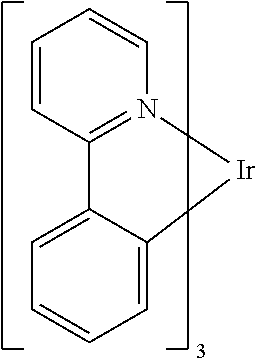
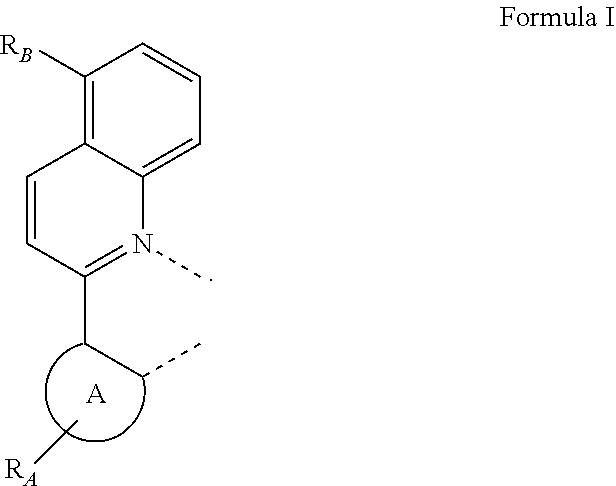
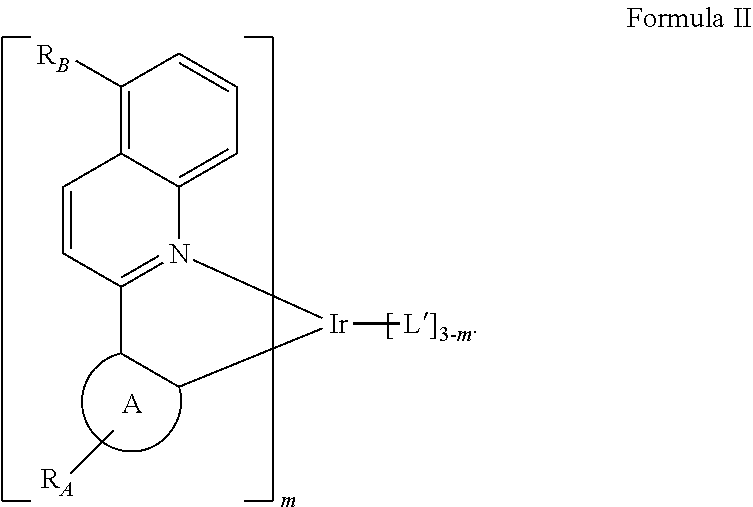
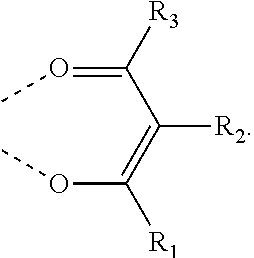
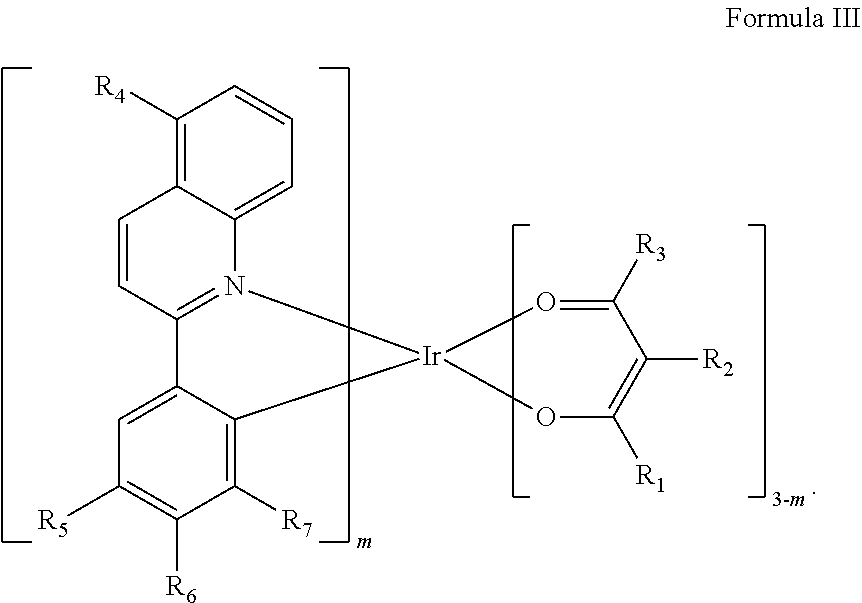
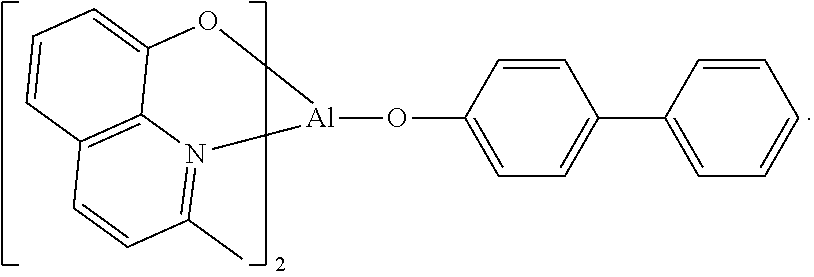
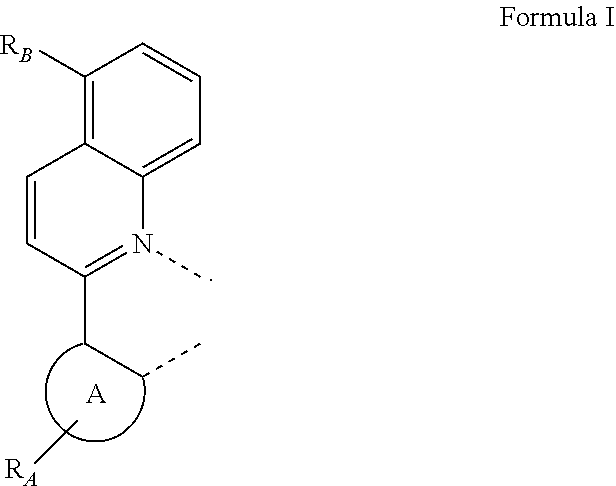
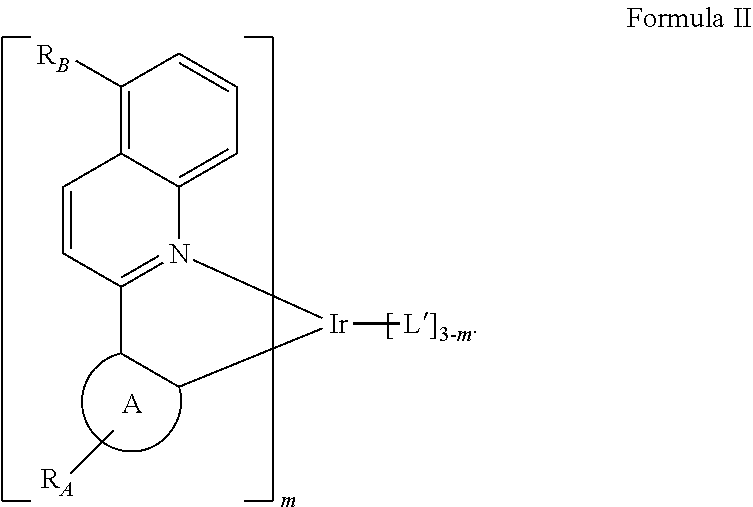
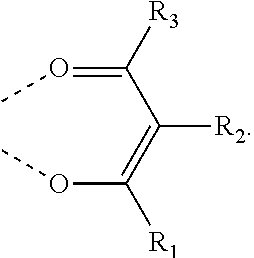
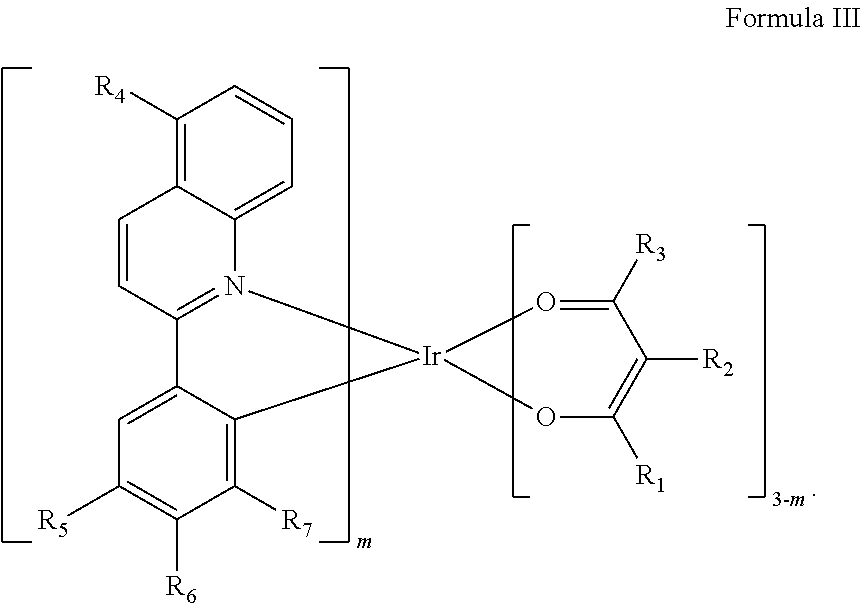


View All Diagrams
| United States Patent Application | 20200259107 |
| Kind Code | A1 |
| XIA; CHUANJUN ; et al. | August 13, 2020 |
ORGANIC ELECTROLUMINESCENT MATERIALS AND DEVICES
Abstract
Compounds are provided that comprise a ligand having a 5-substituted 2-phenylquinoline. In particular, the 2-phenylquinoline may be substituted with a cycloalkyl containing group at the 5-position. These compounds may be used in organic light emitting devices, in particular as red emitters in the emissive layer of such devices, to provide devices having improved properties.
| Inventors: | XIA; CHUANJUN; (Lawrenceville, NJ) ; Ma; Bin; (Plainsboro, NJ) ; Li; David Zanan; (Princeton, NJ) ; Alleyne; Bert; (Newtown, PA) ; Deangelis; Alan; (Pennington, NJ) ; Fiordeliso; James; (Yardley, PA) ; Adamovich; Vadim; (Yardley, PA) | ||||||||||
| Applicant: |
|
||||||||||
|---|---|---|---|---|---|---|---|---|---|---|---|
| Assignee: | Universal Display
Corporation Ewing NJ |
||||||||||
| Family ID: | 1000004786655 | ||||||||||
| Appl. No.: | 16/861655 | ||||||||||
| Filed: | April 29, 2020 |
Related U.S. Patent Documents
| Application Number | Filing Date | Patent Number | ||
|---|---|---|---|---|
| 15989854 | May 25, 2018 | 10680189 | ||
| 16861655 | ||||
| 13932546 | Jul 1, 2013 | 10008677 | ||
| 15989854 | ||||
| 13006016 | Jan 13, 2011 | 9130177 | ||
| 13932546 | ||||
| Current U.S. Class: | 1/1 |
| Current CPC Class: | H01L 51/0085 20130101; C07F 15/0033 20130101 |
| International Class: | H01L 51/00 20060101 H01L051/00; C07F 15/00 20060101 C07F015/00 |
Claims
1. A compound comprising a ligand L having the formula: ##STR00220## wherein A is a 5-membered or 6-membered carbocyclic or heterocyclic ring; wherein R.sub.A can represent mono, di, tri, or tetra substitutions; wherein each of R.sub.A is independently a hydrogen or a substituent selected from the group consisting of deuterium, alkyl, silyl, alkoxy, amino, alkenyl, alkynyl, arylkyl, aryl and heteroaryl; wherein R.sub.B is selected from the group consisting of alkyl having at least 2 carbon atoms, amino, alkenyl, alkynyl, arylkyl, and silyl; and wherein the ligand L is coordinated to a metal M having an atomic number greater than 40.
2. The compound of claim 1, wherein A is phenyl.
3. The compound of claim 1, wherein M is Ir.
4. The compound of claim 1, wherein the compound has the formula: ##STR00221## wherein L' is an ancillary ligand; and wherein m is 1, 2, or 3.
5. The compound of claim 4, wherein L' is a monoanionic bidentate ligand.
6. The compound of claim 4, wherein L' is ##STR00222## and wherein each of R.sub.1, R.sub.2, and R.sub.3 is independently a hydrogen or a substituent selected from the group consisting of deuterium, alkyl, alkoxy, amino, alkenyl, alkynyl, arylkyl, aryl and heteroaryl.
7. The compound of claim 4, wherein the compound has the formula: ##STR00223## wherein each R.sub.1, R.sub.2, R.sub.3, R.sub.5, R.sub.6 and R.sub.7 is independently a hydrogen or a substituent selected from the group consisting of deuterium, alkyl, silyl, alkoxy, amino, alkenyl, alkynyl, arylkyl, aryl and heteroaryl; wherein R.sub.4 is selected from the group consisting of alkyl having at least 2 carbon atoms, amino, alkenyl, alkynyl, arylkyl, and silyl; and wherein m is 1, 2, or 3.
8. The compound of claim 7, wherein each of R.sub.1 and R.sub.3 is a branched alkyl with branching at a position further than the .alpha. position to the carbonyl group.
9. The compound of claim 7, wherein each of R.sub.5, R.sub.6 and R.sub.7 is independently selected from methyl and hydrogen, and at least one of R.sub.5, R.sub.6 and R.sub.7 is methyl.
10. The compound of claim 7, wherein each of R.sub.5 and R.sub.7 is methyl, and R.sub.6 is hydrogen.
11. The compound of claim 7, wherein each of R.sub.5 and R.sub.6 is methyl, and R.sub.7 is hydrogen.
12. The compound of claim 7, wherein each of R.sub.5, R.sub.6 and R.sub.7 is methyl.
13. The compound of claim 1, wherein R.sub.4 is an alkyl group having at least 4 carbon atoms.
14. The compound of claim 1, wherein R.sub.4 is an alkyl group having at least 3 carbon atoms.
15. The compound of claim 1, wherein the compound is selected from the group consisting of: ##STR00224## ##STR00225## ##STR00226## ##STR00227## ##STR00228## ##STR00229## ##STR00230## ##STR00231## ##STR00232## ##STR00233## ##STR00234## ##STR00235## ##STR00236##
16. A first device comprising an organic light emitting device, comprising: an anode; a cathode; and an organic layer, disposed between the anode and the cathode, comprising a compound comprising a ligand L having the formula: ##STR00237## wherein A is a 5-membered or 6-membered carbocyclic or heterocyclic ring; wherein R.sub.A can represent mono, di, tri, or tetra substitutions; wherein each of R.sub.A is independently a hydrogen or a substituent selected from the group consisting of deuterium, alkyl, silyl, alkoxy, amino, alkenyl, alkynyl, arylkyl, aryl and heteroaryl; wherein R.sub.B is selected from the group consisting of alkyl having at least 2 carbon atoms, amino, alkenyl, alkynyl, arylkyl, and silyl; and wherein the ligand L is coordinated to a metal M having an atomic number greater than 40.
17. The first device of claim 16, wherein the compound is selected from the group consisting of: ##STR00238## ##STR00239## ##STR00240## ##STR00241## ##STR00242## ##STR00243## ##STR00244## ##STR00245## ##STR00246## ##STR00247## ##STR00248## ##STR00249## ##STR00250##
18. The first device of claim 16, wherein the organic layer is an emissive layer and the compound is an emissive dopant.
19. A consumer product comprising an organic light emitting device, comprising: an anode; a cathode; and an organic layer, disposed between the anode and the cathode, comprising a compound comprising a ligand L having the formula: ##STR00251## wherein A is a 5-membered or 6-membered carbocyclic or heterocyclic ring; wherein R.sub.A can represent mono, di, tri, or tetra substitutions; wherein each of R.sub.A is independently a hydrogen or a substituent selected from the group consisting of deuterium, alkyl, silyl, alkoxy, amino, alkenyl, alkynyl, arylkyl, aryl and heteroaryl; wherein R.sub.B is selected from the group consisting of alkyl having at least 2 carbon atoms, amino, alkenyl, alkynyl, arylkyl, and silyl; and wherein the ligand L is coordinated to a metal M having an atomic number greater than 40.
20. The consumer product of claim 19, wherein the consumer product is one of a flat panel display, a computer monitor, a television, a billboard, a light for interior or exterior illumination and/or signaling, a heads up display, a fully transparent display, a flexible display, a laser printer, a telephone, a cell phone, a personal digital assistant (PDA), a laptop computer, a digital camera, a camcorder, a viewfinder, a vehicle, a wall, theater or stadium screen, and a sign.
Description
CROSS-REFERENCE TO RELATED APPLICATIONS
[0001] This application is a continuation of U.S. patent application Ser. No. 15/989,854, filed May 25, 2018, which is a continuation of U.S. patent application Ser. No. 13/932,546, filed on Jul. 1, 2013, now U.S. Pat. No. 10,008,667, which is a continuation-in-part of U.S. patent application Ser. No. 13/006,016, filed on Jan. 13, 2011, now U.S. Pat. No. 9,130,177, the entire contents of which is incorporated herein by reference.
PARTIES TO A JOINT RESEARCH AGREEMENT
[0002] The claimed invention was made by, on behalf of, and/or in connection with one or more of the following parties to a joint university corporation research agreement: Regents of the University of Michigan, Princeton University, The University of Southern California, and the Universal Display Corporation. The agreement was in effect on and before the date the claimed invention was made, and the claimed invention was made as a result of activities undertaken within the scope of the agreement.
FIELD OF THE INVENTION
[0003] The present invention relates to organic light emitting devices (OLEDs). More specifically, the present invention is related to phosphorescent materials comprising a ligand having 2-phenylquinoline substituted with a cycloalkyl containing group at the 5-position. These materials may be used in OLEDs to provide devices having improved performance.
BACKGROUND
[0004] Opto-electronic devices that make use of organic materials are becoming increasingly desirable for a number of reasons. Many of the materials used to make such devices are relatively inexpensive, so organic opto-electronic devices have the potential for cost advantages over inorganic devices. In addition, the inherent properties of organic materials, such as their flexibility, may make them well suited for particular applications such as fabrication on a flexible substrate. Examples of organic opto-electronic devices include organic light emitting devices (OLEDs), organic phototransistors, organic photovoltaic cells, and organic photodetectors. For OLEDs, the organic materials may have performance advantages over conventional materials. For example, the wavelength at which an organic emissive layer emits light may generally be readily tuned with appropriate dopants.
[0005] OLEDs make use of thin organic films that emit light when voltage is applied across the device. OLEDs are becoming an increasingly interesting technology for use in applications such as flat panel displays, illumination, and backlighting. Several OLED materials and configurations are described in U.S. Pat. Nos. 5,844,363, 6,303,238, and 5,707,745, which are incorporated herein by reference in their entirety.
[0006] One application for phosphorescent emissive molecules is a full color display. Industry standards for such a display call for pixels adapted to emit particular colors, referred to as "saturated" colors. In particular, these standards call for saturated red, green, and blue pixels. Color may be measured using CIE coordinates, which are well known to the art.
[0007] One example of a green emissive molecule is tris(2-phenylpyridine) iridium, denoted Ir(ppy).sub.3, which has the structure:
##STR00001##
[0008] In this, and later figures herein, we depict the dative bond from nitrogen to metal (here, Ir) as a straight line.
[0009] As used herein, the term "organic" includes polymeric materials as well as small molecule organic materials that may be used to fabricate organic opto-electronic devices. "Small molecule" refers to any organic material that is not a polymer, and "small molecules" may actually be quite large. Small molecules may include repeat units in some circumstances. For example, using a long chain alkyl group as a substituent does not remove a molecule from the "small molecule" class. Small molecules may also be incorporated into polymers, for example as a pendent group on a polymer backbone or as a part of the backbone. Small molecules may also serve as the core moiety of a dendrimer, which consists of a series of chemical shells built on the core moiety. The core moiety of a dendrimer may be a fluorescent or phosphorescent small molecule emitter. A dendrimer may be a "small molecule," and it is believed that all dendrimers currently used in the field of OLEDs are small molecules.
[0010] As used herein, "top" means furthest away from the substrate, while "bottom" means closest to the substrate. Where a first layer is described as "disposed over" a second layer, the first layer is disposed further away from substrate. There may be other layers between the first and second layer, unless it is specified that the first layer is "in contact with" the second layer. For example, a cathode may be described as "disposed over" an anode, even though there are various organic layers in between.
[0011] As used herein, "solution processable" means capable of being dissolved, dispersed, or transported in and/or deposited from a liquid medium, either in solution or suspension form.
[0012] A ligand may be referred to as "photoactive" when it is believed that the ligand directly contributes to the photoactive properties of an emissive material. A ligand may be referred to as "ancillary" when it is believed that the ligand does not contribute to the photoactive properties of an emissive material, although an ancillary ligand may alter the properties of a photoactive ligand.
[0013] As used herein, and as would be generally understood by one skilled in the art, a first "Highest Occupied Molecular Orbital" (HOMO) or "Lowest Unoccupied Molecular Orbital" (LUMO) energy level is "greater than" or "higher than" a second HOMO or LUMO energy level if the first energy level is closer to the vacuum energy level. Since ionization potentials (IP) are measured as a negative energy relative to a vacuum level, a higher HOMO energy level corresponds to an IP having a smaller absolute value (an IP that is less negative). Similarly, a higher LUMO energy level corresponds to an electron affinity (EA) having a smaller absolute value (an EA that is less negative). On a conventional energy level diagram, with the vacuum level at the top, the LUMO energy level of a material is higher than the HOMO energy level of the same material. A "higher" HOMO or LUMO energy level appears closer to the top of such a diagram than a "lower" HOMO or LUMO energy level.
[0014] As used herein, and as would be generally understood by one skilled in the art, a first work function is "greater than" or "higher than" a second work function if the first work function has a higher absolute value. Because work functions are generally measured as negative numbers relative to vacuum level, this means that a "higher" work function is more negative. On a conventional energy level diagram, with the vacuum level at the top, a "higher" work function is illustrated as further away from the vacuum level in the downward direction. Thus, the definitions of HOMO and LUMO energy levels follow a different convention than work functions.
[0015] More details on OLEDs, and the definitions described above, can be found in U.S. Pat. No. 7,279,704, which is incorporated herein by reference in its entirety.
SUMMARY OF THE INVENTION
[0016] Compounds comprising a 5-substituted 2-phenylquinoline containing ligand are provided. The compounds comprise a ligand L having the formula:
##STR00002##
[0017] A is a 5-membered or 6-membered carbocyclic or heterocyclic ring. Preferably, A is phenyl. R.sub.A may represent mono, di, tri, or tetra substitutions. Each of R.sub.A is independently selected from the group consisting of hydrogen, deuterium, alkyl, silyl, alkoxy, amino, alkenyl, alkynyl, arylkyl, aryl and heteroaryl. R.sub.B is selected from the group consisting of alkyl having at least 2 carbon atoms, amino, alkenyl, alkynyl, arylkyl, and silyl. The ligand L is coordinated to a metal M having an atomic number greater than 40. Preferably, M is Ir.
[0018] In one aspect, the compound has the formula:
##STR00003##
[0019] L' is an ancillary ligand. m is 1, 2, or 3.
[0020] In another aspect, L' is a monoanionic bidentate ligand. In yet another aspect, L' is
##STR00004##
[0021] R.sub.1, R.sub.2, and R.sub.3 are independently selected from the group consisting of hydrogen, deuterium, alkyl, alkoxy, amino, alkenyl, alkynyl, arylkyl, aryl and heteroaryl.
[0022] In one aspect, the compound has the formula:
##STR00005##
wherein R.sub.1, R.sub.2, R.sub.3, R.sub.5, R.sub.6 and R.sub.7 are independently selected from the group consisting of hydrogen, deuterium, alkyl, silyl, alkoxy, amino, alkenyl, alkynyl, arylkyl, aryl and heteroaryl. R.sub.4 is selected from the group consisting of alkyl having at least 2 carbon atoms, amino, alkenyl, alkynyl, arylkyl, and silyl. m is 1, 2, or 3. Preferably, each of R.sub.1 and R.sub.3 are a branched alkyl with branching at a position further than the .alpha. position to the carbonyl group.
[0023] In one aspect, each of R.sub.5, R.sub.6 and R.sub.7 are independently selected from methyl and hydrogen, and at least one of R.sub.5, R.sub.6 and R.sub.7 is methyl. In another aspect, each of R.sub.5 and R.sub.7 are methyl, and R.sub.6 is hydrogen. In yet another aspect, each of R.sub.5 and R.sub.6 are methyl, and R.sub.7 is hydrogen. In a further aspect, each of R.sub.5, R.sub.6 and R.sub.7 are methyl.
[0024] In one aspect, R.sub.4 is an alkyl group having at least 4 carbon atoms. In another aspect, R.sub.4 is an alkyl group having at least 3 carbon atoms.
[0025] Specific, non-limiting examples of the 5-substituted 2-phenylquinoline containing compounds are provided. In one aspect, the compound is selected from the group consisting of Compound 1-Compound 50.
[0026] In one aspect, R.sub.4 comprises a cycloalkyl group having at least 4 carbon atoms. Specific, non-limiting examples of the 5-substituted 2-phenylquinoline containing compound having Formula III wherein R.sub.4 comprises a cycloalkyl group having at least 4 carbon atoms is selected from the group consisting of Compound II-1-Compound II-72.
[0027] Additionally, a first device comprising an organic light emitting device is provided. The organic light emitting device further comprises an anode, a cathode; and an organic layer, disposed between the anode and the cathode. The organic layer comprises a compound comprising a ligand L having Formula I.
[0028] A is a 5-membered or 6-membered carbocyclic or heterocyclic ring. Preferably, A is phenyl. R.sub.A may represent mono, di, tri, or tetra substitutions. Each of R.sub.A is independently selected from the group consisting of hydrogen, alkyl, alkoxy, amino, alkenyl, alkynyl, arylkyl, aryl and heteroaryl. R.sub.B is selected from the group consisting of alkyl having at least 2 carbon atoms, amino, alkenyl, alkynyl, arylkyl, and silyl. The ligand L is coordinated to a metal M having an atomic number greater than 40. Preferably, M is Ir.
[0029] Specific, non-limiting examples of devices comprising the compounds are provided. In one aspect, the compound used in the first device is selected from the group consisting of Compound 1-Compound 50.
[0030] The various specific aspects discussed above for compounds comprising a ligand L having Formula I are also applicable to a compound comprising a ligand L having Formula I that is used in the first device. In particular, specific aspects of R.sub.A, R.sub.B, A, L', M, m, R.sub.1, R.sub.2, R.sub.3, R.sub.4, R.sub.5, R.sub.6, and R.sub.7 of the compound comprising a ligand L having Formula I discussed above are also applicable to a compound comprising a ligand L having Formula I that is used in a the first device.
[0031] In one aspect, the organic layer is an emissive layer and the compound is an emissive dopant. In another aspect, the organic layer further comprises a host. In yet another aspect, the host is a metal 8-hydroxyquinolate. Preferably, the host is:
##STR00006##
[0032] In one aspect, the first device is a consumer product. In another aspect, the first device is an organic light emitting device.
BRIEF DESCRIPTION OF THE DRAWINGS
[0033] FIG. 1 shows an organic light emitting device.
[0034] FIG. 2 shows an inverted organic light emitting device that does not have a separate electron transport layer.
[0035] FIG. 3 shows an exemplary compound comprising a 5-substituted 2-phenylquinoline ligand (top) and a preferred embodiment of the 5-substituted 2-phenylquinolone compound (bottom).
DETAILED DESCRIPTION
[0036] Generally, an OLED comprises at least one organic layer disposed between and electrically connected to an anode and a cathode. When a current is applied, the anode injects holes and the cathode injects electrons into the organic layer(s). The injected holes and electrons each migrate toward the oppositely charged electrode. When an electron and hole localize on the same molecule, an "exciton," which is a localized electron-hole pair having an excited energy state, is formed. Light is emitted when the exciton relaxes via a photoemissive mechanism. In some cases, the exciton may be localized on an excimer or an exciplex. Non-radiative mechanisms, such as thermal relaxation, may also occur, but are generally considered undesirable.
[0037] The initial OLEDs used emissive molecules that emitted light from their singlet states ("fluorescence") as disclosed, for example, in U.S. Pat. No. 4,769,292, which is incorporated by reference in its entirety. Fluorescent emission generally occurs in a time frame of less than 10 nanoseconds.
[0038] More recently, OLEDs having emissive materials that emit light from triplet states ("phosphorescence") have been demonstrated. Baldo et al., "Highly Efficient Phosphorescent Emission from Organic Electroluminescent Devices," Nature, vol. 395, 151-154, 1998; ("Baldo-I") and Baldo et al., "Very high-efficiency green organic light-emitting devices based on electrophosphorescence," Appl. Phys. Lett., vol. 75, No. 3, 4-6 (1999) ("Baldo-II"), which are incorporated by reference in their entireties. Phosphorescence is described in more detail in U.S. Pat. No. 7,279,704 at cols. 5-6, which are incorporated by reference.
[0039] FIG. 1 shows an organic light emitting device 100. The figures are not necessarily drawn to scale. Device 100 may include a substrate 110, an anode 115, a hole injection layer 120, a hole transport layer 125, an electron blocking layer 130, an emissive layer 135, a hole blocking layer 140, an electron transport layer 145, an electron injection layer 150, a protective layer 155, and a cathode 160. Cathode 160 is a compound cathode having a first conductive layer 162 and a second conductive layer 164. Device 100 may be fabricated by depositing the layers described, in order. The properties and functions of these various layers, as well as example materials, are described in more detail in U.S. Pat. No. 7,279,704 at cols. 6-10, which are incorporated by reference.
[0040] More examples for each of these layers are available. For example, a flexible and transparent substrate-anode combination is disclosed in U.S. Pat. No. 5,844,363, which is incorporated by reference in its entirety. An example of a p-doped hole transport layer is m-MTDATA doped with F.sub.4-TCNQ at a molar ratio of 50:1, as disclosed in U.S. Patent Application Publication No. 2003/0230980, which is incorporated by reference in its entirety. Examples of emissive and host materials are disclosed in U.S. Pat. No. 6,303,238 to Thompson et al., which is incorporated by reference in its entirety. An example of an n-doped electron transport layer is BPhen doped with Li at a molar ratio of 1:1, as disclosed in U.S. Patent Application Publication No. 2003/0230980, which is incorporated by reference in its entirety. U.S. Pat. Nos. 5,703,436 and 5,707,745, which are incorporated by reference in their entireties, disclose examples of cathodes including compound cathodes having a thin layer of metal such as Mg:Ag with an overlying transparent, electrically-conductive, sputter-deposited ITO layer. The theory and use of blocking layers is described in more detail in U.S. Pat. No. 6,097,147 and U.S. Patent Application Publication No. 2003/0230980, which are incorporated by reference in their entireties. Examples of injection layers are provided in U.S. Patent Application Publication No. 2004/0174116, which is incorporated by reference in its entirety. A description of protective layers may be found in U.S. Patent Application Publication No. 2004/0174116, which is incorporated by reference in its entirety.
[0041] FIG. 2 shows an inverted OLED 200. The device includes a substrate 210, a cathode 215, an emissive layer 220, a hole transport layer 225, and an anode 230. Device 200 may be fabricated by depositing the layers described, in order. Because the most common OLED configuration has a cathode disposed over the anode, and device 200 has cathode 215 disposed under anode 230, device 200 may be referred to as an "inverted" OLED. Materials similar to those described with respect to device 100 may be used in the corresponding layers of device 200. FIG. 2 provides one example of how some layers may be omitted from the structure of device 100.
[0042] The simple layered structure illustrated in FIGS. 1 and 2 is provided by way of non-limiting example, and it is understood that embodiments of the invention may be used in connection with a wide variety of other structures. The specific materials and structures described are exemplary in nature, and other materials and structures may be used. Functional OLEDs may be achieved by combining the various layers described in different ways, or layers may be omitted entirely, based on design, performance, and cost factors. Other layers not specifically described may also be included. Materials other than those specifically described may be used. Although many of the examples provided herein describe various layers as comprising a single material, it is understood that combinations of materials, such as a mixture of host and dopant, or more generally a mixture, may be used. Also, the layers may have various sublayers. The names given to the various layers herein are not intended to be strictly limiting. For example, in device 200, hole transport layer 225 transports holes and injects holes into emissive layer 220, and may be described as a hole transport layer or a hole injection layer. In one embodiment, an OLED may be described as having an "organic layer" disposed between a cathode and an anode. This organic layer may comprise a single layer, or may further comprise multiple layers of different organic materials as described, for example, with respect to FIGS. 1 and 2.
[0043] Structures and materials not specifically described may also be used, such as OLEDs comprised of polymeric materials (PLEDs) such as disclosed in U.S. Pat. No. 5,247,190 to Friend et al., which is incorporated by reference in its entirety. By way of further example, OLEDs having a single organic layer may be used. OLEDs may be stacked, for example as described in U.S. Pat. No. 5,707,745 to Forrest et al, which is incorporated by reference in its entirety. The OLED structure may deviate from the simple layered structure illustrated in FIGS. 1 and 2. For example, the substrate may include an angled reflective surface to improve out-coupling, such as a mesa structure as described in U.S. Pat. No. 6,091,195 to Forrest et al., and/or a pit structure as described in U.S. Pat. No. 5,834,893 to Bulovic et al., which are incorporated by reference in their entireties.
[0044] Unless otherwise specified, any of the layers of the various embodiments may be deposited by any suitable method. For the organic layers, preferred methods include thermal evaporation, ink-jet, such as described in U.S. Pat. Nos. 6,013,982 and 6,087,196, which are incorporated by reference in their entireties, organic vapor phase deposition (OVPD), such as described in U.S. Pat. No. 6,337,102 to Forrest et al., which is incorporated by reference in its entirety, and deposition by organic vapor jet printing (OVJP), such as described in U.S. patent application Ser. No. 10/233,470, which is incorporated by reference in its entirety. Other suitable deposition methods include spin coating and other solution based processes. Solution based processes are preferably carried out in nitrogen or an inert atmosphere. For the other layers, preferred methods include thermal evaporation. Preferred patterning methods include deposition through a mask, cold welding such as described in U.S. Pat. Nos. 6,294,398 and 6,468,819, which are incorporated by reference in their entireties, and patterning associated with some of the deposition methods such as ink-jet and OVJD. Other methods may also be used. The materials to be deposited may be modified to make them compatible with a particular deposition method. For example, substituents such as alkyl and aryl groups, branched or unbranched, and preferably containing at least 3 carbons, may be used in small molecules to enhance their ability to undergo solution processing. Substituents having 20 carbons or more may be used, and 3-20 carbons is a preferred range. Materials with asymmetric structures may have better solution processability than those having symmetric structures, because asymmetric materials may have a lower tendency to recrystallize. Dendrimer substituents may be used to enhance the ability of small molecules to undergo solution processing.
[0045] Devices fabricated in accordance with embodiments of the invention may be incorporated into a wide variety of consumer products, including flat panel displays, computer monitors, televisions, billboards, lights for interior or exterior illumination and/or signaling, heads up displays, fully transparent displays, flexible displays, laser printers, telephones, cell phones, personal digital assistants (PDAs), laptop computers, digital cameras, camcorders, viewfinders, micro-displays, vehicles, a large area wall, theater or stadium screen, or a sign. Various control mechanisms may be used to control devices fabricated in accordance with the present invention, including passive matrix and active matrix. Many of the devices are intended for use in a temperature range comfortable to humans, such as 18 degrees C. to 30 degrees C., and more preferably at room temperature (20-25 degrees C.).
[0046] The materials and structures described herein may have applications in devices other than OLEDs. For example, other optoelectronic devices such as organic solar cells and organic photodetectors may employ the materials and structures. More generally, organic devices, such as organic transistors, may employ the materials and structures.
[0047] The terms halo, halogen, alkyl, cycloalkyl, alkenyl, alkynyl, arylkyl, heterocyclic group, aryl, aromatic group, and heteroaryl are known to the art, and are defined in U.S. Pat. No. 7,279,704 at cols. 31-32, which are incorporated herein by reference.
[0048] Novel organometallic 2-phenylquinoline Ir complexes are provided. In particular, the compounds comprise an alkyl having at least 2 carbon atoms. It is believed that compounds containing a bulky alkyl at the 5-position on the phenylquinoline is novel. In addition, it is believed that the presence of a bulky alkyl at the 5-position may increase efficiency by preventing self-quenching. Notably, placing the bulky alkyl at the 5-position on the 2-phenylquinoline does not shift the emission wavelength or change the color. Therefore, these compounds may provide improved efficiency and maintain saturated red emission. These compounds may be useful in organic light emitting devices, in particular as red emitters in the emissive layer of such devices.
[0049] Compounds comprising a 5-substituted 2-phenylquinoline containing ligand are provided. The compounds comprise a ligand L having the formula:
##STR00007##
[0050] A is a 5-membered or 6-membered carbocyclic or heterocyclic ring. Preferably, A is phenyl. R.sub.A may represent mono, di, tri, or tetra substitutions. Each of R.sub.A is independently selected from the group consisting of hydrogen, deuterium, alkyl, silyl, alkoxy, amino, alkenyl, alkynyl, arylkyl, aryl and heteroaryl. These compounds may be fully or partially deuterated. R.sub.B is selected from the group consisting of alkyl having at least 2 carbon atoms, amino, alkenyl, alkynyl, arylkyl, and silyl. The ligand L is coordinated to a metal M having an atomic number greater than 40. Preferably, M is Ir.
[0051] In one aspect, the compound has the formula:
##STR00008##
[0052] L' is an ancillary ligand. m is 1, 2, or 3.
[0053] In another aspect, L' is a monoanionic bidentate ligand. In yet another aspect, L' is
##STR00009##
[0054] R.sub.1, R.sub.2, and R.sub.3 are independently selected from the group consisting of hydrogen, deuterium, alkyl, alkoxy, amino, alkenyl, alkynyl, arylkyl, aryl and heteroaryl.
[0055] In one aspect, the compound has the formula:
##STR00010##
[0056] R.sub.1, R.sub.2, R.sub.3, R.sub.5, R.sub.6 and R.sub.7 are independently selected from the group consisting of hydrogen, deuterium, alkyl, silyl, alkoxy, amino, alkenyl, alkynyl, arylkyl, aryl and heteroaryl. R.sub.4 is selected from the group consisting of alkyl having at least 2 carbon atoms, amino, alkenyl, alkynyl, arylkyl, and silyl. m is 1, 2, or 3.
[0057] Preferably, each of R.sub.1 and R.sub.3 are a branched alkyl with branching at a position further than the .alpha. position to the carbonyl group. Without being bound by theory, it is believed that a branched alkyl substituent at R.sub.1 and R.sub.3 may provide high device efficiency and stability, and a very narrow emission spectrum.
[0058] The placement of substituents on the compound having Formula III may improve efficiency while maintaining a desirable spectrum. In particular, it is believed that substitution on the position ortho to the R.sub.5 next to quinoline with a substituent other than hydrogen, as shown in Formula III, may result in broadening the compound's spectrum. In addition, alkyl substitution on quinoline at the 3-position may broaden the emission spectrum. Alkyl substitution at the 4, 6, or 7-position may slightly blue shift the emission spectrum, thereby making the emission less saturated. Therefore, the substitution pattern of the 5-substituted 2-phenylquinoline compounds described herein may provide highly desirable compound and device characteristics.
[0059] In one aspect, each of R.sub.5, R.sub.6 and R.sub.7 are independently selected from methyl and hydrogen, and at least one of R.sub.5, R.sub.6 and R.sub.7 is methyl. In another aspect, each of R.sub.5 and R.sub.7 are methyl, and R.sub.6 is hydrogen. In yet another aspect, each of R.sub.5 and R.sub.6 are methyl, and R.sub.7 is hydrogen. In a further aspect, each of R.sub.5, R.sub.6 and R.sub.7 are methyl.
[0060] In one aspect, R.sub.4 is an alkyl group having at least 4 carbon atoms. In another aspect, R.sub.4 is an alkyl group having at least 3 carbon atoms.
[0061] Alkyl substitutions may be particularly important because they offer a wide range of tunability in terms of evaporation temperature, solubility, energy levels, device efficiency and narrowness of the emission spectrum. Additionally, alkyl groups can be stable functional groups chemically and in device operation.
[0062] Specific, non-limiting examples of the 5-substituted 2-phenylquinoline containing compounds are provided. In one aspect, the compound is selected from the group consisting of:
##STR00011## ##STR00012## ##STR00013## ##STR00014## ##STR00015## ##STR00016## ##STR00017## ##STR00018## ##STR00019## ##STR00020## ##STR00021## ##STR00022## ##STR00023##
[0063] In another aspect, R.sub.4 in compound having Formula III comprises a cycloalkyl group having at least 4 carbon atoms. The inventors have discovered that provision of cycloalkyl substituent at 5-position of the 2-phenylquinoline provides further improvement in the phosphorescent characteristics of the compound over linear or branched alkyl group substituents. This improved compound is suitable as red emitters in Phosphorescent OLEDs. Specific, non-limiting examples of the 5-substituted 2-phenylquinoline containing compound having Formula III wherein R.sub.4 comprises a cycloalkyl group having at least 4 carbon atoms is selected from the group consisting of Compound II-1-Compound II-72 shown below. In another aspect, R.sub.4 is a cyloalkyl. In one embodiment, R.sub.4 is a cyclopentyl or cyclohexyl.
##STR00024## ##STR00025## ##STR00026## ##STR00027## ##STR00028## ##STR00029## ##STR00030## ##STR00031## ##STR00032## ##STR00033## ##STR00034## ##STR00035## ##STR00036## ##STR00037## ##STR00038## ##STR00039## ##STR00040## ##STR00041## ##STR00042## ##STR00043##
[0064] Additionally, a first device comprising an organic light emitting device is provided. The organic light emitting device further comprises an anode, a cathode, and an organic layer, disposed between the anode and the cathode. The organic layer comprises a compound comprising a ligand L having the formula:
##STR00044##
[0065] A is a 5-membered or 6-membered carbocyclic or heterocyclic ring. Preferably, A is phenyl. R.sub.A may represent mono, di, tri, or tetra substitutions. Each of R.sub.A is independently selected from the group consisting of hydrogen, deuterium, alkyl, silyl, alkoxy, amino, alkenyl, alkynyl, arylkyl, aryl and heteroaryl. R.sub.B is selected from the group consisting of alkyl having at least 2 carbon atoms, amino, alkenyl, alkynyl, arylkyl, and silyl. The ligand L is coordinated to a metal M having an atomic number greater than 40. Preferably, M is Ir.
[0066] In one aspect, the compound has the formula:
##STR00045##
[0067] L' is an ancillary ligand. m is 1, 2, or 3.
[0068] In one aspect, L' is a monoanionic bidentate ligand. In another aspect, L' is
##STR00046##
[0069] R.sub.1, R.sub.2, and R.sub.3 are independently selected from the group consisting of hydrogen, deuterium, alkyl, alkoxy, amino, alkenyl, alkynyl, arylkyl, aryl and heteroaryl.
[0070] In one aspect, the compound has the formula:
##STR00047##
[0071] R.sub.1, R.sub.2, R.sub.3, R.sub.5, R.sub.6 and R.sub.7 are independently selected from the group consisting of hydrogen, deuterium, alkyl, silyl, alkoxy, amino, alkenyl, alkynyl, arylkyl, aryl and heteroaryl. R.sub.4 is selected from the group consisting of alkyl having at least 2 carbon atoms, amino, alkenyl, alkynyl, arylkyl, and silyl. m is 1, 2, or 3.
[0072] Specific, non-limiting examples of devices comprising the compounds are provided. In one aspect, the first device comprises a compound selected from the group consisting of Compound 1-Compound 50.
[0073] In another aspect, the organic layer comprises a compound having Formula III wherein R.sub.4 is a cycloalkyl group having at least 4 carbon atoms. Specific, non-limiting examples of the compound having Formula III wherein R.sub.4 is a cycloalkyl group having at least 4 carbon atoms is selected from the group consisting of Compound II-1-Compound II-72 disclosed herein.
[0074] In one aspect, the organic layer is an emissive layer and the compound is an emissive dopant. In another aspect, the organic layer further comprises a host. In yet another aspect, the host is a metal 8-hydroxyquinolate. Preferably, the host is:
##STR00048##
[0075] In one aspect, the first device is a consumer product. In another aspect, the first device is an organic light emitting device.
Combination with Other Materials
[0076] The materials described herein as useful for a particular layer in an organic light emitting device may be used in combination with a wide variety of other materials present in the device. For example, emissive dopants disclosed herein may be used in conjunction with a wide variety of hosts, transport layers, blocking layers, injection layers, electrodes and other layers that may be present. The materials described or referred to below are non-limiting examples of materials that may be useful in combination with the compounds disclosed herein, and one of skill in the art can readily consult the literature to identify other materials that may be useful in combination.
HIL/HTL:
[0077] A hole injecting/transporting material to be used in embodiments of the present invention is not particularly limited, and any compound may be used as long as the compound is typically used as a hole injecting/transporting material. Examples of the material include, but are not limited to: a phthalocyanine or porphyrin derivative; an aromatic amine derivative; an indolocarbazole derivative; a polymer containing fluorohydrocarbon; a polymer with conductivity dopants; a conducting polymer, such as PEDOT/PSS; a self-assembly monomer derived from compounds such as phosphonic acid and silane derivatives; a metal oxide derivative, such as MoO.sub.x; a p-type semiconducting organic compound, such as 1,4,5,8,9,12-Hexaazatriphenylenehexacarbonitrile; a metal complex, and a cross-linkable compounds.
[0078] Examples of aromatic amine derivatives used in the HIL or HTL include, but are not limited to, the following general structures:
##STR00049##
[0079] Each of Ar.sup.1 to Ar.sup.9 is selected from the group consisting aromatic hydrocarbon cyclic compounds such as benzene, biphenyl, triphenyl, triphenylene, naphthalene, anthracene, phenalene, phenanthrene, fluorene, pyrene, chrysene, perylene, azulene; group consisting aromatic heterocyclic compounds such as dibenzothiophene, dibenzofuran, dibenzoselenophene, furan, thiophene, benzofuran, benzothiophene, benzoselenophene, carbazole, indolocarbazole, pyridylindole, pyrrolodipyridine, pyrazole, imidazole, triazole, oxazole, thiazole, oxadiazole, oxatriazole, dioxazole, thiadiazole, pyridine, pyridazine, pyrimidine, pyrazine, triazine, oxazine, oxathiazine, oxadiazine, indole, benzimidazole, indazole, indoxazine, benzoxazole, benzisoxazole, benzothiazole, quinoline, isoquinoline, cinnoline, quinazoline, quinoxaline, naphthyridine, phthalazine, pteridine, xanthene, acridine, phenazine, phenothiazine, phenoxazine, benzofuropyridine, furodipyridine, benzothienopyridine, thienodipyridine, benzoselenophenopyridine, and selenophenodipyridine; and group consisting 2 to 10 cyclic structural units which are groups of the same type or different types selected from the aromatic hydrocarbon cyclic group and the aromatic heterocyclic group and are bonded to each other directly or via at least one of oxygen atom, nitrogen atom, sulfur atom, silicon atom, phosphorus atom, boron atom, chain structural unit and the aliphatic cyclic group. Wherein each Ar is further substituted by a substituent selected from the group consisting of hydrogen, deuterium, alkyl, alkoxy, amino, alkenyl, alkynyl, arylalkyl, heteroalkyl, aryl and heteroaryl.
[0080] In one aspect, Ar.sup.1 to Ar.sup.9 is independently selected from the group consisting of:
##STR00050##
[0081] k is an integer from 1 to 20; X.sup.1 to X.sup.8 is CH or N; Ar.sup.1 has the same group defined above.
[0082] Examples of metal complexes used in the HIL or HTL include, but are not limited to, the following general formula:
##STR00051##
[0083] M is a metal, having an atomic weight greater than 40; (Y.sup.1-Y.sup.2) is a bidentate ligand, Y.sup.1 and Y.sup.2 are independently selected from C, N, O, P, and S; L is an ancillary ligand; m is an integer value from 1 to the maximum number of ligands that may be attached to the metal; and m+n is the maximum number of ligands that may be attached to the metal.
[0084] In one aspect, (Y.sup.1-Y.sup.2) is a 2-phenylpyridine derivative.
[0085] In another aspect, (Y.sup.1-Y.sup.2) is a carbene ligand.
[0086] In another aspect, M is selected from Ir, Pt, Os, and Zn.
[0087] In a further aspect, the metal complex has a smallest oxidation potential in solution vs. Fc.sup.+/Fc couple less than about 0.6 V.
Host:
[0088] The light emitting layer of the organic EL device in some embodiments the present invention preferably contains at least a metal complex as light emitting material, and may contain a host material using the metal complex as a dopant material. Examples of the host material are not particularly limited, and any metal complexes or organic compounds may be used as long as the triplet energy of the host is larger than that of the dopant.
[0089] Examples of metal complexes used as hosts are preferred to have the following general formula:
##STR00052##
[0090] M is a metal; (Y.sup.3-Y.sup.4) is a bidentate ligand, Y.sup.3 and Y.sup.4 are independently selected from C, N, O, P, and S; L is an ancillary ligand; m is an integer value from 1 to the maximum number of ligands that may be attached to the metal; and m+n is the maximum number of ligands that may be attached to the metal.
[0091] In one aspect, the metal complexes are:
##STR00053##
[0092] (O--N) is a bidentate ligand, having metal coordinated to atoms O and N.
[0093] In another aspect, M is selected from Ir and Pt.
[0094] In a further aspect, (Y.sup.3-Y.sup.4) is a carbene ligand.
[0095] Examples of organic compounds used as hosts are selected from the group consisting aromatic hydrocarbon cyclic compounds such as benzene, biphenyl, triphenyl, triphenylene, naphthalene, anthracene, phenalene, phenanthrene, fluorene, pyrene, chrysene, perylene, azulene; group consisting aromatic heterocyclic compounds such as dibenzothiophene, dibenzofuran, dibenzoselenophene, furan, thiophene, benzofuran, benzothiophene, benzoselenophene, carbazole, indolocarbazole, pyridylindole, pyrrolodipyridine, pyrazole, imidazole, triazole, oxazole, thiazole, oxadiazole, oxatriazole, dioxazole, thiadiazole, pyridine, pyridazine, pyrimidine, pyrazine, triazine, oxazine, oxathiazine, oxadiazine, indole, benzimidazole, indazole, indoxazine, benzoxazole, benzisoxazole, benzothiazole, quinoline, isoquinoline, cinnoline, quinazoline, quinoxaline, naphthyridine, phthalazine, pteridine, xanthene, acridine, phenazine, phenothiazine, phenoxazine, benzofuropyridine, furodipyridine, benzothienopyridine, thienodipyridine, benzoselenophenopyridine, and selenophenodipyridine; and group consisting 2 to 10 cyclic structural units which are groups of the same type or different types selected from the aromatic hydrocarbon cyclic group and the aromatic heterocyclic group and are bonded to each other directly or via at least one of oxygen atom, nitrogen atom, sulfur atom, silicon atom, phosphorus atom, boron atom, chain structural unit and the aliphatic cyclic group. Wherein each group is further substituted by a substituent selected from the group consisting of hydrogen, deuterium, alkyl, alkoxy, amino, alkenyl, alkynyl, arylalkyl, heteroalkyl, aryl and heteroaryl.
[0096] In one aspect, the host compound contains at least one of the following groups in the molecule:
##STR00054## ##STR00055##
[0097] R.sup.1 to R.sup.7 is independently selected from the group consisting of hydrogen, deuterium, alkyl, alkoxy, amino, alkenyl, alkynyl, arylalkyl, heteroalkyl, aryl and heteroaryl, when it is aryl or heteroaryl, it has the similar definition as Ar's mentioned above.
[0098] k is an integer from 0 to 20.
[0099] X.sup.1 to X.sup.8 is selected from CH or N.
HBL:
[0100] A hole blocking layer (HBL) may be used to reduce the number of holes and/or excitons that leave the emissive layer. The presence of such a blocking layer in a device may result in substantially higher efficiencies as compared to a similar device lacking a blocking layer. Also, a blocking layer may be used to confine emission to a desired region of an OLED.
[0101] In one aspect, the compound used in the HBL contains the same molecule used as host described above.
[0102] In another aspect, the compound used in the HBL contains at least one of the following groups in the molecule:
##STR00056##
[0103] k is an integer from 0 to 20; L is an ancillary ligand, m is an integer from 1 to 3.
ETL:
[0104] Electron transport layer (ETL) may include a material capable of transporting electrons. Electron transport layer may be intrinsic (undoped), or doped. Doping may be used to enhance conductivity. Examples of the ETL material are not particularly limited, and any metal complexes or organic compounds may be used as long as they are typically used to transport electrons.
[0105] In one aspect, the compound used in the ETL contains at least one of the following groups in the molecule:
##STR00057##
[0106] R.sup.1 is selected from the group consisting of hydrogen, deuterium, alkyl, alkoxy, amino, alkenyl, alkynyl, arylalkyl, heteroalkyl, aryl and heteroaryl, when it is aryl or heteroaryl, it has the similar definition as Ar's mentioned above.
[0107] Ar.sup.1 to Ar.sup.3 has the similar definition as Ar's mentioned above.
[0108] k is an integer from 0 to 20.
[0109] X.sup.1 to X.sup.8 is selected from CH or N.
[0110] In another aspect, the metal complexes used in the ETL contain, but are not limited to, the following general formula:
##STR00058##
[0111] (O--N) or (N--N) is a bidentate ligand, having metal coordinated to atoms O, N or N, N; L is an ancillary ligand; m is an integer value from 1 to the maximum number of ligands that may be attached to the metal.
[0112] In any above-mentioned compounds used in each layer of OLED device, the hydrogen atoms can be partially or fully deuterated.
[0113] In addition to and/or in combination with the materials disclosed herein, many hole injection materials, hole transporting materials, host materials, dopant materials, exciton/hole blocking layer materials, electron transporting and electron injecting materials may be used in an OLED. Non-limiting examples of the materials that may be used in an OLED in combination with materials disclosed herein are listed in Table 1 below. Table 1 lists non-limiting classes of materials, non-limiting examples of compounds for each class, and references that disclose the materials.
TABLE-US-00001 TABLE 1 MATERIAL EXAMPLES OF MATERIAL PUBLICATIONS Hole injection materials Phthalocyanine and porphyrin compounds ##STR00059## Appl. Phys. Lett. 69, 2160 (1996) Starburst triarylamine ##STR00060## J. Lumn. 72-74, 985 (1997) CF.sub.x Fluoro- hydrocarbon polymer ##STR00061## Appl. Phys. Lett. 78, 673 (2001) Conducting polymers (e.g., PEDOT:PSS, polyaniline, polypthiophene) ##STR00062## Synth. Met. 87, 171 (1997) WO2007002683 Phosphonic acid and silane SAMs ##STR00063## US20030162053 Triarylamine or polythiophene polymers with conductivity dopants ##STR00064## EA01725079A1 ##STR00065## ##STR00066## Arylamine complexed with metal oxides such as molybdenum and tungsten oxides ##STR00067## SID Symposium Digest, 37, 923 (2006) WO2009018009 Semiconducting organic complexes ##STR00068## US20020158242 Metal organometallic complexes ##STR00069## US20060240279 Cross-linkable compounds ##STR00070## US20080220265 Hole transporting materials Triarylamines (e.g., TPD, .quadrature.-NPD) ##STR00071## Appl. Phys. Lett. 51, 913 (1987) ##STR00072## U.S. Pat. No. 5,061,569 ##STR00073## EP650955 ##STR00074## J. Mater. Chem. 3, 319 (1993) ##STR00075## Appl. Phys. Lett. 90, 183503 (2007) ##STR00076## Appl. Phys. Lett. 90, 183503 (2007) Triaylamine on spirofluorene core ##STR00077## Synth. Met. 91, 209 (1997) Arylamine carbazole compounds ##STR00078## Adv. Mater. 6, 677 (1994), US20080124572 Triarylamine with (di)benzo- thiophene/ (di)benzofuran ##STR00079## US20070278938, US20080106190 Indolcarbazoles ##STR00080## Synth. Met. 111, 421 (2000) Isoindole compounds ##STR00081## Chem. Mater. 15, 3148 (2003) Metal carbene complexes ##STR00082## US20080018221 Phosphorescent OLED host materials Red hosts Arylcarbazoles ##STR00083## Appl. Phys. Lett. 78, 1622 (2001) Metal 8- hydroxyquinolates (e.g., Alq.sub.3, BAlq) ##STR00084## Nature 395, 151 (1998) ##STR00085## US20060202194 ##STR00086## WO2005014551 ##STR00087## WO2006072002 Metal phenoxy- benzothiazole compounds ##STR00088## Appl. Phys. Lett. 90, 123509 (2007) Conjugated oligomers and polymers (e.g., polyfluorene) ##STR00089## Org. Electron. 1, 15 (2000) Aromatic fused rings ##STR00090## WO2009066779, WO2009066778, WO2009063833, US20090045731, US20090045730, WO2009008311, US20090008605, US20090009065 Zinc complexes ##STR00091## WO2009062578 Green hosts Arylcarbazoles ##STR00092## Appl. Phys. Lett. 78, 1622 (2001) ##STR00093## US20030175553 ##STR00094## WO2001039234 Aryltriphenylene compounds ##STR00095## US20060280965 ##STR00096## US20060280965 ##STR00097## WO2009021126 Donor acceptor type moleculaes ##STR00098## WO2008056746 Aza- carbazole/ DBT/DBF ##STR00099## JP2008074939 Polymers (e.g., PVK) ##STR00100## Appl. Phys. Lett. 77, 2280 (2000) Spirofluorene compounds ##STR00101## WO2004093207 Metal phenoxy- benzooxazole compounds ##STR00102## WO2005089025 ##STR00103## WO2006132173 ##STR00104## JP200511610 Spirofluorene- carbazole compounds ##STR00105## JP2007254297 ##STR00106## JP2007254297 Indolocabazoles ##STR00107## WO2007063796 ##STR00108## WO2007063754 5-member ring electron deficient heterocycles (e.g., triazole, oxadiazole) ##STR00109## J. Appl. Phys. 90, 5048 (2001) ##STR00110## WO2004107822 Tetraphenylene complexes ##STR00111## US20050112407 Metal phenoxypyridine compounds ##STR00112## WO2005030900 Metal coordination complexes (e.g., Zn, Al with N{circumflex over ( )}N ligands) ##STR00113## US20040137268, US20040137267 Blue hosts Arylcarbazoles ##STR00114## Appl. Phys. Lett, 82, 2422 (2003) ##STR00115## US20070190359 Dibenzo- thiophene/Di- benzofuran- carbazole compounds ##STR00116## WO2006114966, US20090167162 ##STR00117## US20090167162 ##STR00118## WO2009086028 ##STR00119## US20090030202, US20090017330 Silicon aryl compounds ##STR00120## US20050238919 ##STR00121## WO2009003898 Silicon/ Germanium aryl compounds ##STR00122## EP2034538A Aryl benzoyl ester ##STR00123## WO2006100298 High triplet metal organometallic complex ##STR00124## U.S. Pat. No. 7,154,114 Phosphorescent dopants Red dopants Heavy metal porphyrins (e.g., PtOEP) ##STR00125## Nature 395, 151 (1998) Iridium(III) organometallic complexes ##STR00126## Appl. Phys. Lett. 78, 1622 (2001) ##STR00127## US2006835469 ##STR00128## US2006835469 ##STR00129## US20060202194 ##STR00130## US20060202194 ##STR00131## US20070087321 ##STR00132## US20070087321 ##STR00133## Adv. Mater. 19, 739 (2007) ##STR00134## WO2009100991 ##STR00135## WO2008101842 Platinum(II) organometallic complexes ##STR00136## WO2003040257 Osmium(III) complexes ##STR00137## Chem. Mater. 17, 3532 (2005) Ruthenium(II) complexes ##STR00138## Adv. Mater. 17, 1059 (2005) Rhenium (I), (II), and (III) complexes ##STR00139## US20050244673 Green dopants Iridium(III) organometallic complexes ##STR00140## Inorg. Chem. 40, 1704 (2001) ##STR00141## US20020034656 ##STR00142## U.S. Pat. No. 7,332,232 ##STR00143## US20090108737 ##STR00144## US20090039776 ##STR00145## U.S. Pat. No. 6,921,915 ##STR00146## U.S. Pat. No. 6,687,266 ##STR00147## Chem. Mater. 16, 2480 (2004) ##STR00148## US20070190359 ##STR00149## US 20060008670 JP2007123392 ##STR00150## Adv. Mater. 16, 2003 (2004) ##STR00151## Angew. Chem. Int. Ed. 2006, 45, 7800 ##STR00152## WO2009050290 ##STR00153## US20090165846 ##STR00154## US20080015355 Monomer for polymeric metal organometallic compounds ##STR00155## U.S. Pat. No. 7,250,226, U.S. Pat. No. 7,396,598 Pt(II) organometallic complexes, including polydentate ligands ##STR00156## Appl. Phys. Lett. 86, 153505 (2005) ##STR00157## Appl. Phys. Lett. 86, 153505 (2005) ##STR00158## Chem. Lett. 34, 592 (2005) ##STR00159## WO2002015645 ##STR00160## US20060263635 Cu complexes ##STR00161## WO2009000673 Gold complexes ##STR00162## Chem. Commun. 2906 (2005) Rhenium(III) complexes ##STR00163## Inorg. Chem. 42, 1248 (2003) Deuterated organometallic complexes ##STR00164## US20030138657 Organometallic complexes with two or more metal centers ##STR00165##
US20030152802 ##STR00166## U.S. Pat. No. 7,090,928 Blue dopants Iridium(III) organometallic complexes ##STR00167## WO2002002714 ##STR00168## WO2006009024 ##STR00169## US20060251923 ##STR00170## U.S. Pat. No. 7,393,599, WO2006056418, US20050260441, WO2005019373 ##STR00171## U.S. Pat. No. 7,534,505 ##STR00172## U.S. Pat. No. 7,445,855 ##STR00173## US20070190359, US20080297033 ##STR00174## U.S. Pat. No. 7,338,722 ##STR00175## US20020134984 ##STR00176## Angew. Chem. Int. Ed. 47, 1 (2008) ##STR00177## Chem. Mater. 18, 5119 (2006) ##STR00178## Inorg. Chem. 46, 4308 (2007) ##STR00179## WO2005123873 ##STR00180## WO2005123873 ##STR00181## WO2007004380 ##STR00182## WO2006082742 Osmim(II) complexes ##STR00183## U.S. Pat. No. 7,279,704 ##STR00184## Organometallics 23, 3745 (2004) Gold complexes ##STR00185## Appl. Phys. Lett. 74, 1361 (1999) Platinum(II) complexes ##STR00186## WO2006098120, WO2006103874 Exciton/hole blocking layer materials Bathocuprine compounds (e.g., BCP, BPhen) ##STR00187## Appl. Phys. Lett. 75, 4 (1999) ##STR00188## Appl. Phys. Lett. 79, 449 (2001) Metal 8-hydroxy- quinolates (e.g., BAlq) ##STR00189## Appl. Phys. Lett. 81, 162 (2002) 5-member ring electron deficient heterocycles such as triazole, oxadiazole, imidazole, benzoimidazole ##STR00190## Appl. Phys. Lett. 81, 162 (2002) Triphenylene compounds ##STR00191## US20050025993 Fluorinated aromatic compounds ##STR00192## Appl. Phys. Lett. 79, 156 (2001) Phenothiazine- S-oxide ##STR00193## WO2008132085 Electron transporting materials Anthracene- benzoimidazole compounds ##STR00194## WO2003060956 ##STR00195## US20090179554 Aza triphenylene derivatives ##STR00196## US20090115316 Anthracene- benzothiazole compounds ##STR00197## Appl. Phys. Lett. 89, 063504 (2006) Metal 8- hydroxy- quinolates (e.g., Alq.sub.3, Zrq.sub.4) ##STR00198## Appl. Phys. Lett. 51, 913 (1987) U.S. Pat. No. 7,230,107 Metal hydroxy- benoquinolates ##STR00199## Chem. Lett. 5, 905 (1993) Bathocuprine compounds such as BCP, BPhen, etc. ##STR00200## Appl. Phys. Lett. 91, 263503 (2007) ##STR00201## Appl. Phys. Lett. 79, 449 (2001) 5-member ring electron deficient heterocycles (e.g., triazole, oxadiazole, imidazole, benzimidazole) ##STR00202## Appl. Phys. Lett. 74, 865 (1999) ##STR00203## Appl. Phys. Lett. 55, 1489 (1989) ##STR00204## Jpn. J. Apply. Phys. 32, L917 (1993) Silole compounds ##STR00205## Org. Electron. 4, 113 (2003) Arylborane compounds ##STR00206## J. Am. Chem. Soc. 120, 9714 (1998) Fluorinated aromatic compounds ##STR00207## J. Am. Chem. Soc. 122, 1832 (2000) Fullerene (e.g., C.sub.60) ##STR00208## US20090101870 Triazine complexes ##STR00209## US20040036077 Zn (N{circumflex over ( )}N) complexes ##STR00210## U.S. Pat. No. 6,528,187
EXPERIMENTAL
Compound Examples
Example 1. Synthesis of Compound 1
##STR00211##
[0115] Synthesis of (2-amino-6-chlorophenyl)methanol. 2-Amino-6-chlorobenzoic acid (25.0 g, 143 mmol) was dissolved in 120 mL of anhydrous THF in a 500 mL 2 neck round bottom flask. The solution was cooled in an ice-water bath. 215 mL of 1.0 M lithium aluminum hydride (LAH) THF solution was then added dropwise. After all of the LAH was added, the reaction mixture was allowed to warm up to room temperature and then stirred at room temperature overnight. .about.10 mL of water was added to the reaction mixture followed by 7 g 15% NaOH. An additional 20 g of water was added to the reaction mixture. The organic THF phase was decanted and .about.200 mL of ethyl acetate was added to the solid with stirring. Na.sub.2SO.sub.4 was added as a drying agent to the combined ethyl acetate organic portion and THF portion. The mixture was filtered and evaporated. .about.20 g yellow solid was obtained and taken on to the next step without further purification.
##STR00212##
[0116] Synthesis of 5-chloro-2-(3,5-dimethylphenyl)quinoline. (2-Amino-6-chlorophenyl)methanol (16 g, 102 mmol), 3,5-dimethylacetophenone (22.6 g, 152 mmol), RuCl.sub.2(PPh.sub.3).sub.3 (0.973 g, 1.015 mmol), and KOH 10.25 g, 183 mmol) were refluxed in 270 mL of toluene for 18 h. Water was collected from the reaction using a Dean-stark trap. The reaction mixture was allowed to cool to room temperature, filtered through a silica gel plug and eluted with 5% ethyl acetate in hexanes. The product was further purified by Kugelrohr distillation to give 23.5 g of crude product, which was crystallized from 60 mL of MeOH to give 8.6 g (32% yield) of the desired product.
##STR00213##
[0117] Synthesis of 2-(3,5-dimethylphenyl)-5-isobutylquinoline. 5-Chloro-2-(3,5-dimethylphenyl)quinoline (4.3 g, 16.06 mmol), isobutylboronic acid (3.2 g, 31.4 mmol), dicyclohexyl(2',6'-dimethoxy-[1,1'-biphenyl]-2-yl)phosphine (0.538 g, 1.31 mmol), and potassium phosphate monohydrate (18.3 g, 79 mmol) were mixed in 114 mL of toluene. The system was degassed for 20 minutes. Pd.sub.2(dba).sub.3 was then added and the system was refluxed overnight. After cooling to room temperature, the reaction mixture was filtered through a Celite.RTM. plug and eluted with dichloromethane. The product was further purified by a Kugelrohr distillation and then further purified by column chromatography using 5% ethyl acetate in hexanes. This was followed by another Kugelrohr distillation to give 3.2 g (72% yield) of product.
##STR00214##
[0118] Synthesis of Iridium dimer. A mixture of 2-(3,5-dimethylphenyl)-5-isobutylquinoline (3.2 g, 11.06 mmol), IrCl.sub.3.4H.sub.2O (1.79 g, 4.83 mmol), 2-ethoxyethanol (45 mL) and water (105 mL) was refluxed under nitrogen overnight. The reaction mixture was filtered and washed with MeOH (3.times.10 mL). .about.2.9 g of dimer was obtained after vacuum drying. The dimer was used for the next step without further purification.
##STR00215##
[0119] Synthesis of Compound 1. Dimer (2.9 g, 1.80 mmol), pentane-2,4-dione (1.80 g, 18.02 mmol), K.sub.2CO.sub.3 (2.49 g, 18.02 mmol) and 2-ethoxyethanol (22 mL) were stirred at room temperature for 24 h. The precipitate was filtered and washed with methanol. The solid was further purified by passing it through a silica gel plug (that was pretreated with 15% triethylamine (TEA) in hexanes and eluted with methylene chloride. 2-Propanol was added to the filtrate. The filtrate was concentrated, but not to dryness. 1.6 g of product was obtained after filtration. The solid was sublimed twice under high vacuum at 240.degree. C. to give 1.0 g (64%) of Compound 1.
Synthesis of Compound II-2
Synthesis of 5-cyclopentyl-2-(3,5-dimethylphenyl)quinoline
##STR00216##
[0120] 5-Chloro-2-(3,5-dimethylphenyl)quinoline (14.0 g, 52.3 mmol) and [1,3-bis(diphenylphosphino)propane]-dichloronickel (II) (0.10 g, 0.19 mmol) were dissolved in 250 mL of anhydrous diethyl ether under N.sub.2 atm. The reaction mixture was degassed and solution of cyclopentylmagnesium iodide (2 M solution in ether, 52 ml, 105 mmol) was added dropwise. The reaction mixture was stirred for 1 h, quenched with 20% aq. solution of ammonium chloride and extracted with ethyl acetate. The organic solution was dried over sodium sulfate, filtered and evaporated, providing yellow solid. Purification with column chromatography on silica gel, eluted with hexane/ethyl acetate 9/1 (v/v) mixture followed by crystallization from heptanes provided 5-cyclopentyl-2-(3,5-dimethylphenyl)quinoline as colorless crystals (12 g, 76% yield).
Synthesis of Ir(III) Dimer
##STR00217##
[0122] 5-Cyclopentyl-2-(3,5-dimethylphenyl)quinoline (3.56 g, 11.8 mmol) and iridium(III) chloride trihydrate (1.30 g, 3.69 mmol) were dissolved in the mixture of ethoxyethanol (90 mL) and water (30 mL). Reaction mixture was degassed and heated to 105.degree. C. for 24 h. The reaction mixture was then cooled down to room temperature and filtered through filter paper. The filtrate was washed with methanol and dried in vacuum, providing iridium complex dimer as dark solid 1.60 g (54% yield).
Synthesis of Compound II-2
##STR00218##
[0123] Iridium complex dimer (2.17 g, 1.31 mmol), acetylacetonate (1.31 g, 13.1 mmol) and potassium carbonate (1.81 g, 13.1 mmol) were suspended in 70 mL of ethoxyethanol, and stirred overnight under N.sub.2 at room temperature. The reaction mixture was then filtered through a pad of Celite.RTM., washed with MeOH. Most of the red material was solubilized and passed through the Celite.RTM.. The Celite.RTM. was suspended in DCM, containing 10% of triethylamine and this suspension was combined with filtrate and evaporated. The residue was purified by column chromatography on silica gel, pre-treated with Et.sub.3N, eluted with hexane/dichloromethane mixture, providing a dark red solid. The product was further purified by recrystallizing from dichloromethane and isopropanol mixture to give desired product (1.67 g, 72% yield).
Device Examples
[0124] All example devices were fabricated by high vacuum (<10.sup.-7 Torr) thermal evaporation. The anode electrode is 1200 .ANG. of indium tin oxide (ITO). The cathode consisted of 10 .ANG. of LiF followed by 1000 .ANG. of Al. All devices are encapsulated with a glass lid sealed with an epoxy resin in a nitrogen glove box (<1 ppm of H.sub.2O and O.sub.2) immediately after fabrication, and a moisture getter was incorporated inside the package.
[0125] The organic stack of the device examples consisted of sequentially, from the 1200 .ANG. ITO surface, 100 .ANG. of Compound A as the hole injection layer (HIL), 400 .ANG. of 4,4'-bis[N-(1-naphthyl)-N-phenylamino]biphenyl (.alpha.-NPD) as the hole transporting layer (HTL), 300 .ANG. of the 7 wt % invention compound doped into BAlq host as the emissive layer (EML), 550 .ANG. of Alq.sub.3 (tris-8-hydroxyquinoline aluminum) as the ETL.
[0126] Comparative Examples were fabricated similarly to the Device Examples except that Compound B, C or D was used as the emitter in the EML.
[0127] As used herein, the following compounds have the following structures:
##STR00219##
[0128] Particular emissive dopants for the emissive layer of an OLED are provided. These compounds may lead to devices having particularly good properties.
[0129] The device structures and device data are summarized in Table 2.
TABLE-US-00002 TABLE 2 At 1,000 nits LE PE cd/A At 40 mA/cm.sup.2 1931 CIE .lamda. .sub.max FWHM V [cd/ EQE [Im/ per L.sub.0 LT.sub.80% [h] Emitter x y [nm] [nm] [V] A] [%] W] EQE [nits] RT 70.degree. C. Compound 1 0.666 0.331 622 58 7.8 22.2 20.5 9.0 1.08 6,852 600 66 (Device Example) Compound B 0.667 0.331 622 62 8.1 19.9 18.8 7.7 1.06 6,447 878 70 (Comparative Example) Compound C 0.662 0.335 620 58 7.4 21.9 18.9 9.3 1.16 6,927 565 73 (Comparative Example) Compound D 0.664 0.334 620 64 8.1 21.1 19.4 8.1 1.09 6,666 321 44 (Comparative Example)
[0130] As seen from the Table 2, the EQE of Compound 1 at 1000 nits is up to 10% higher than Compounds B, C, and D. Additionally, the EL spectral full width at half maximum (FWHW) of Compound 1 (58 nm) is also narrower than Compound B (62 nm) and Compound D (64 nm), which is a desirable device property. The FWHM of Compound 1 is the same as the FWHM of Compound C (58 nm). The color saturation (CIE) of Compound 1 and Compound B are also the same. These results indicate that Compound 1 is a more efficient red emitter than Compounds B, C and D with a desirable narrower FWHM.
[0131] Compound 1 also has almost a double lifetime at room temperature compared to Compound D. The only difference between these two compounds is that Compound 1 has a bulkier group at 5-position. This clearly indicates that a bulkier group than methyl in the 5-position of 2-phenylquinoline may indeed provide a significant improvement in overall device performance.
Additional Device Examples
[0132] Additional device examples were fabricated to evaluate the compound having Formula III wherein R.sub.4 comprises a cycloalkyl group. These additional example devices were fabricated by high vacuum (<10.sup.-7 Torr) thermal evaporation. The anode electrode is 1200 .ANG. of ITO. The cathode consisted of 10 .ANG. of LiF followed by 1,000 .ANG. of Al. All devices are encapsulated with a glass lid sealed with an epoxy resin in a nitrogen glove box (<1 ppm of H.sub.2O and O.sub.2) immediately after fabrication, and a moisture getter was incorporated inside the package.
[0133] The organic stack of the additional device examples consisted of sequentially, from the ITO surface, 100 .ANG. of Compound A as the HIL, 400 .ANG. of 4,4'-bis[N-(1-naphthyl)-N-phenylamino]biphenyl (.alpha.-NPD) as the HTL, 300 .ANG. of the invention compound doped in Balq as host with 6 wt % of an Ir phosphorescent compound as the EML, 550 .ANG. of Alq.sub.3 (tris-8-hydroxyquinoline aluminum) as the ETL.
[0134] The device structures and device data from the additional device examples are summarized in Table 3 below.
TABLE-US-00003 TABLE 3 At 1000 nits .lamda. cd/ Alq 1931 CIE max FWHM Volt LE EQE PE Aper Emitter [.ANG.] x y [nm] [nm] [V] [cd/A] [%] [lm/W] EQE Compound II-2 550.ANG. 0.662 0.335 620 60 8.3 23.2 20.4 8.8 1.1
As can be seen from Table 3, the example device with Compound II-2 showed saturated red color and high luminous efficiency. The LE was measured at 23.2 cd/A compared to 22.2 cd/A for Compound 1.
[0135] It is understood that the various embodiments described herein are by way of example only, and are not intended to limit the scope of the invention. For example, many of the materials and structures described herein may be substituted with other materials and structures without deviating from the spirit of the invention. The present invention as claimed may therefore include variations from the particular examples and preferred embodiments described herein, as will be apparent to one of skill in the art. It is understood that various theories as to why the invention works are not intended to be limiting.
* * * * *






















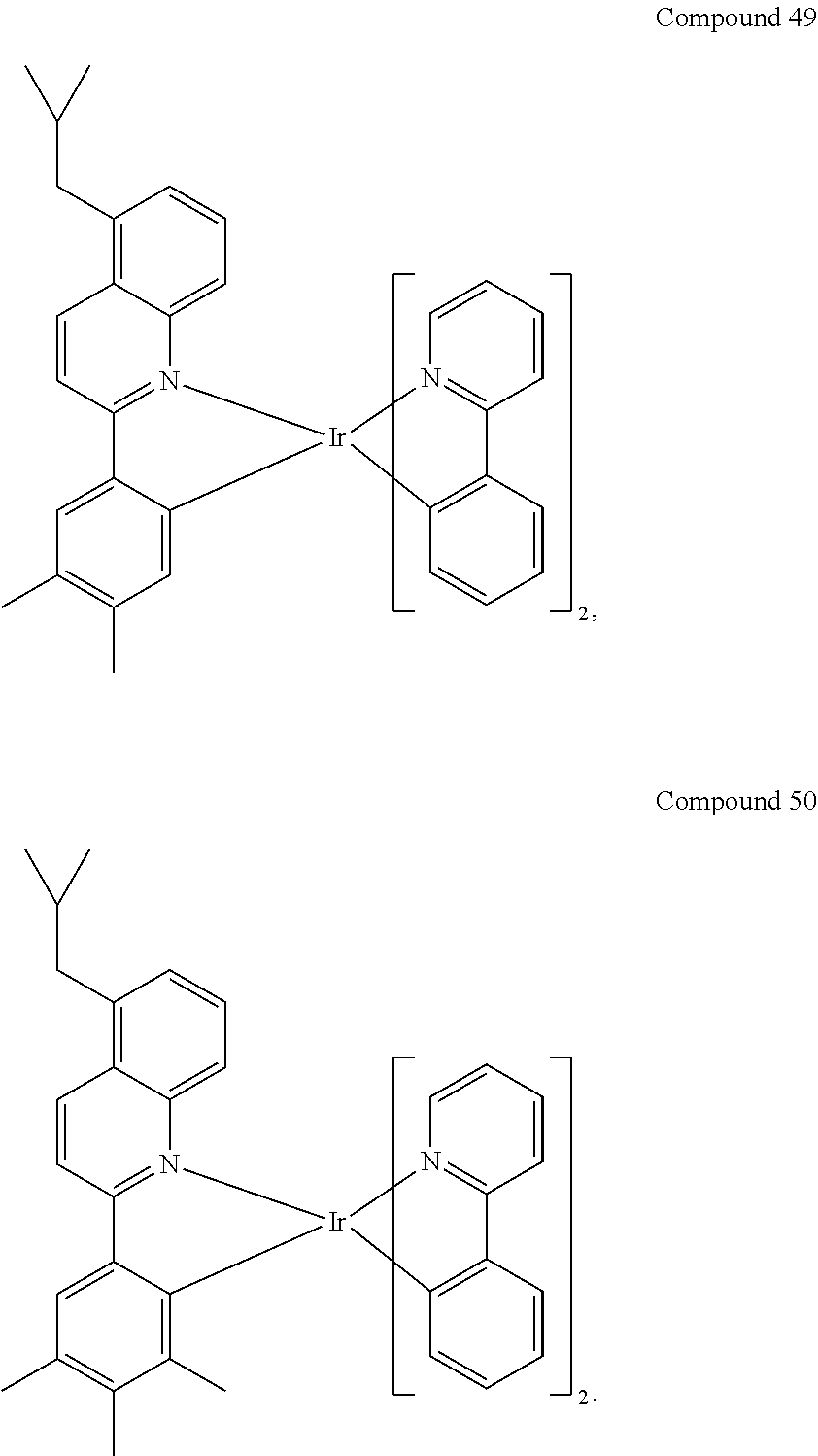

















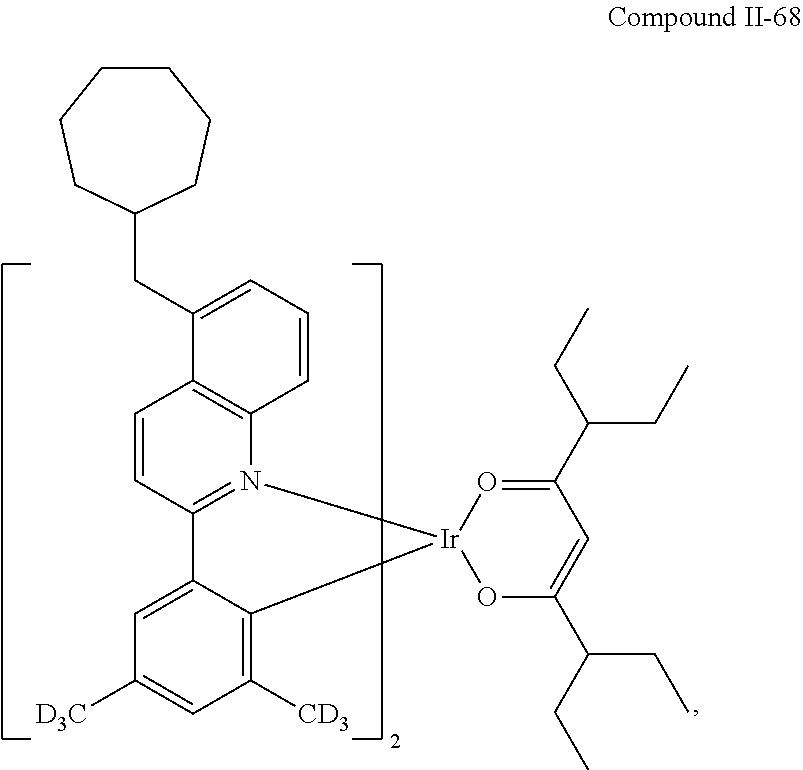

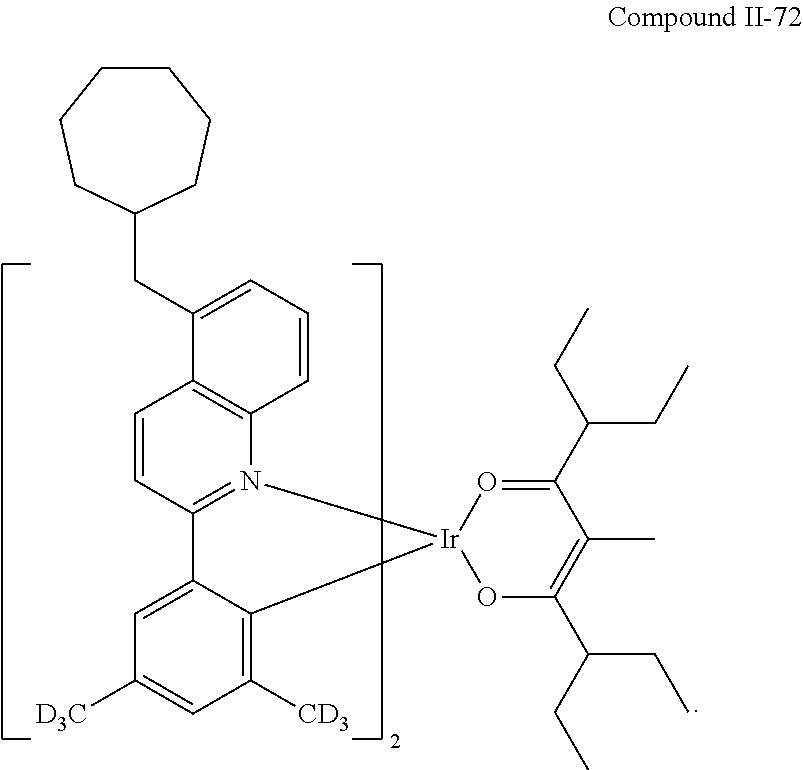
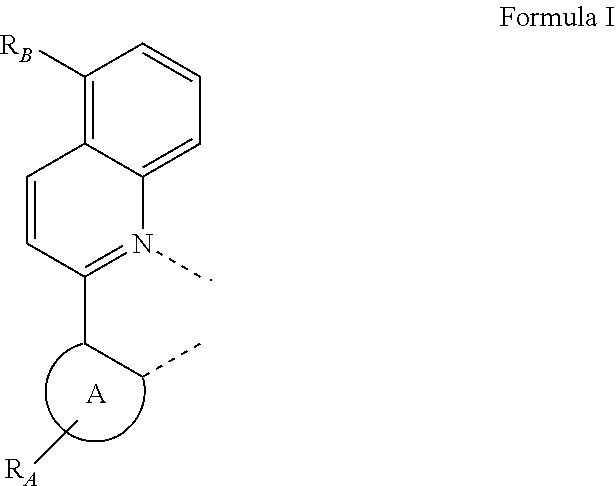
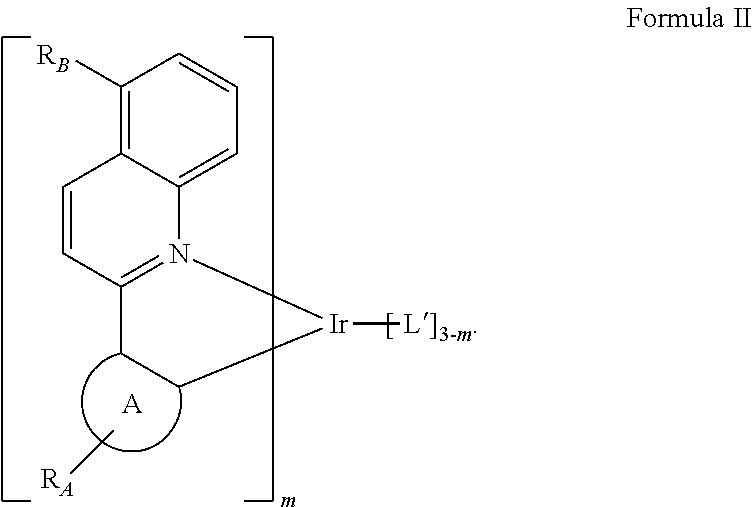
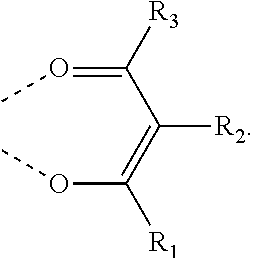
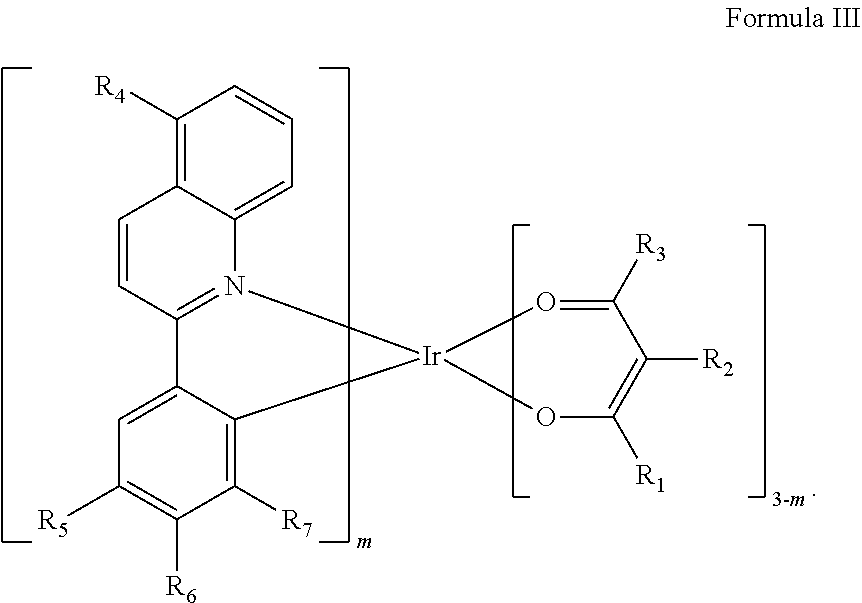
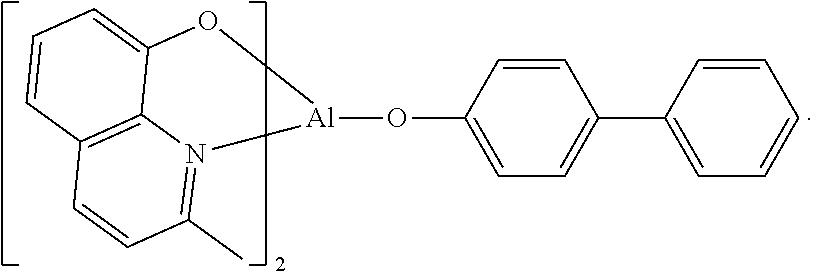
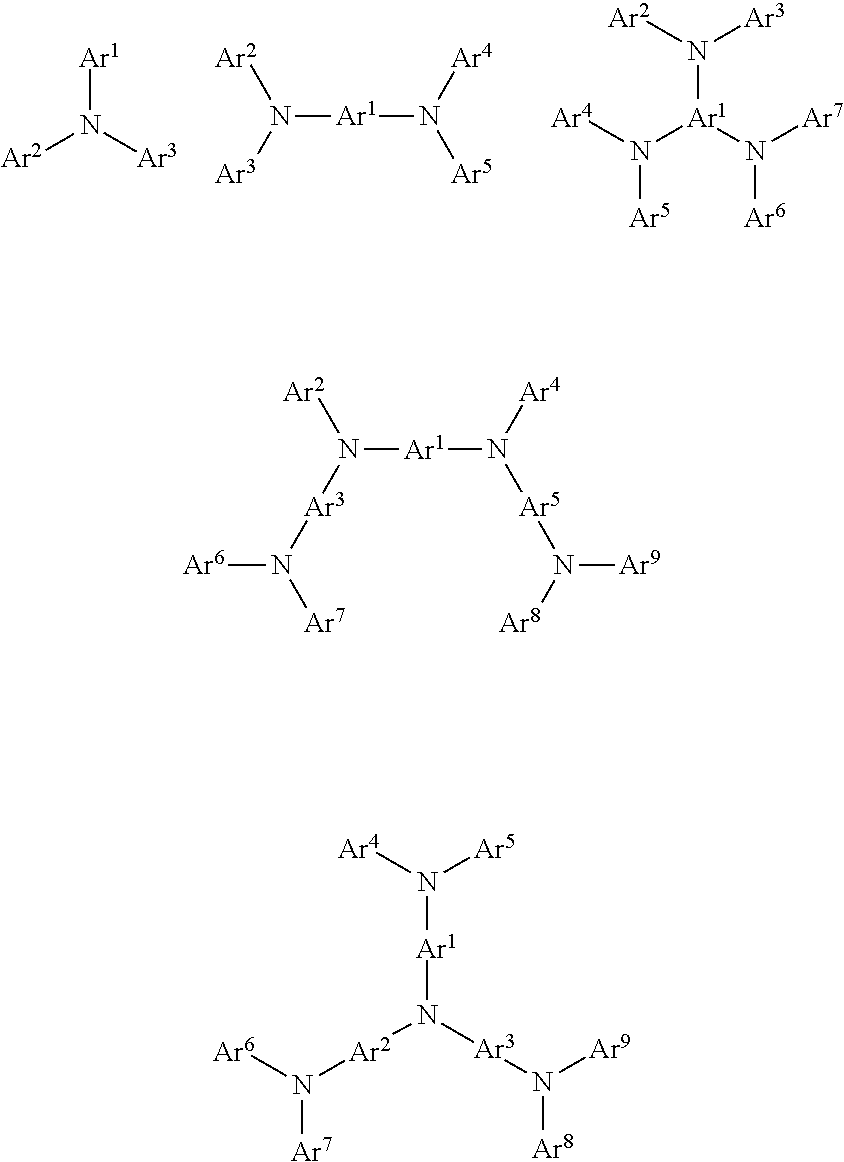
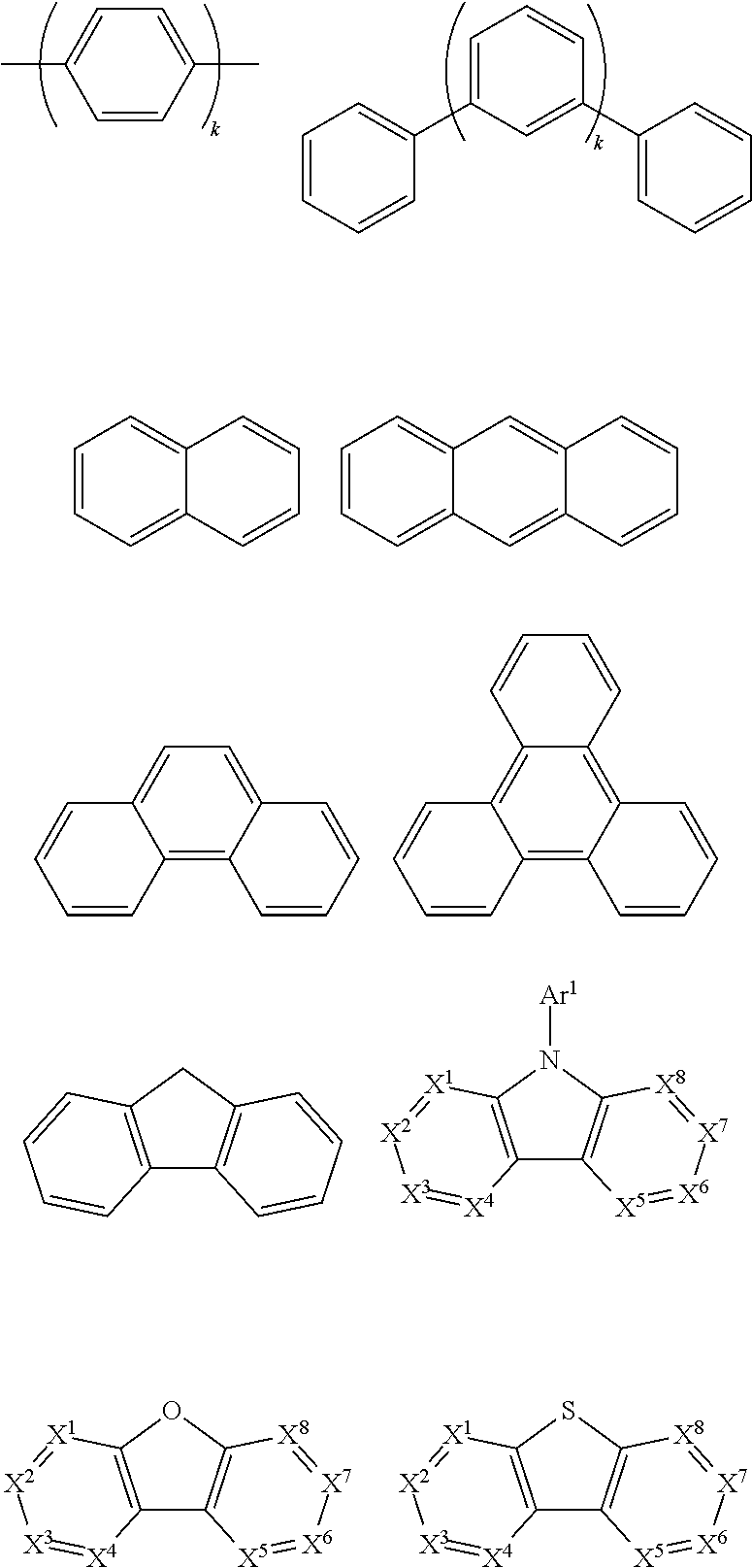
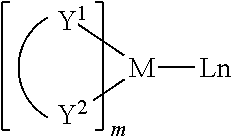
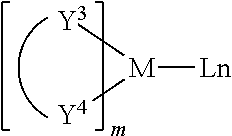


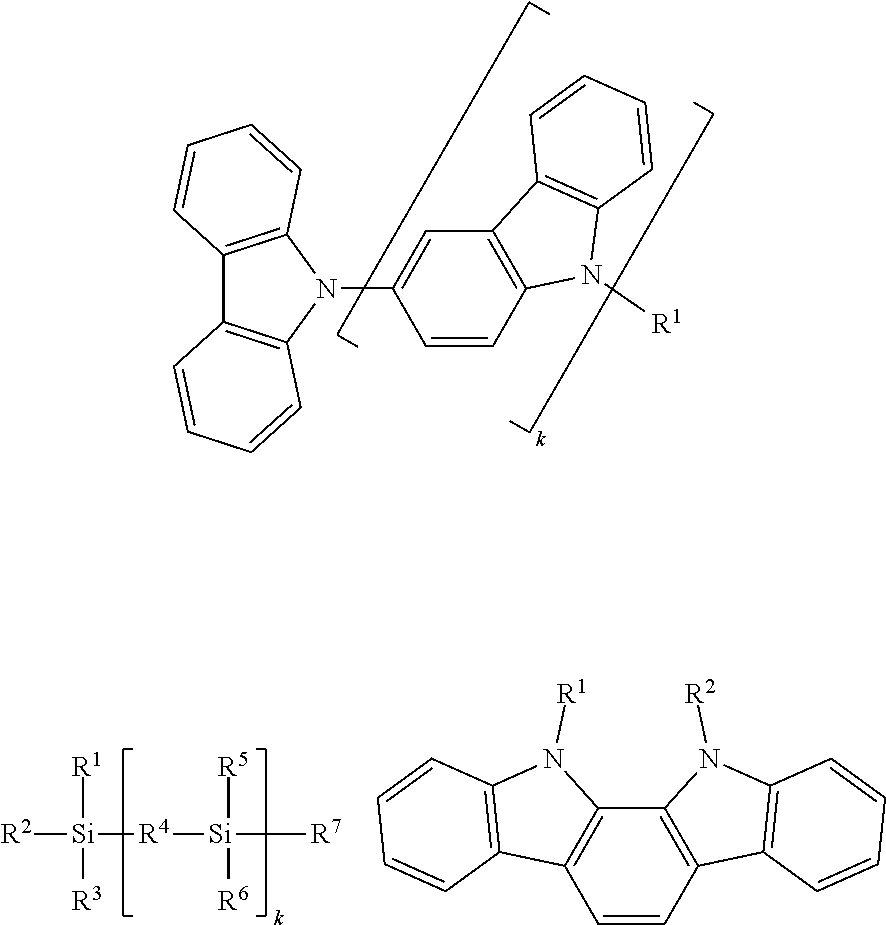
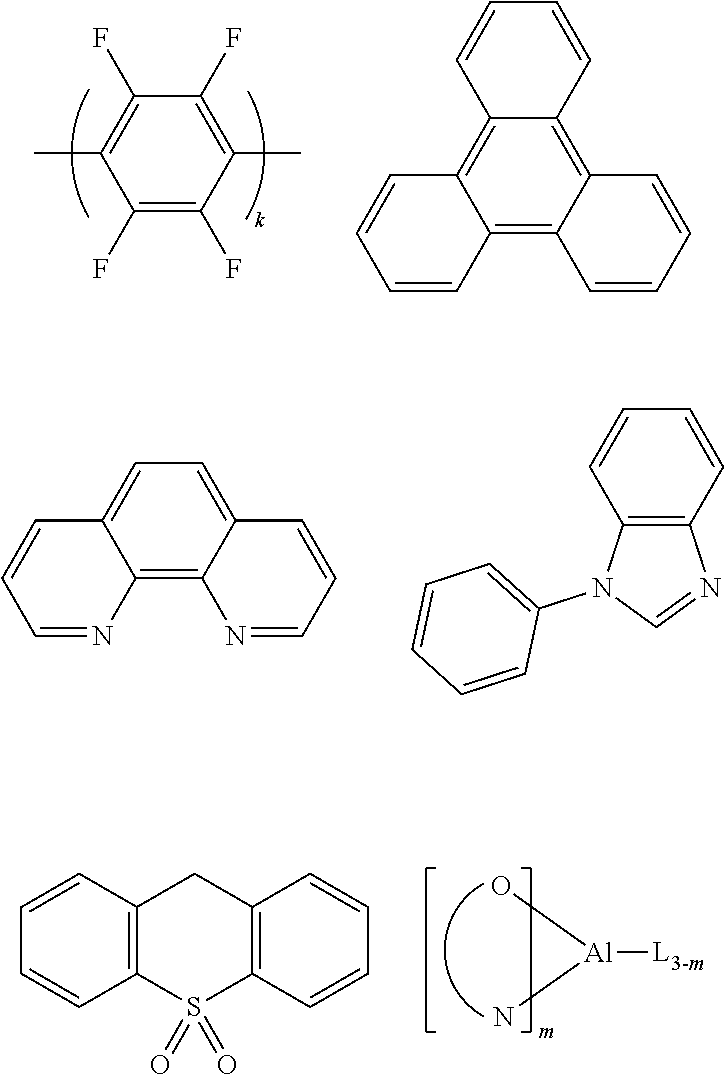
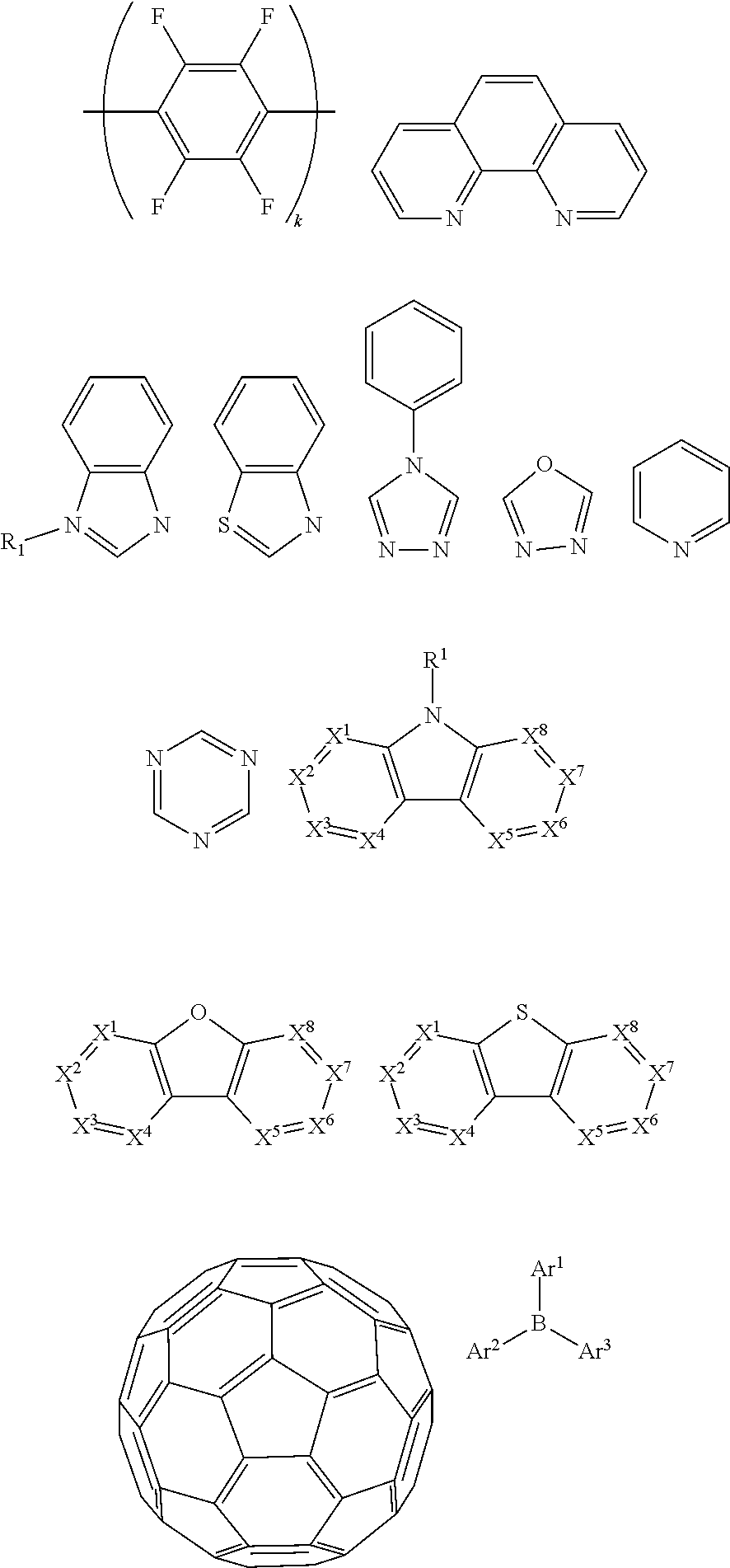
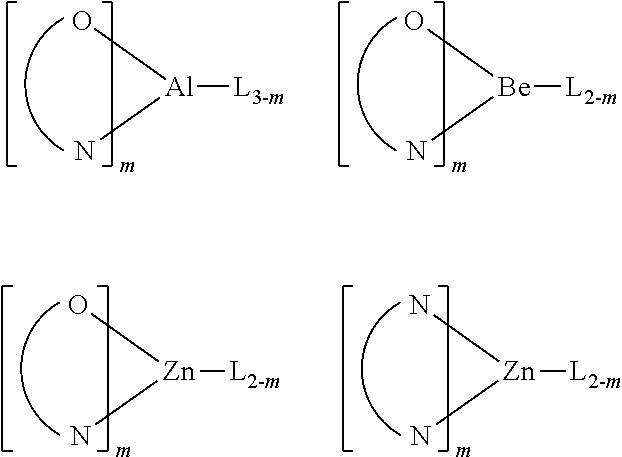
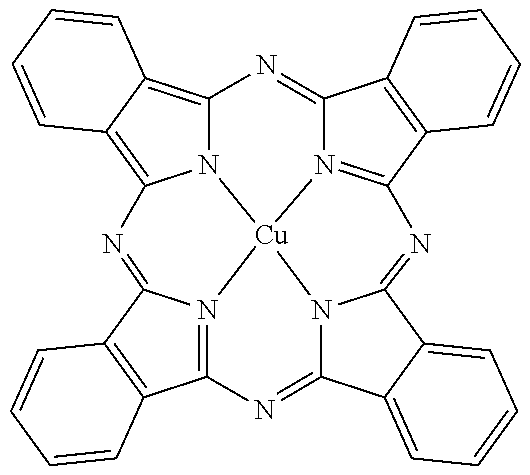
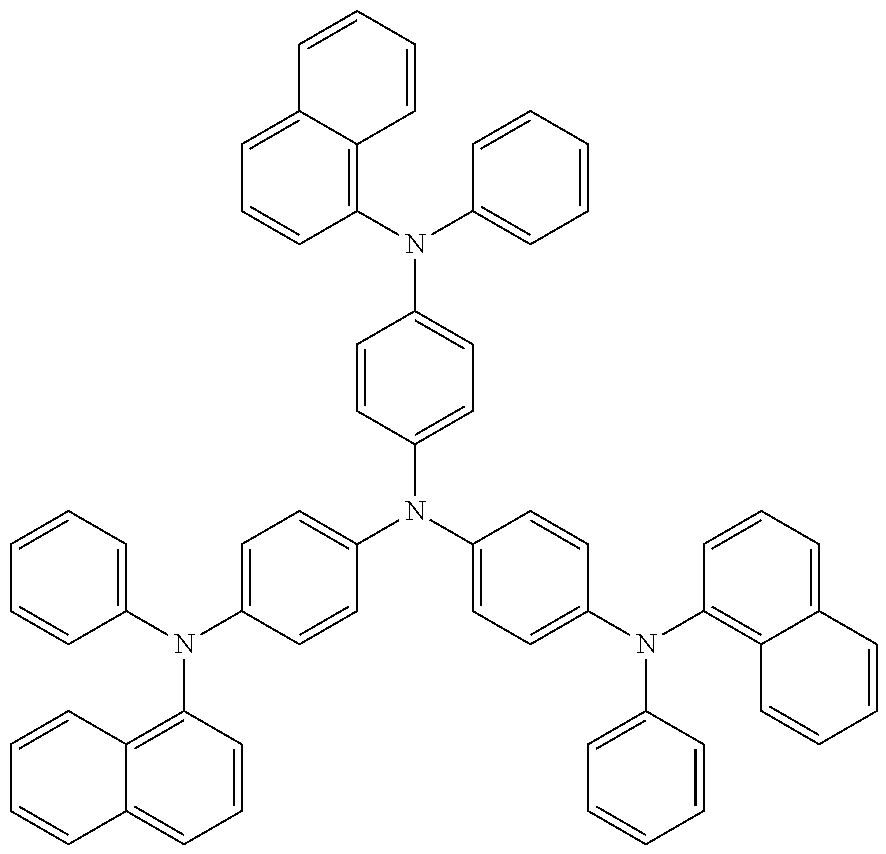

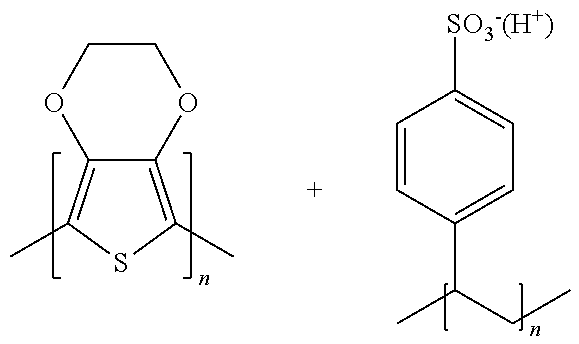
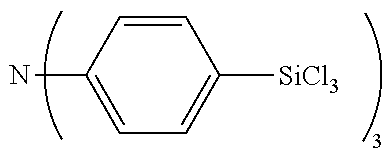
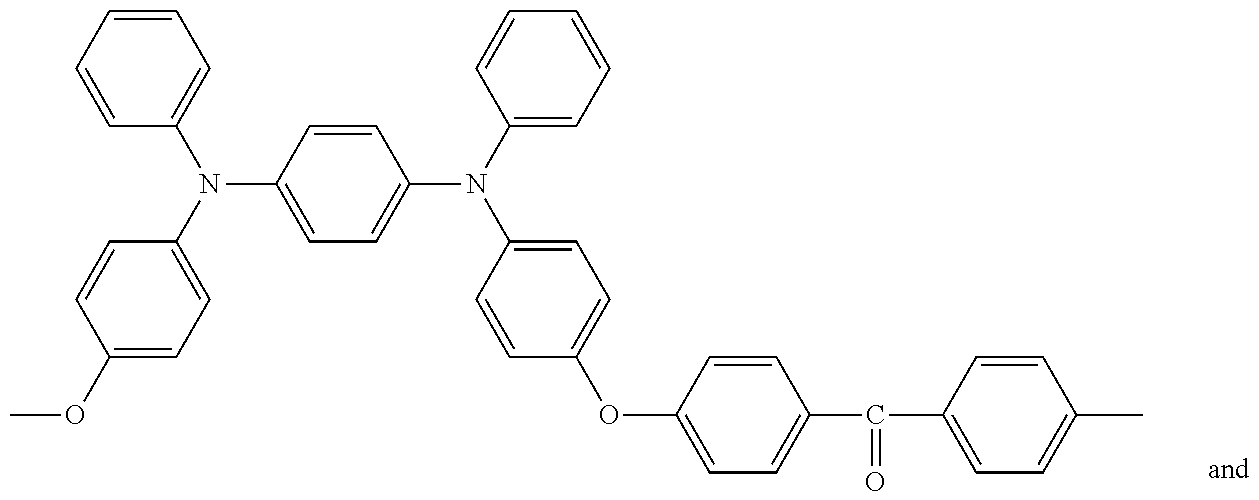
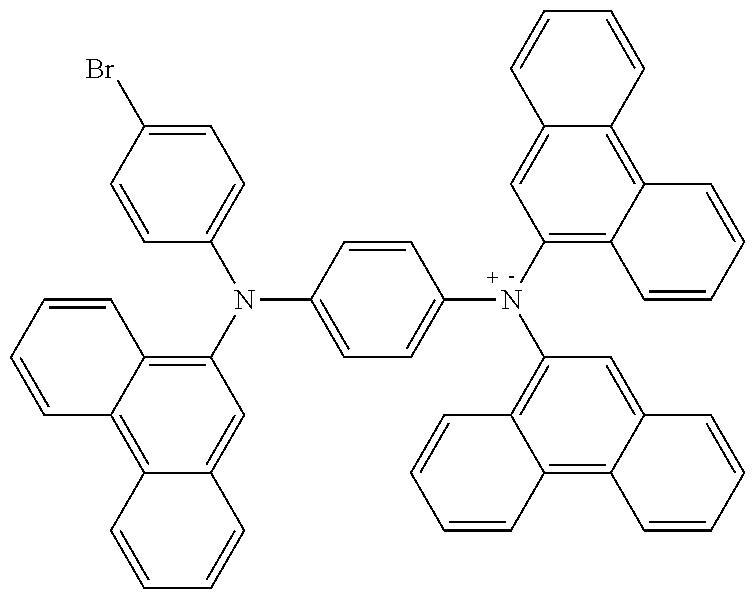
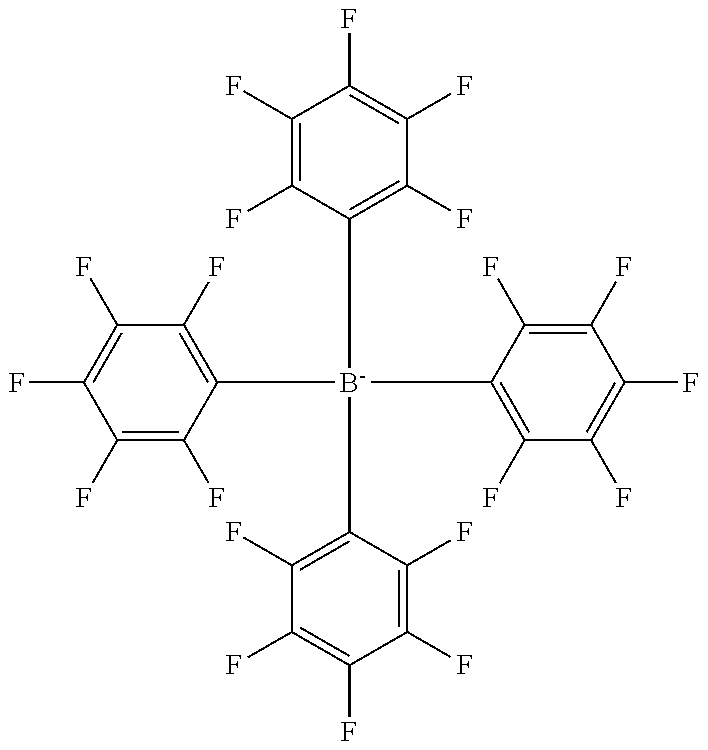
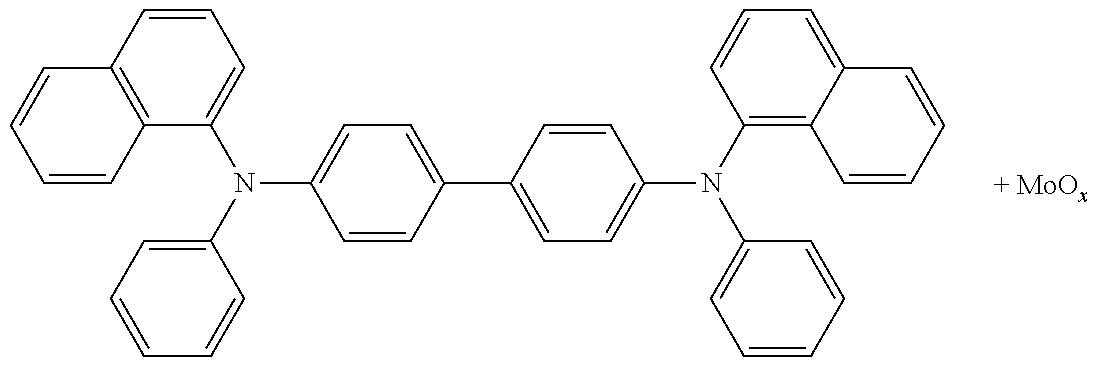
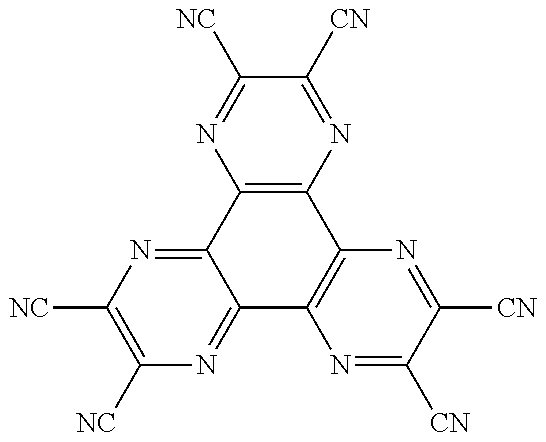
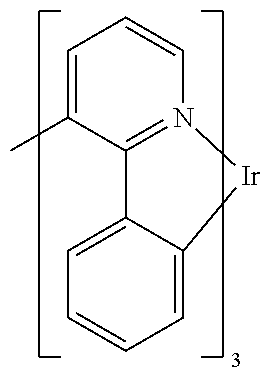
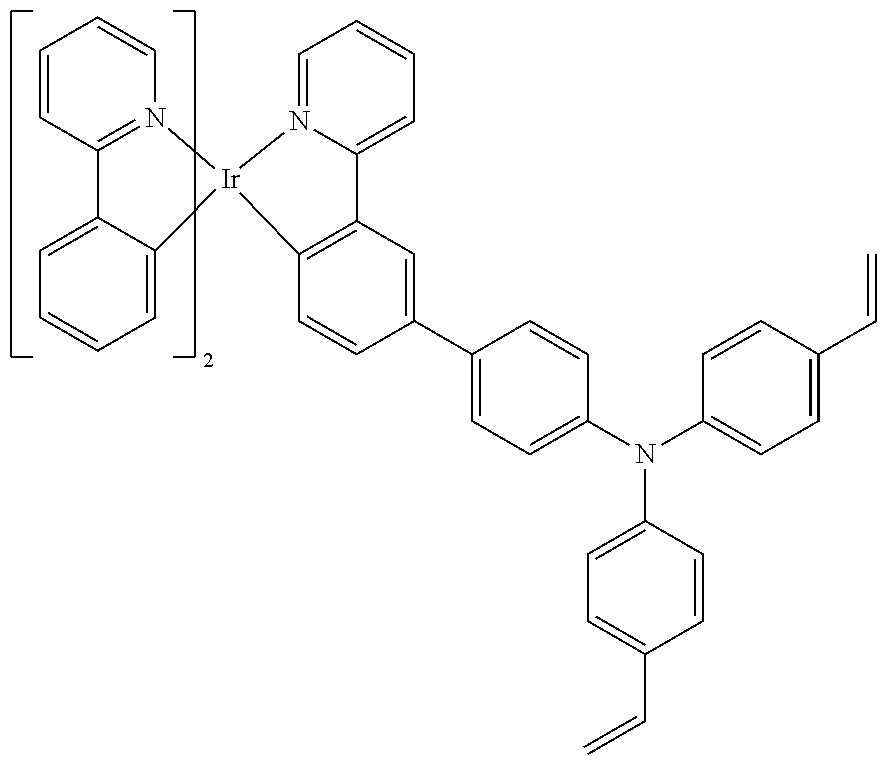

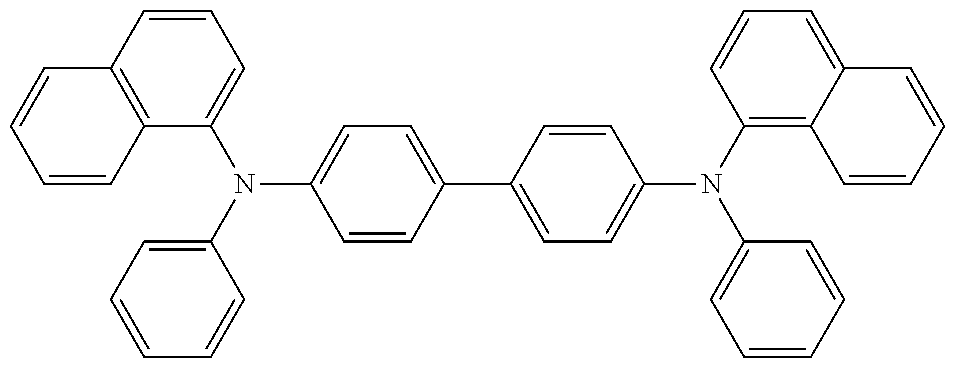
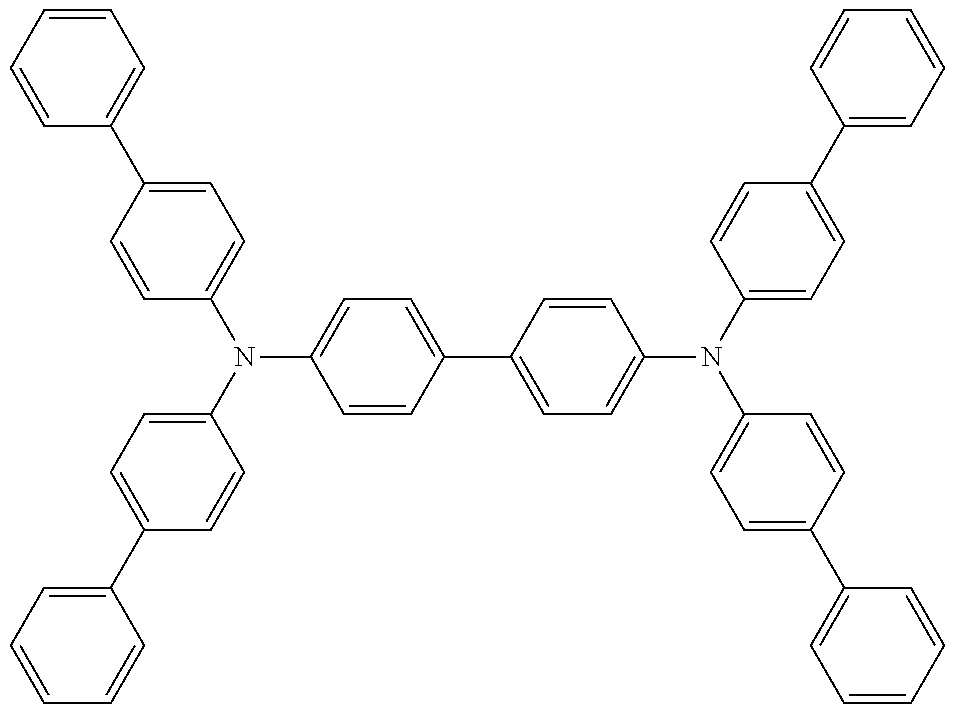
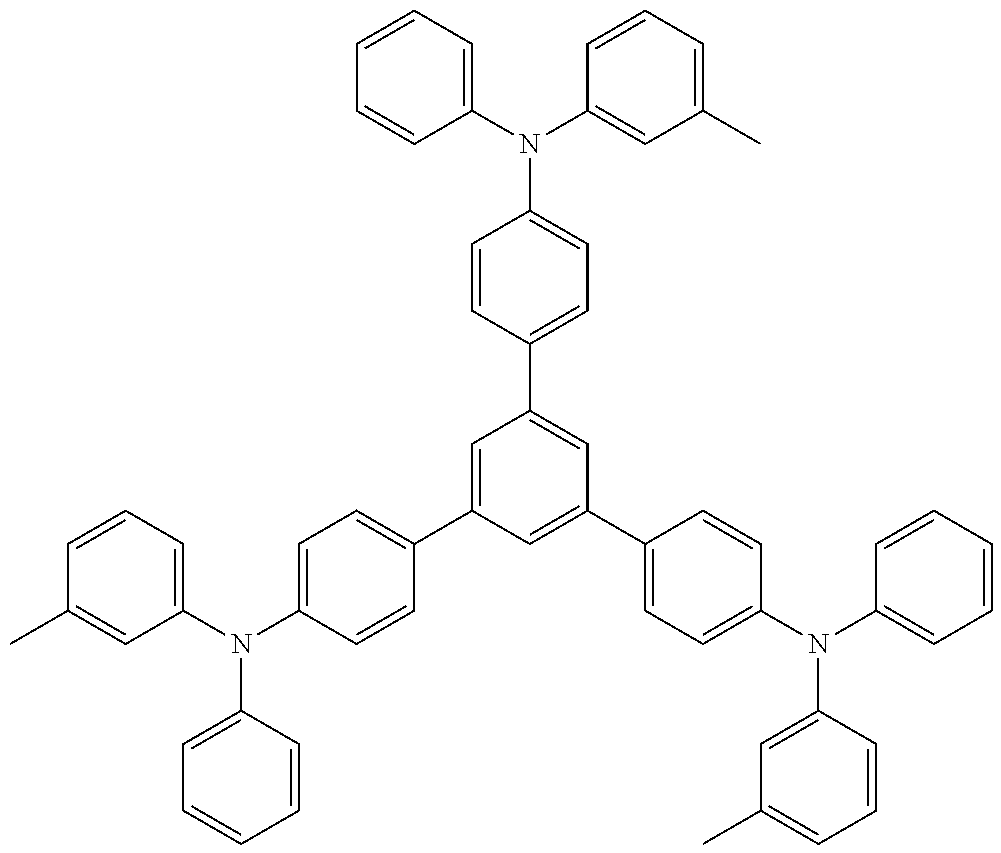
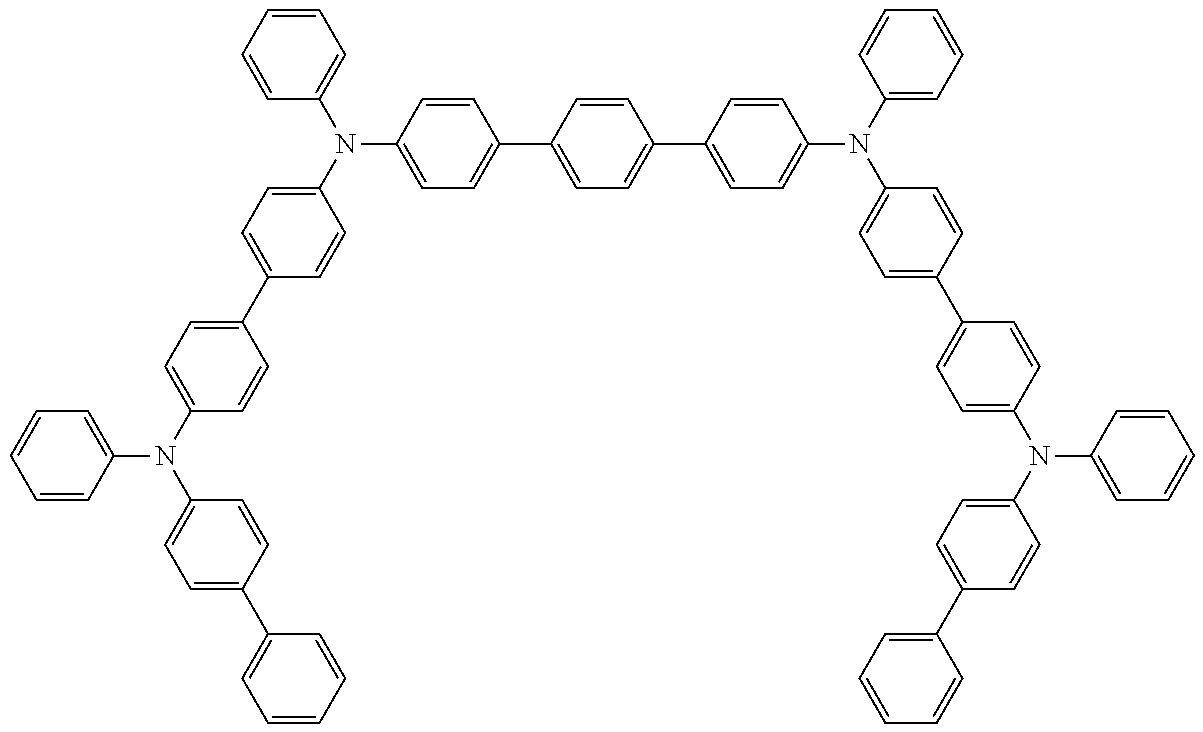
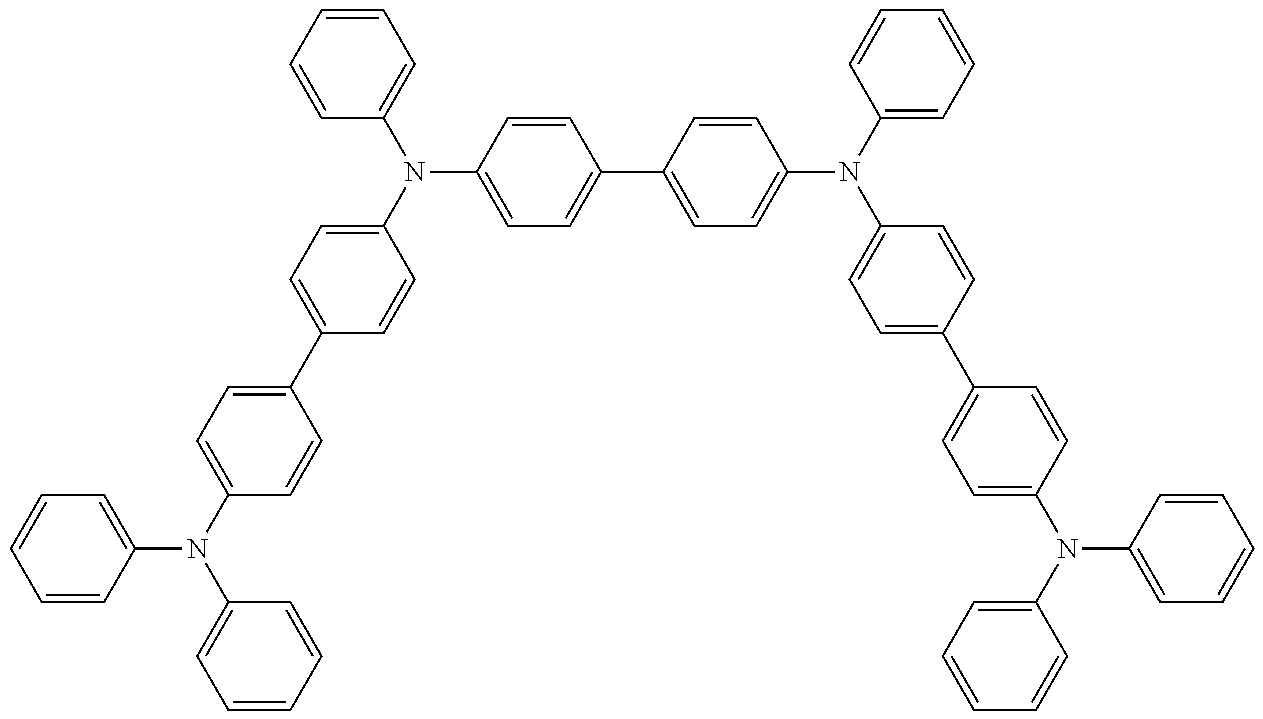
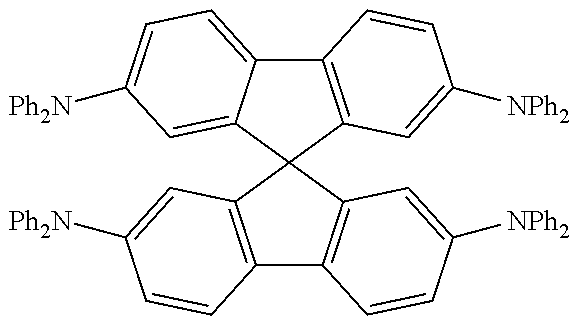
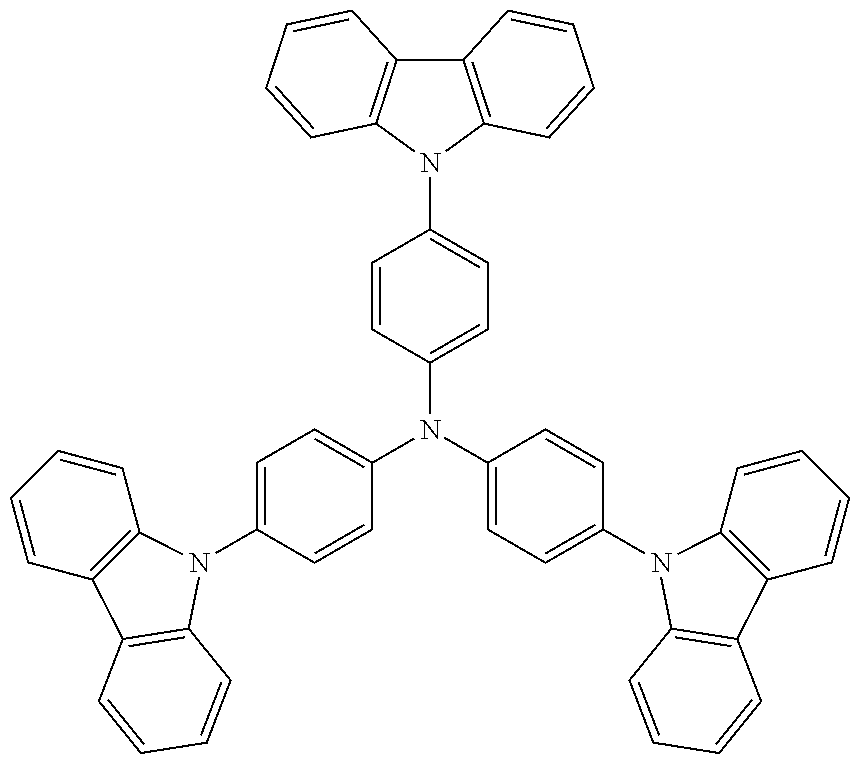

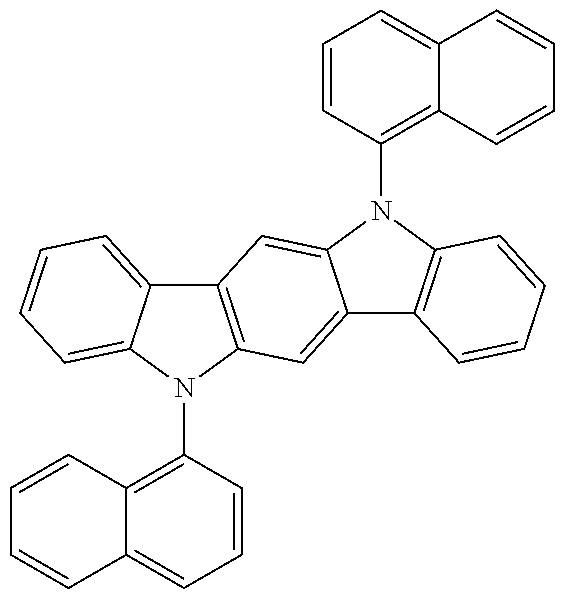
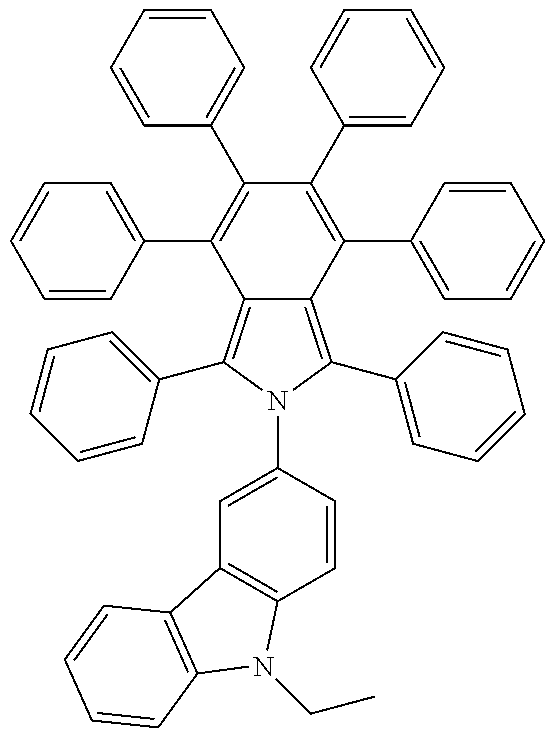
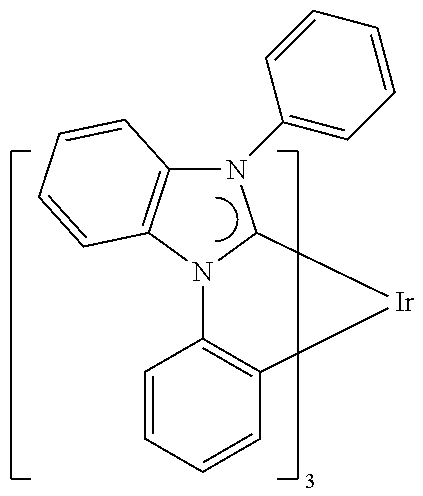
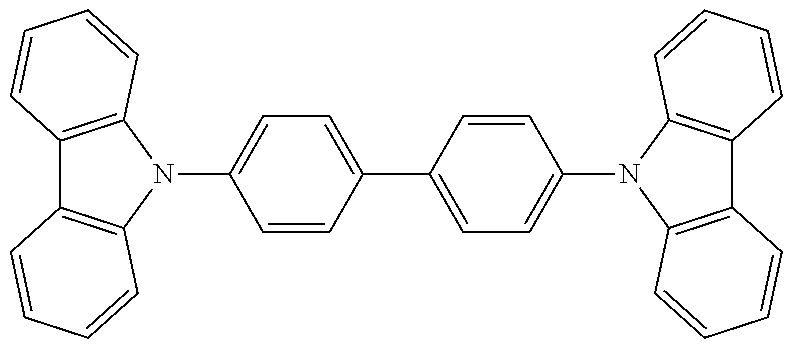
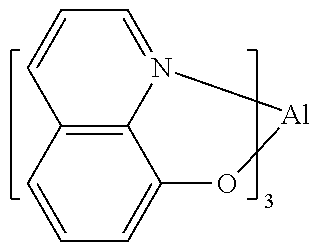
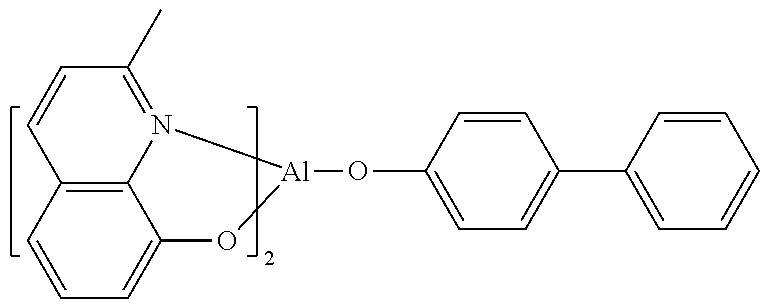
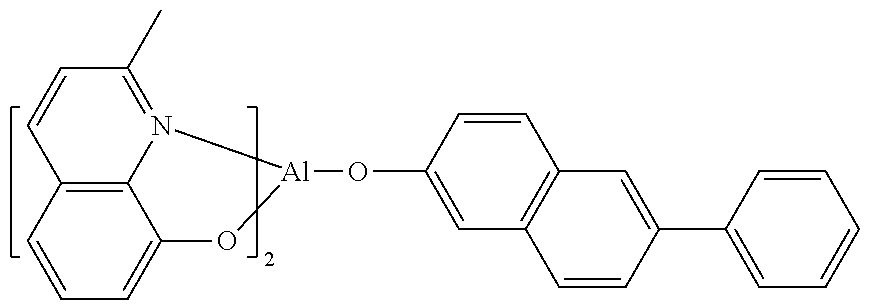
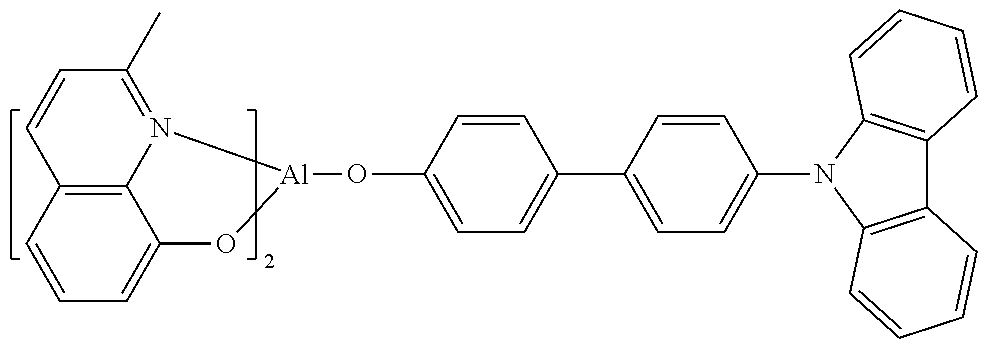
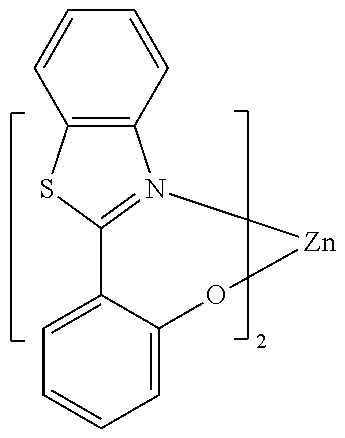
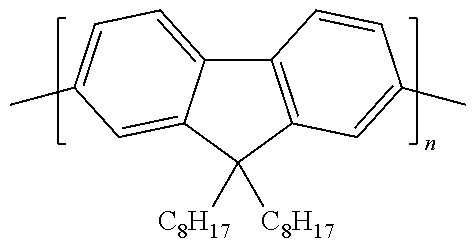
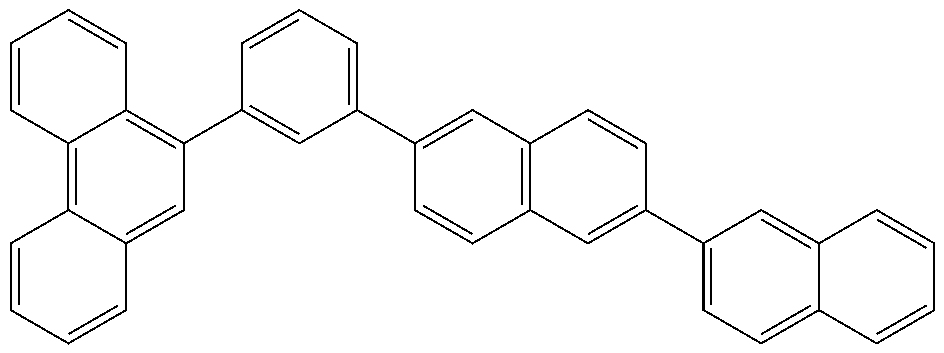
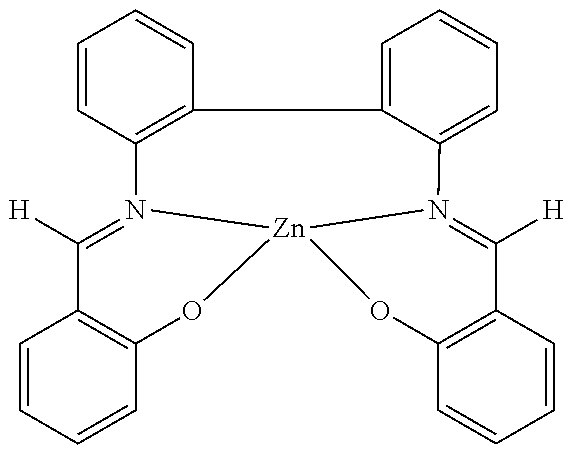
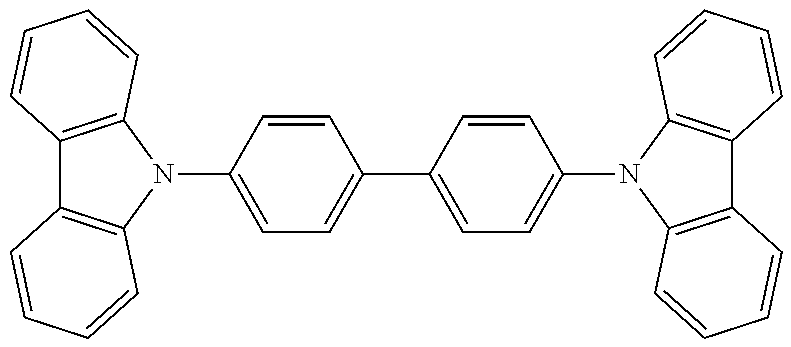
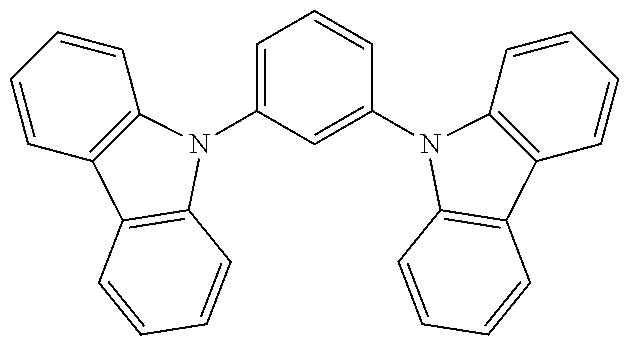
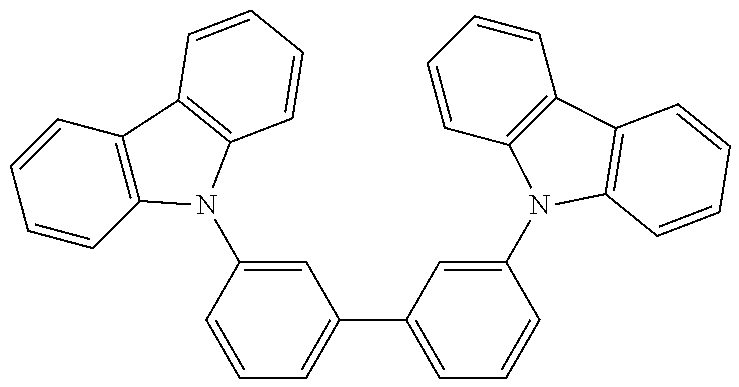
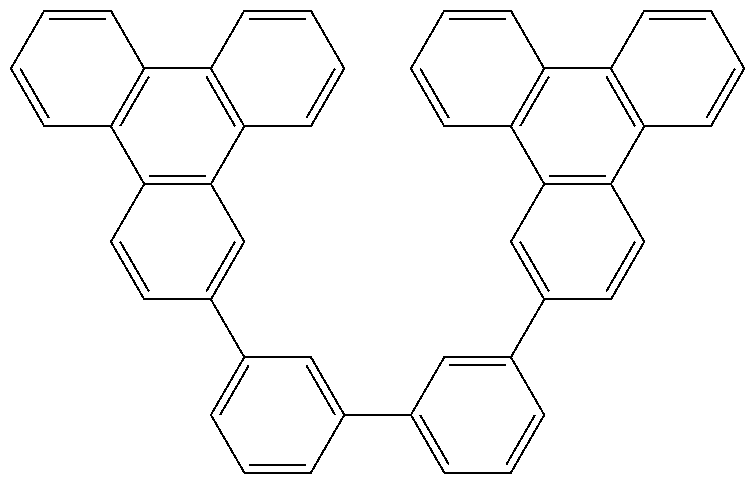
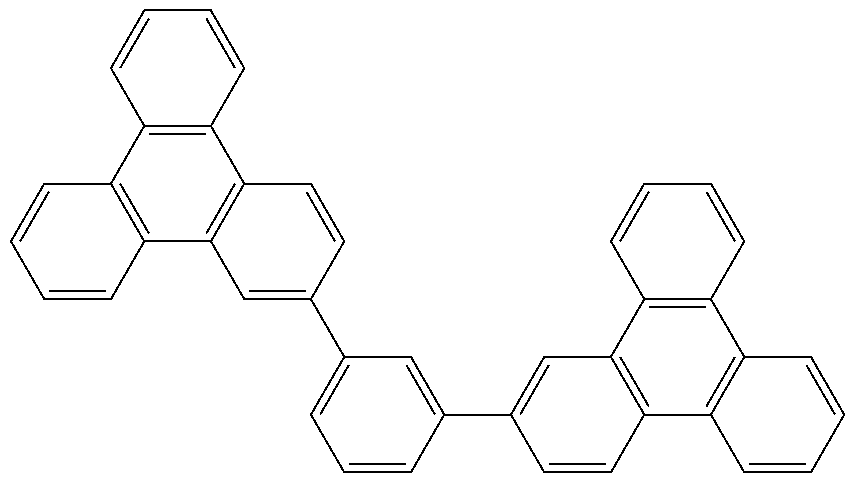
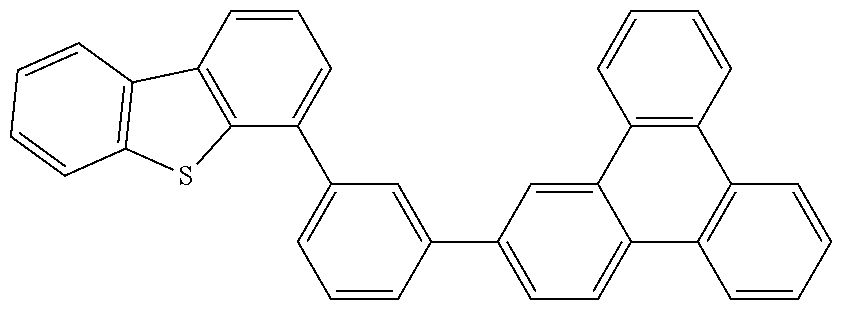
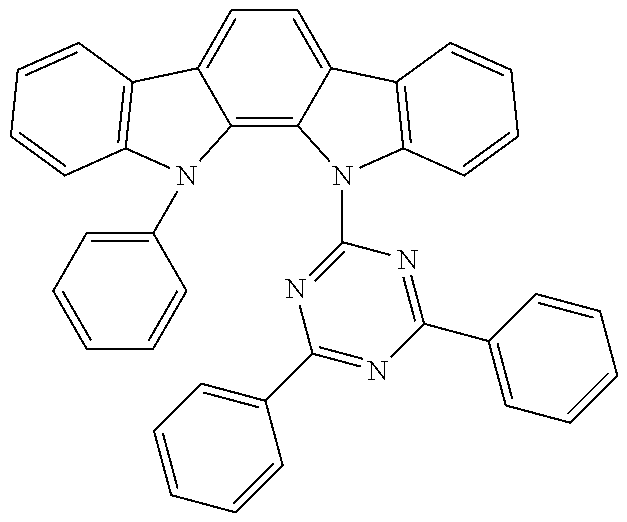
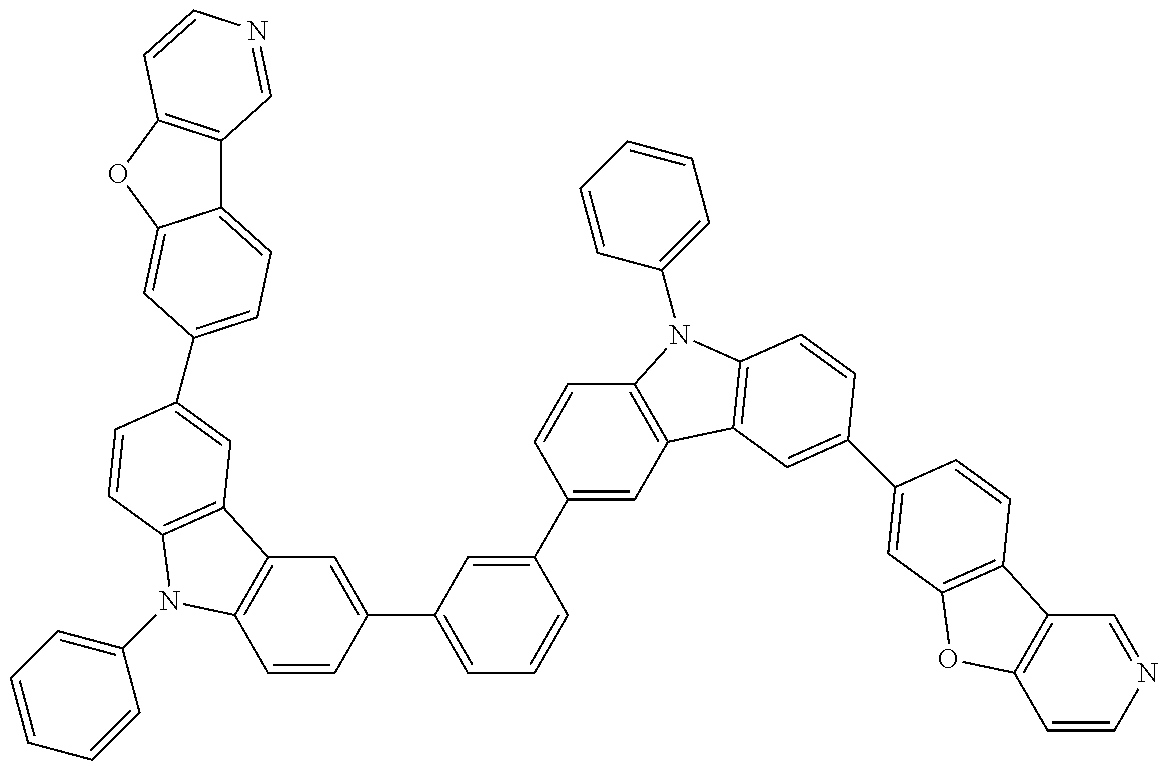
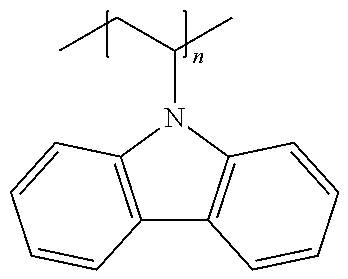
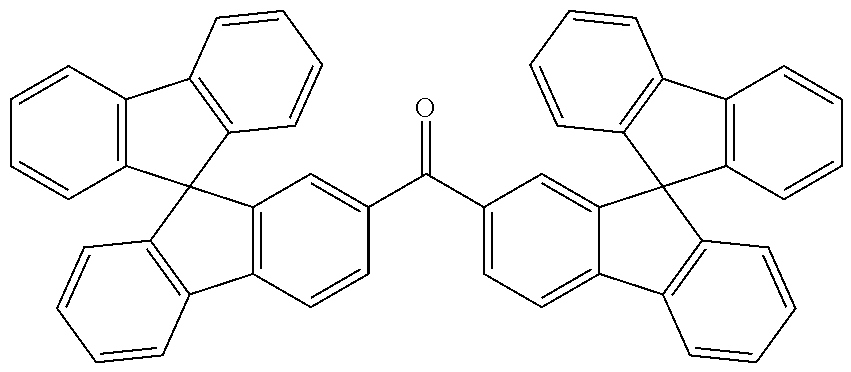
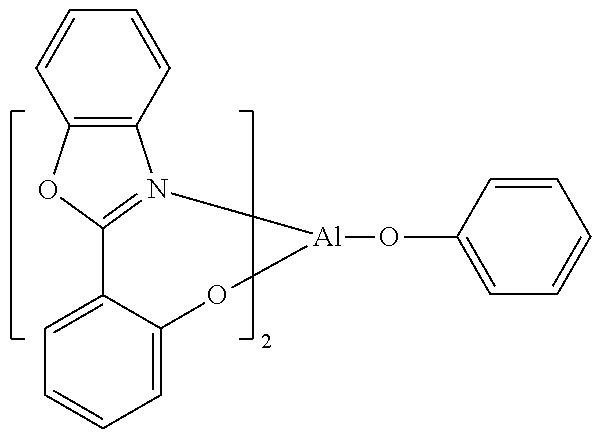
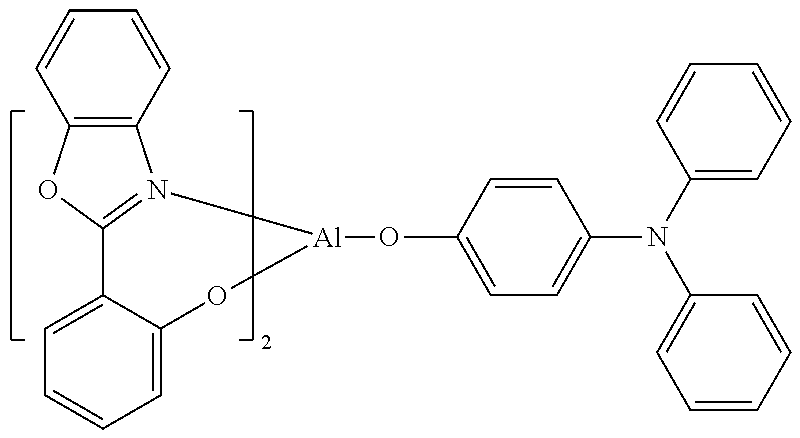
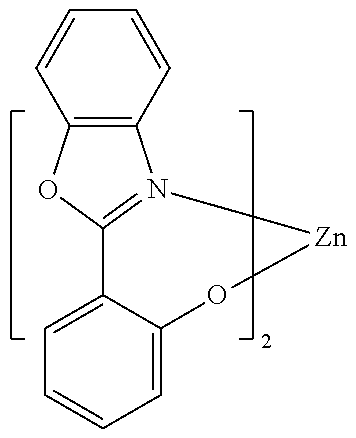
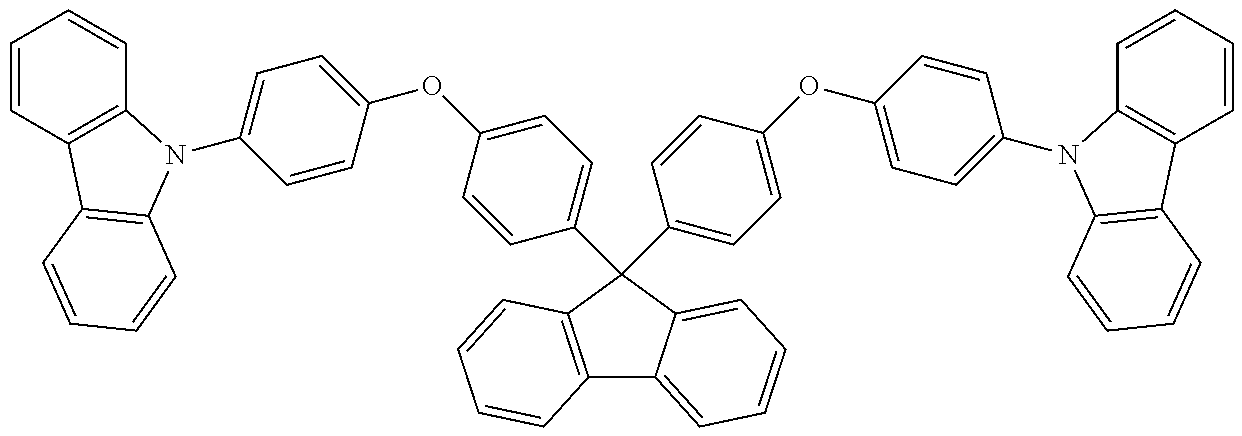
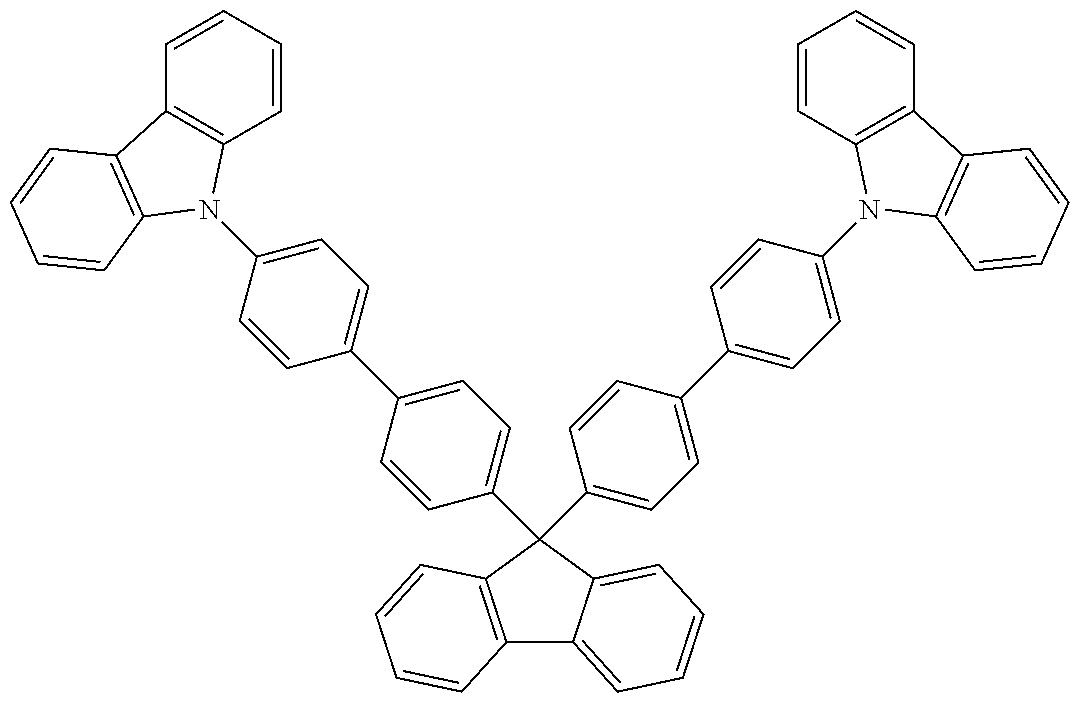
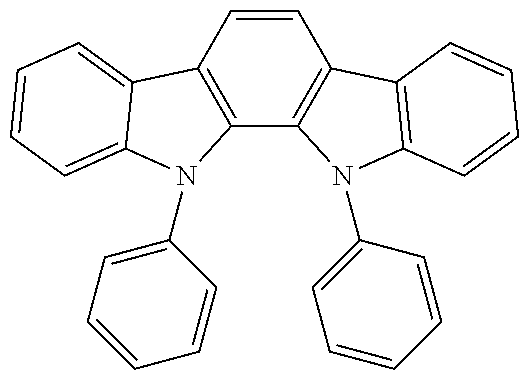
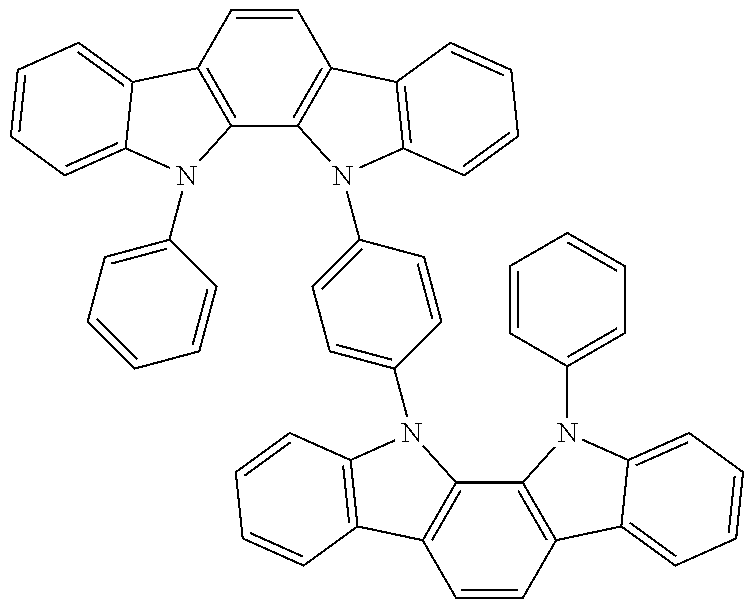
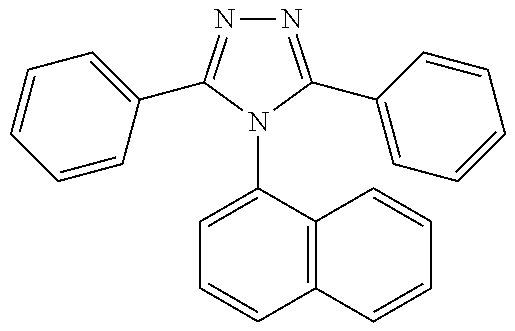
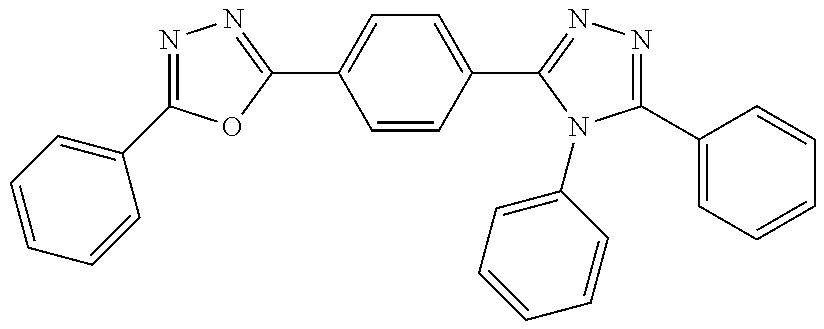
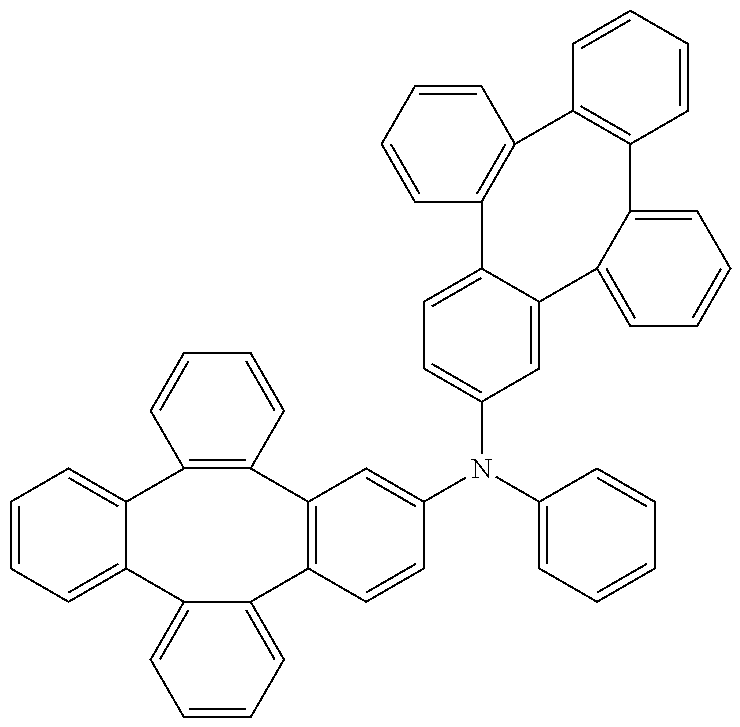
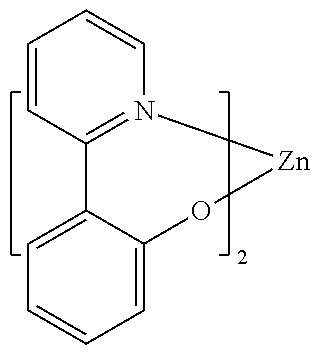
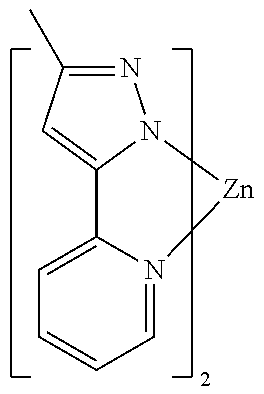
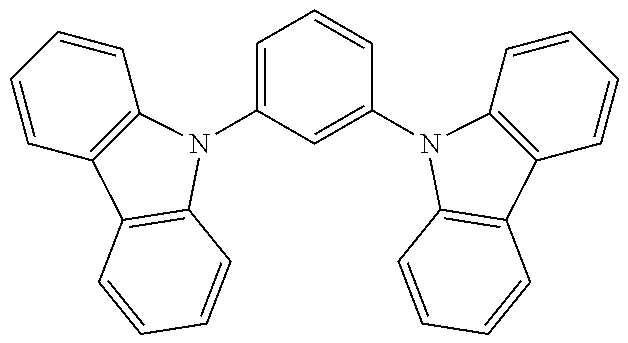
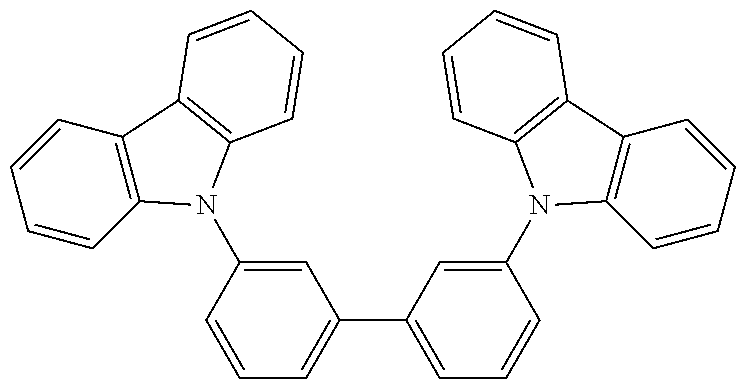
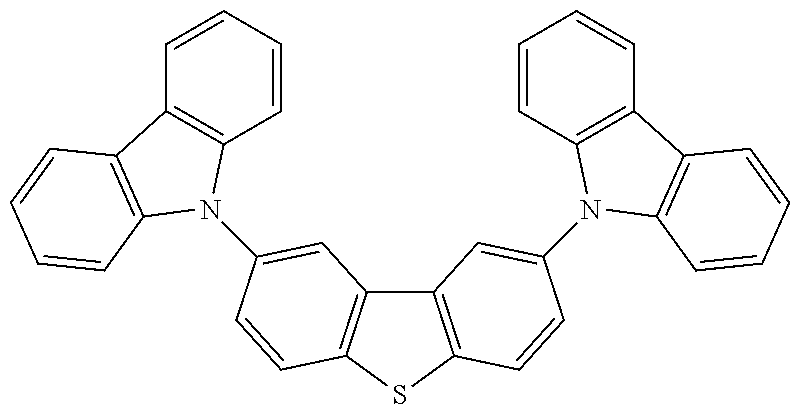
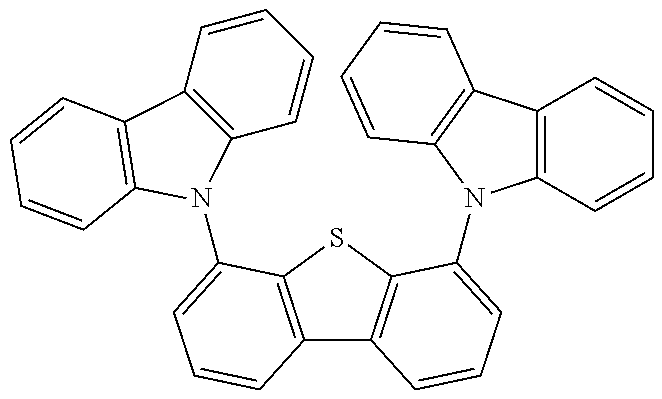
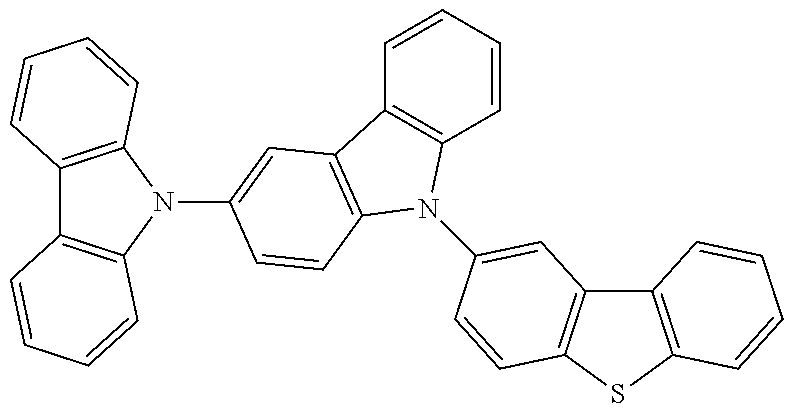
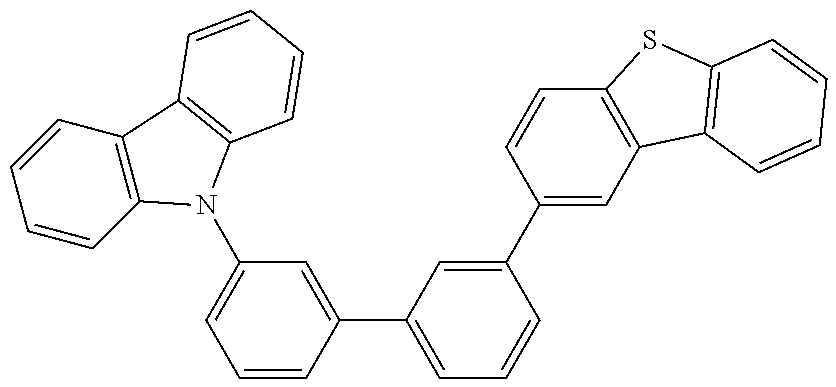
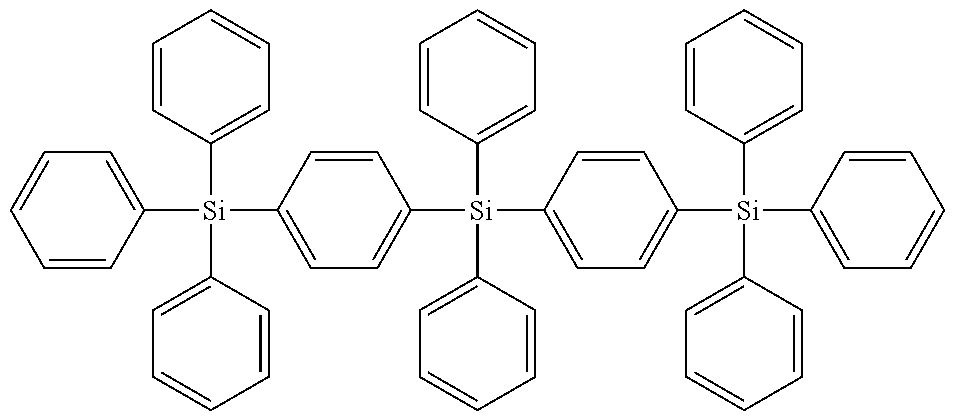
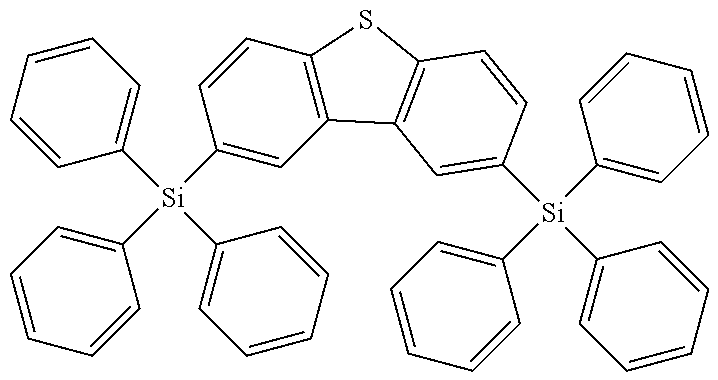
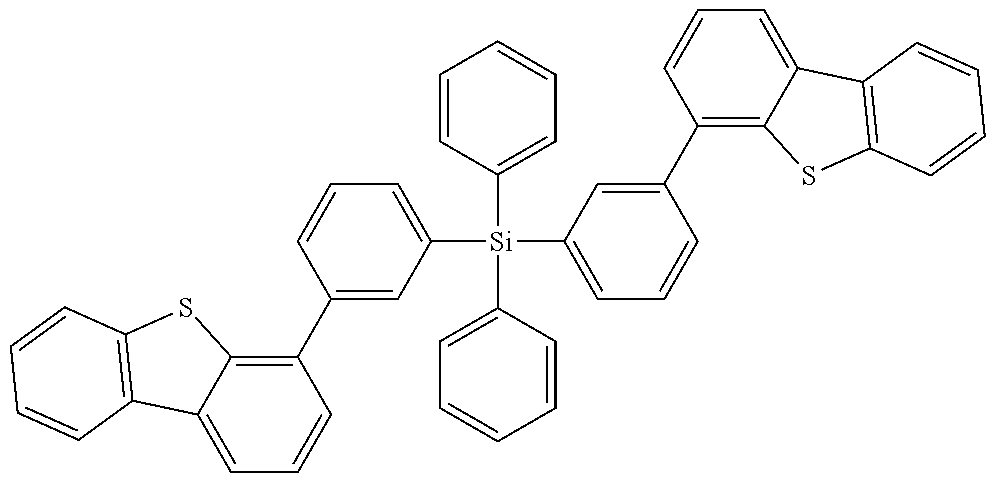

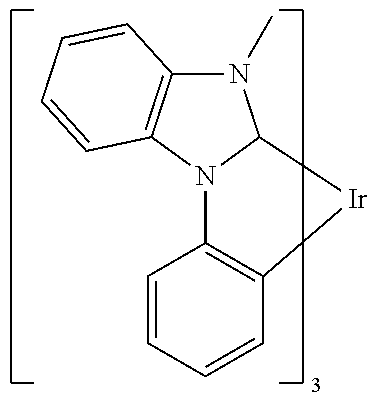
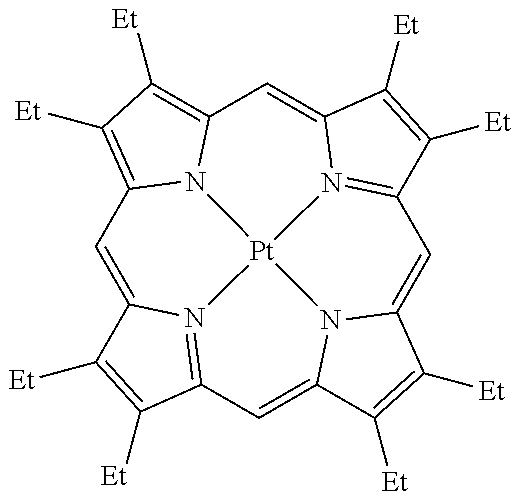
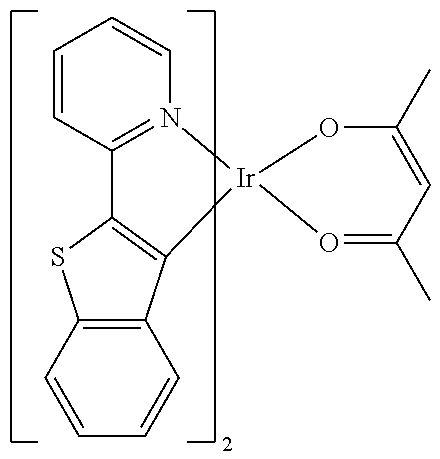
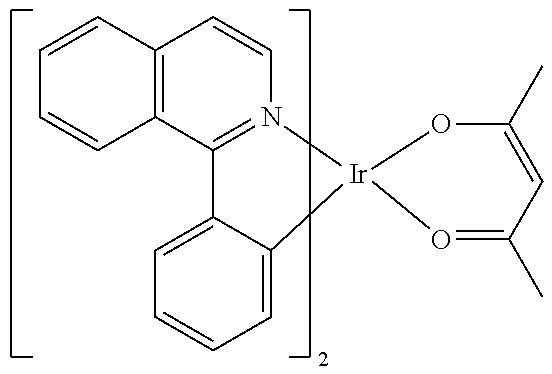
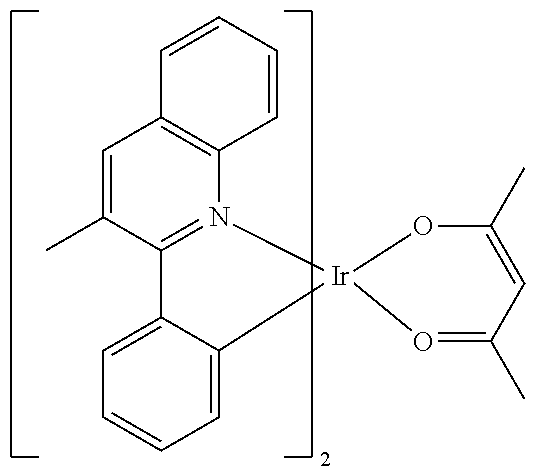
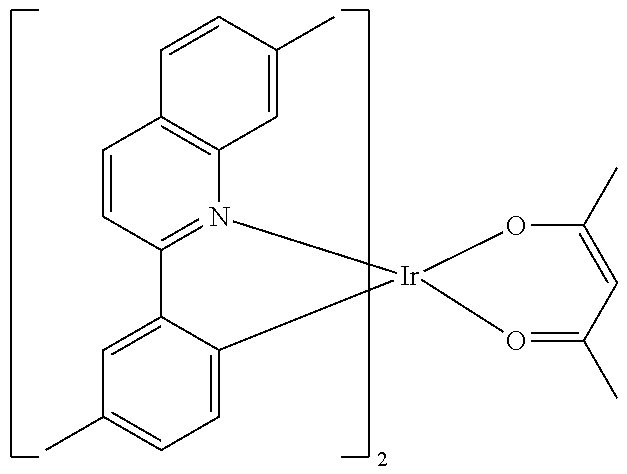
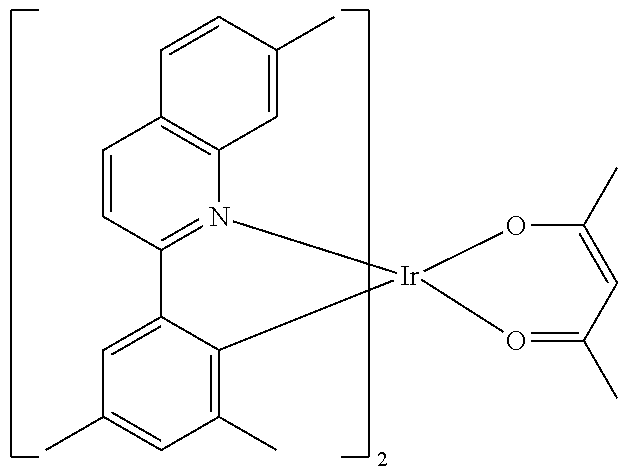
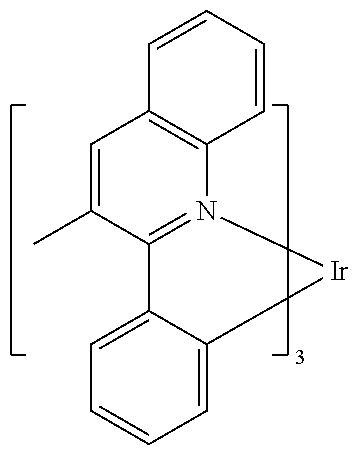
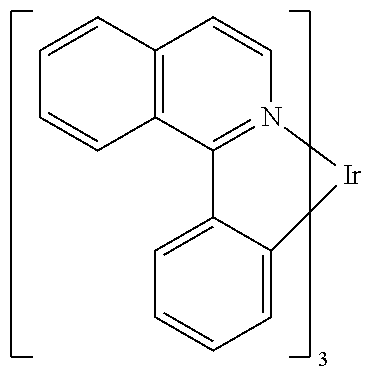
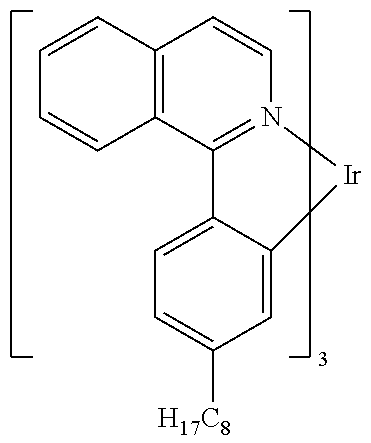
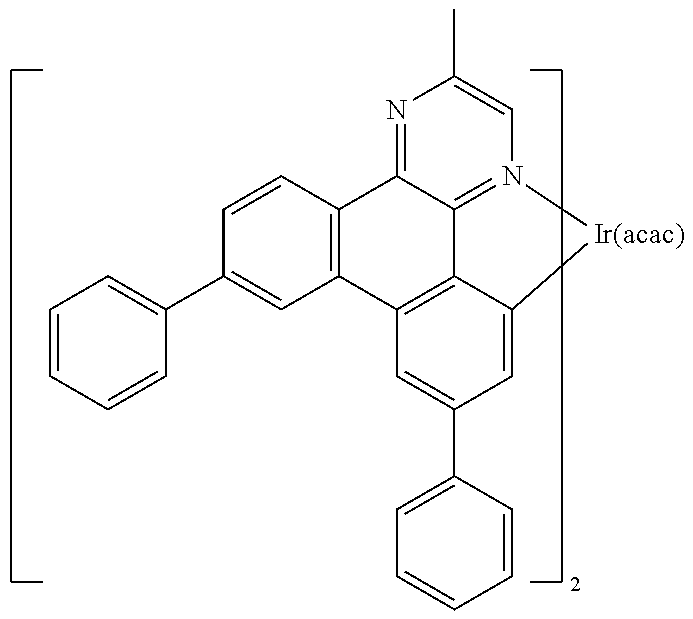
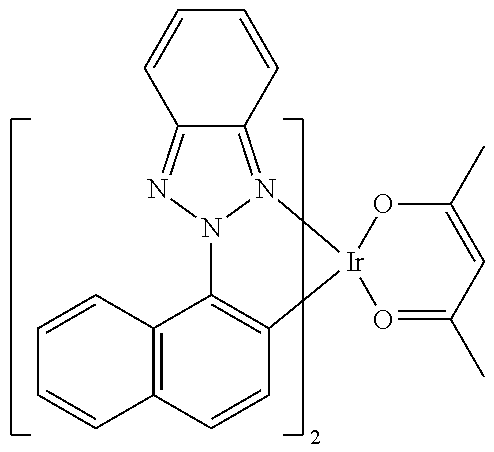
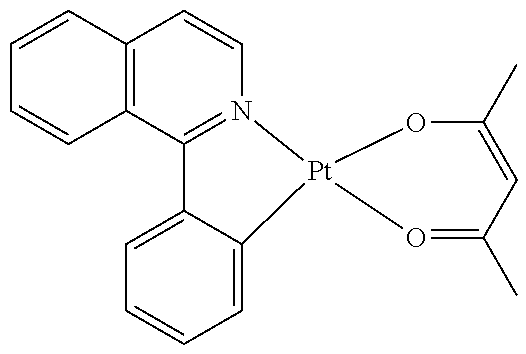
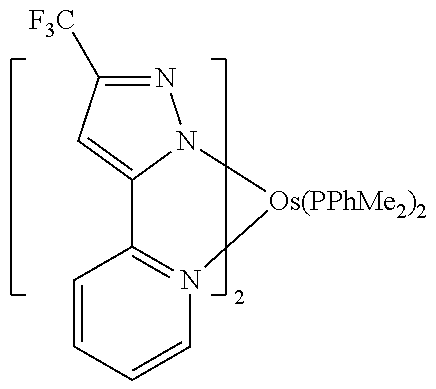
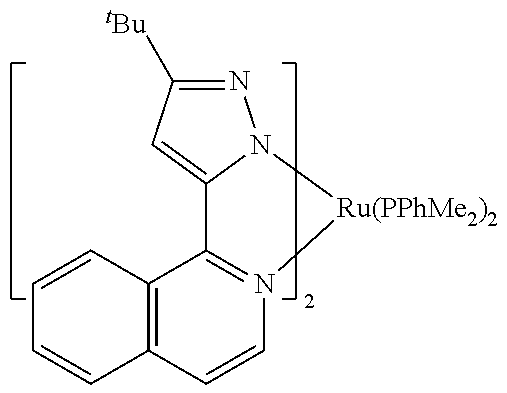
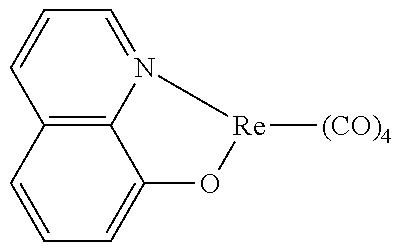
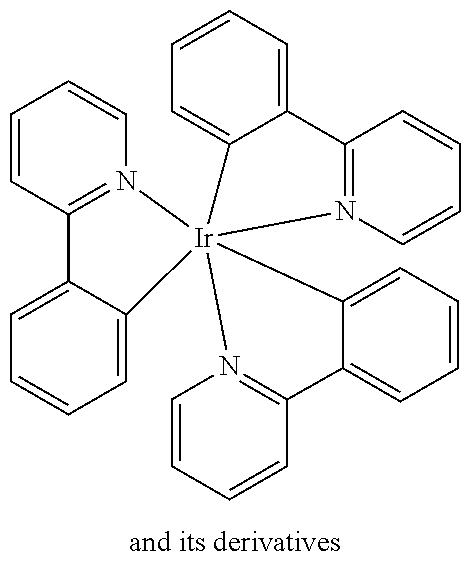
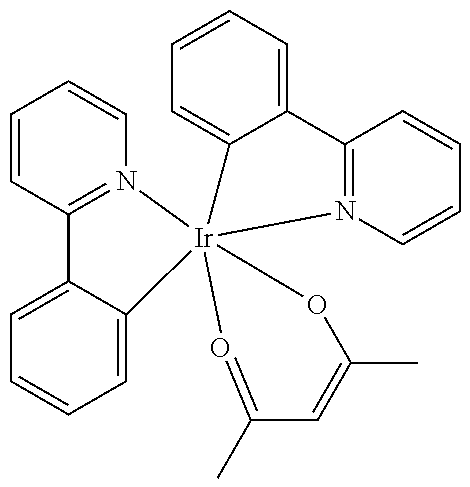
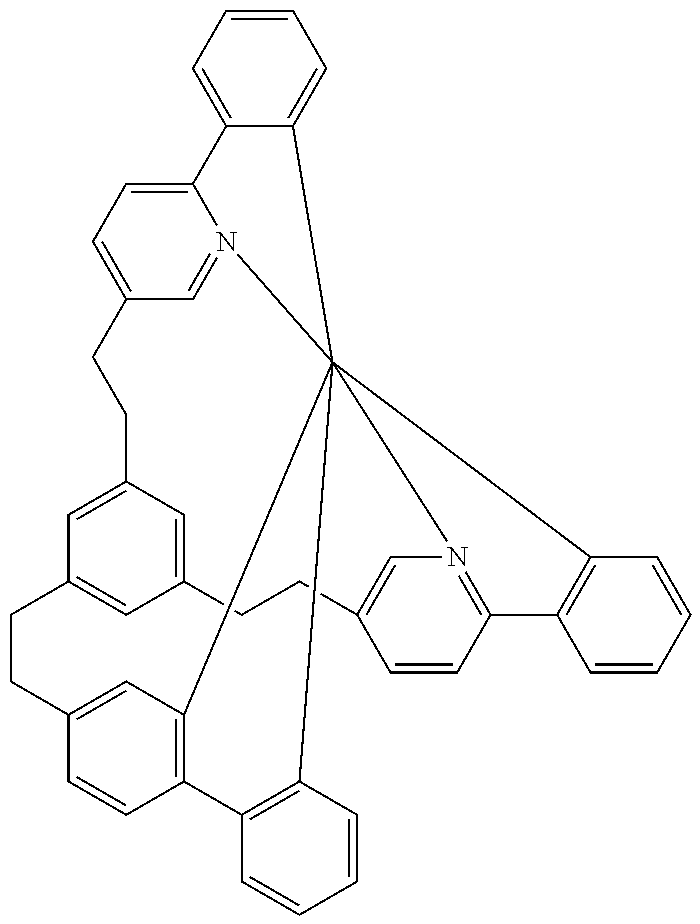
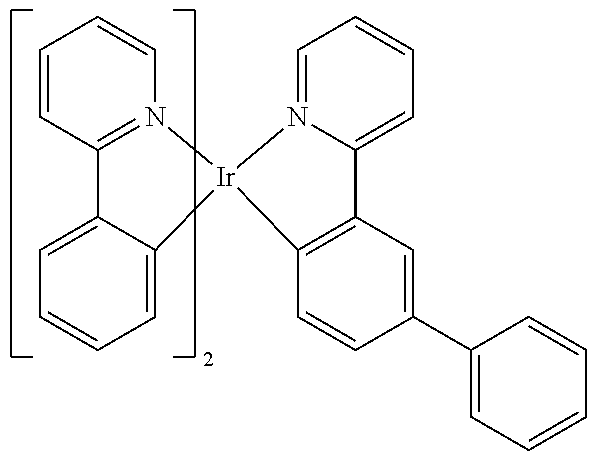
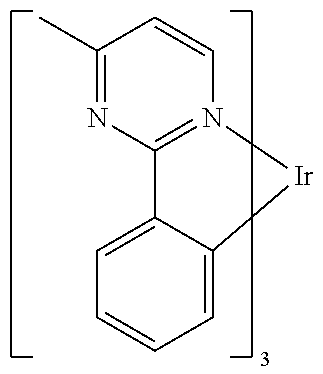
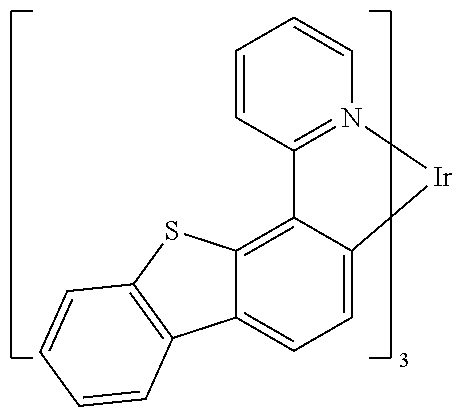
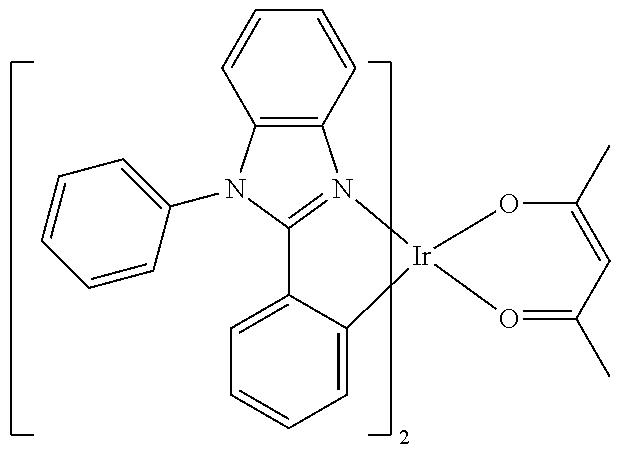
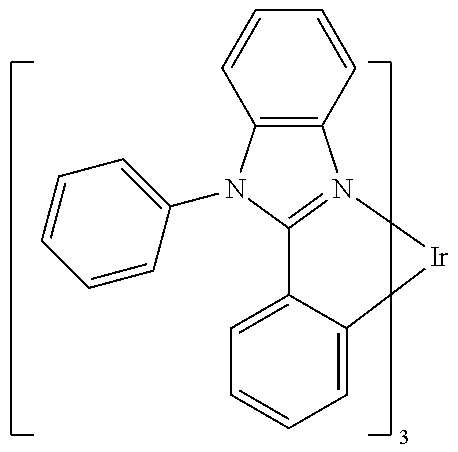
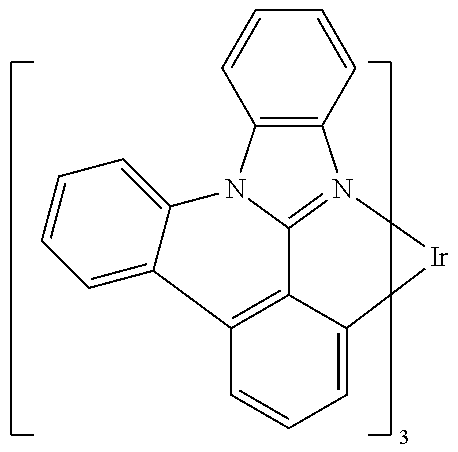
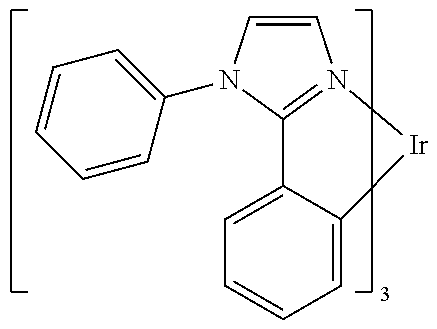
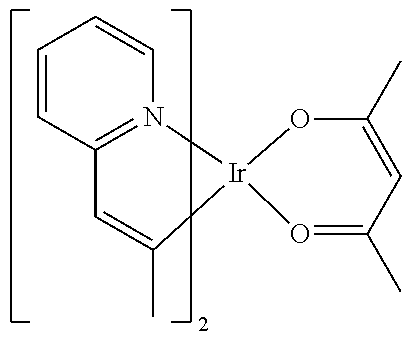
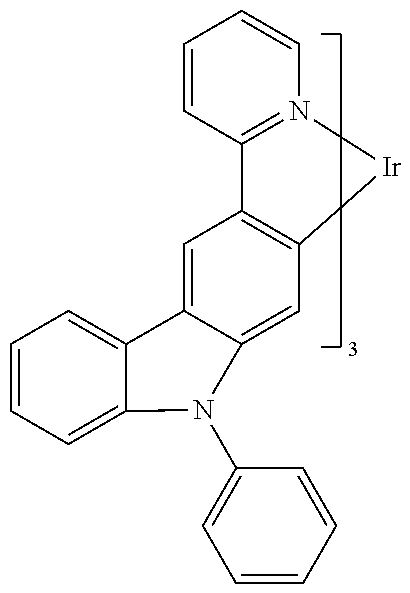
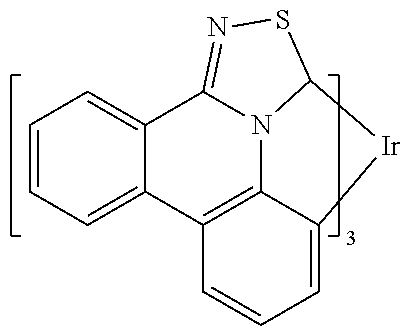
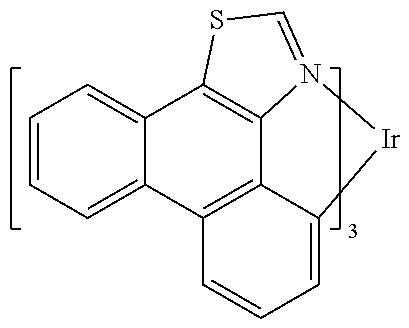
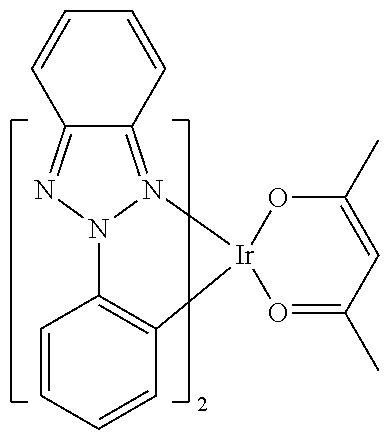
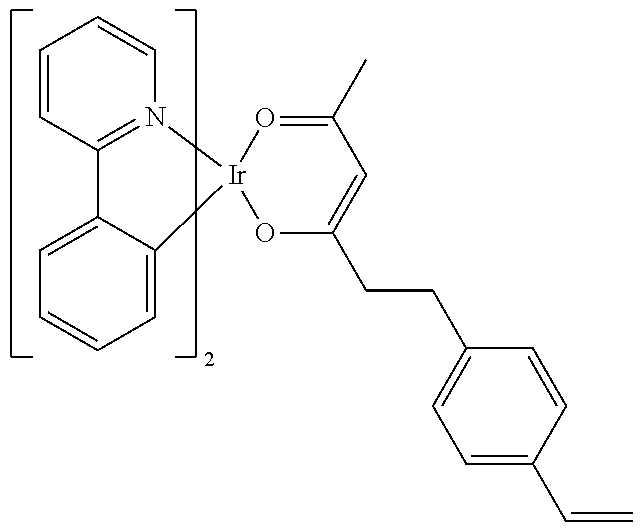
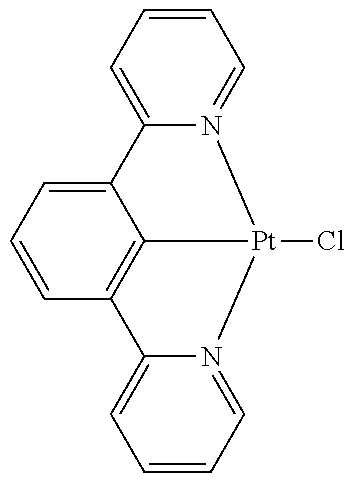
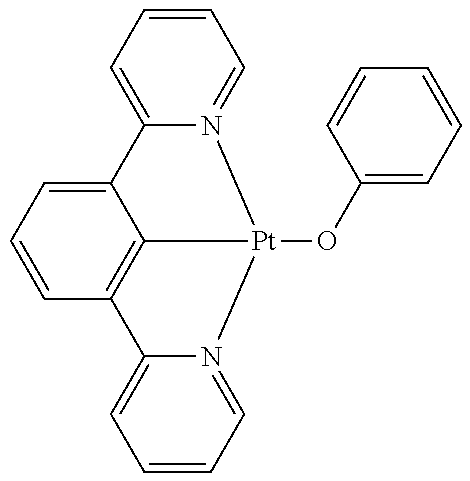
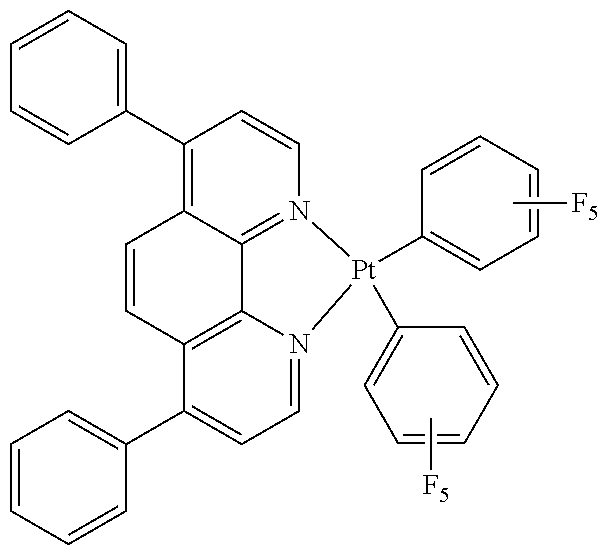
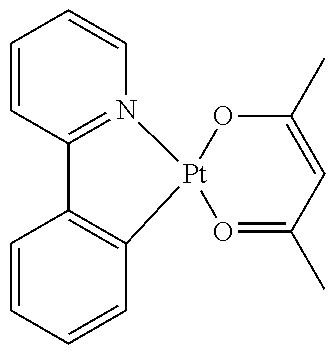
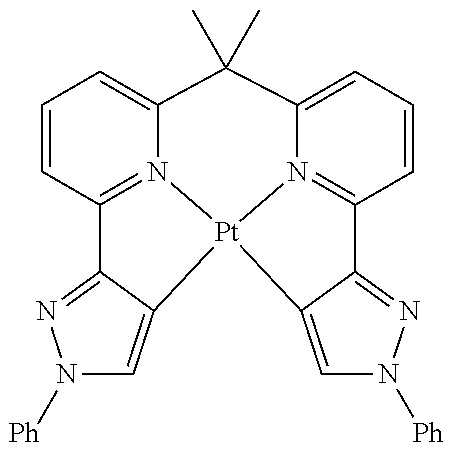
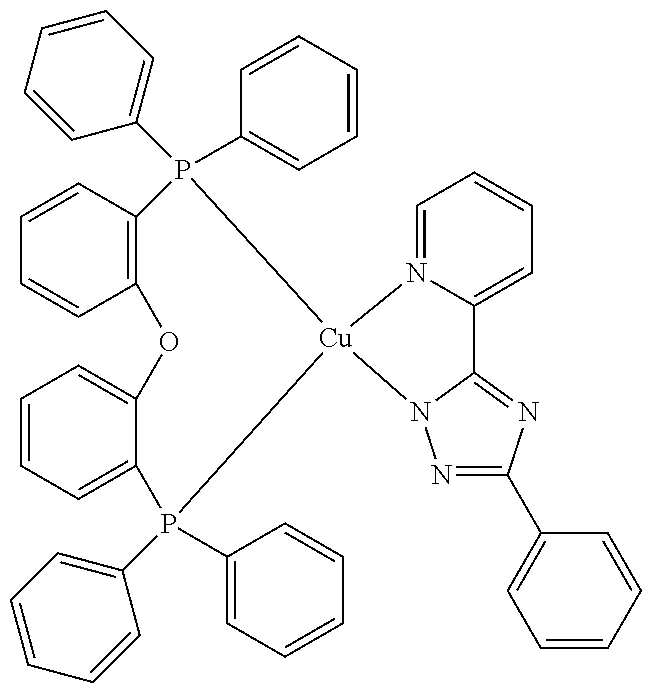
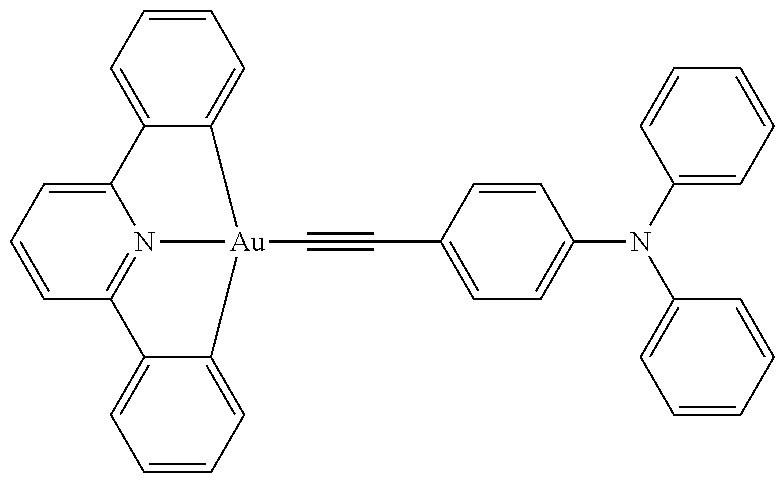
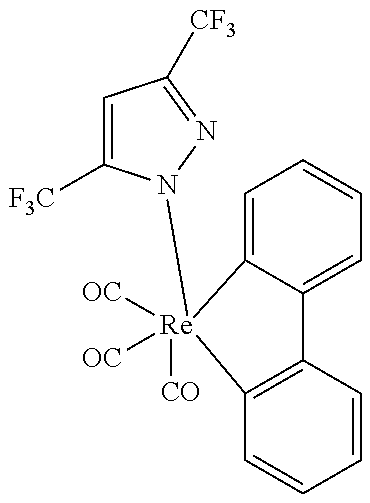
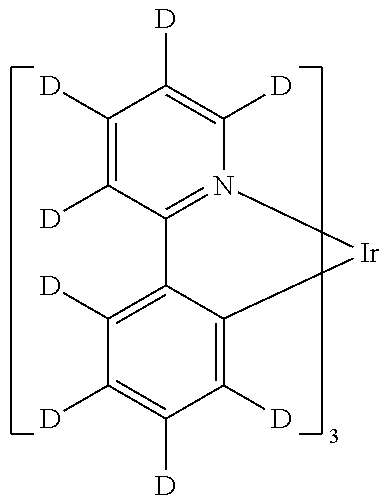
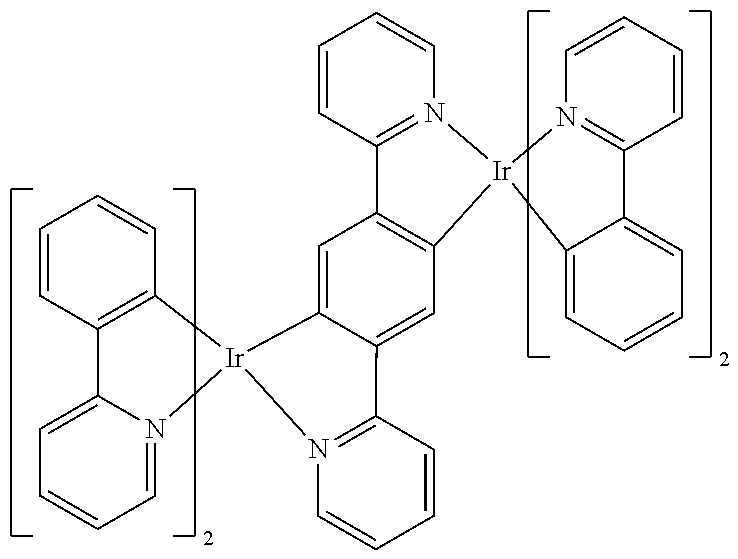
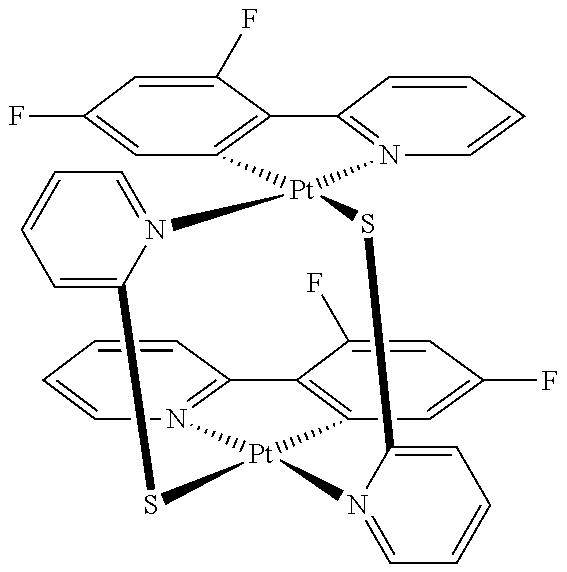
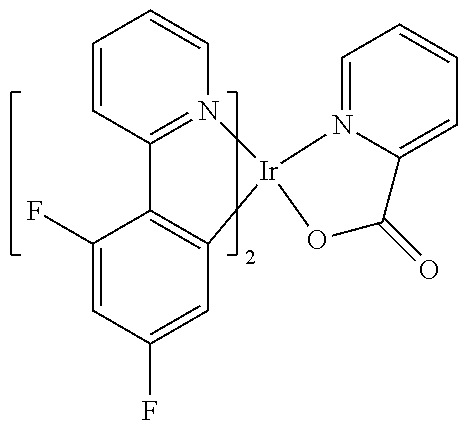
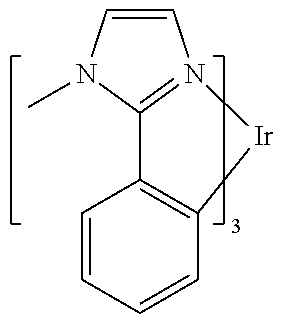
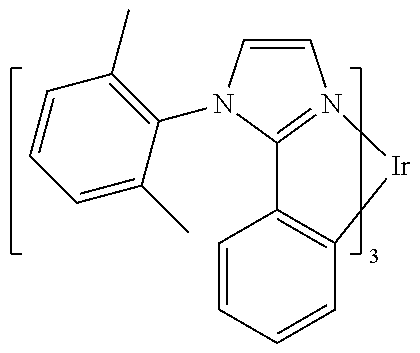
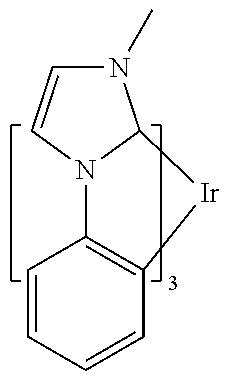
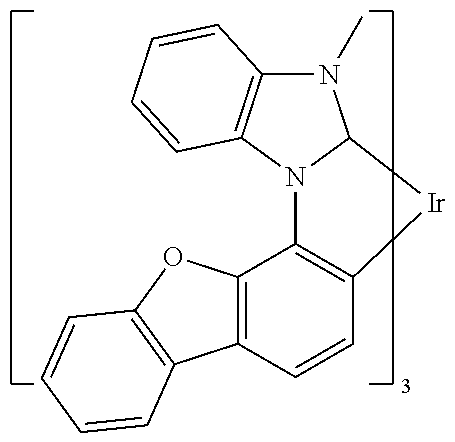
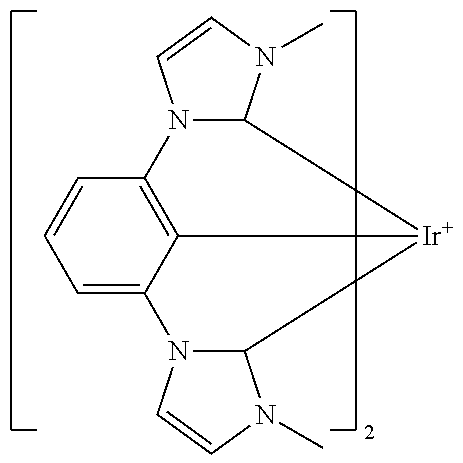
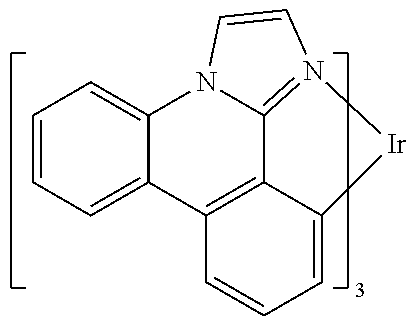
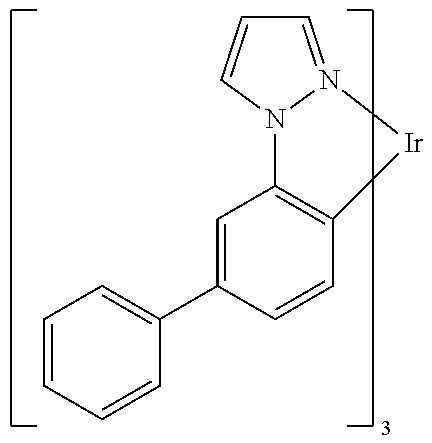
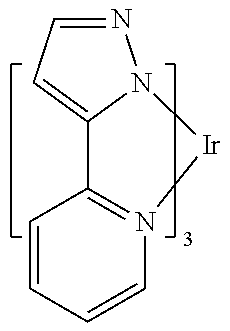
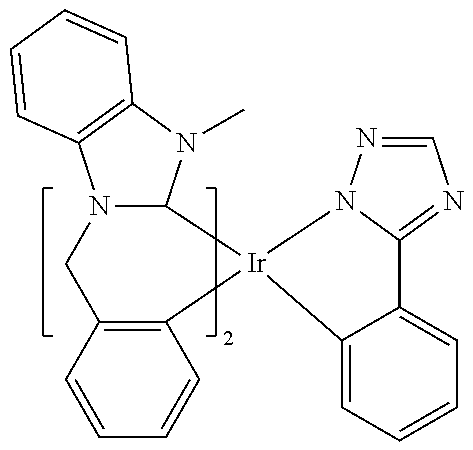
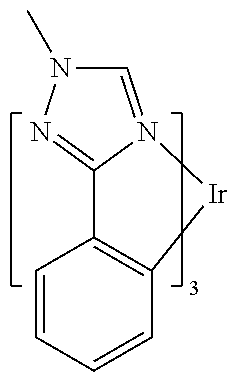
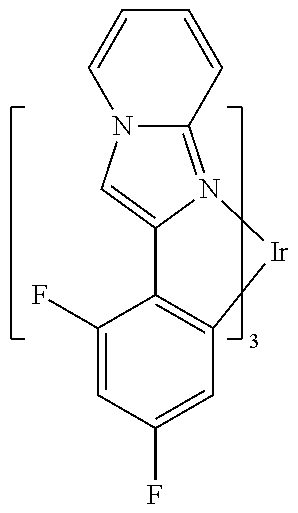
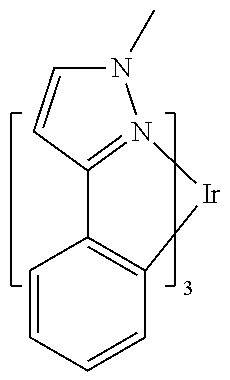
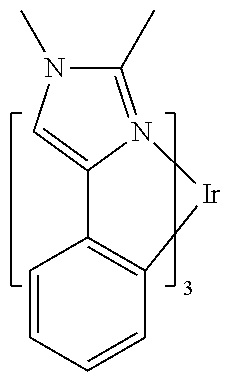
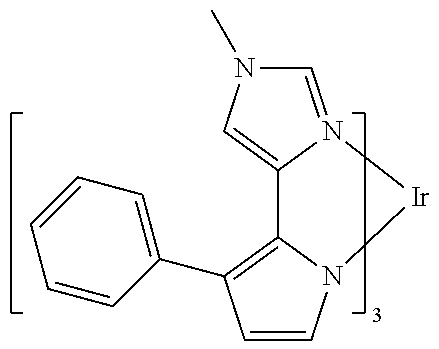
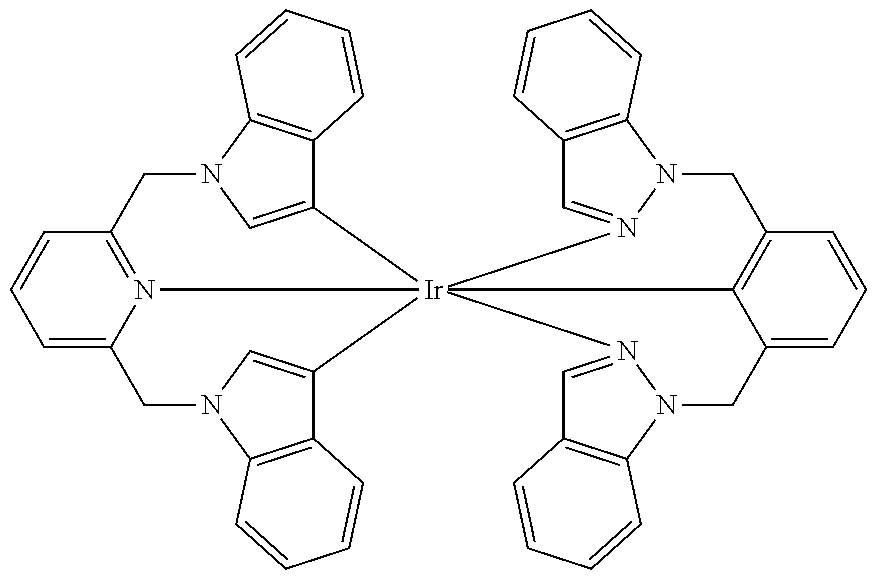
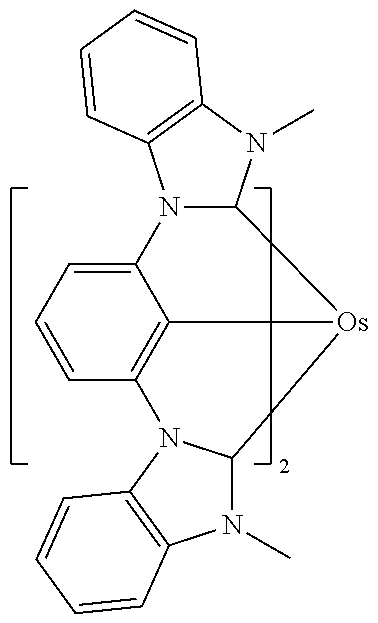
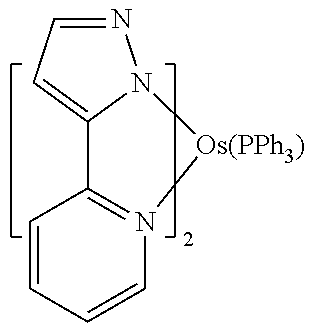

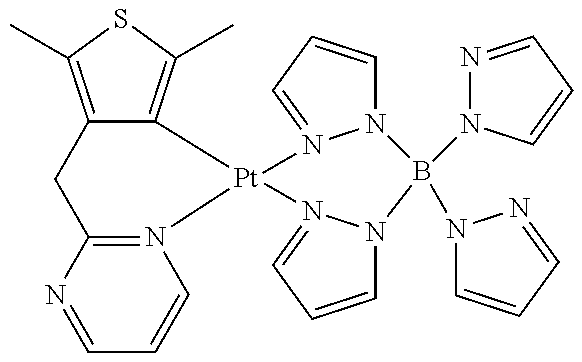
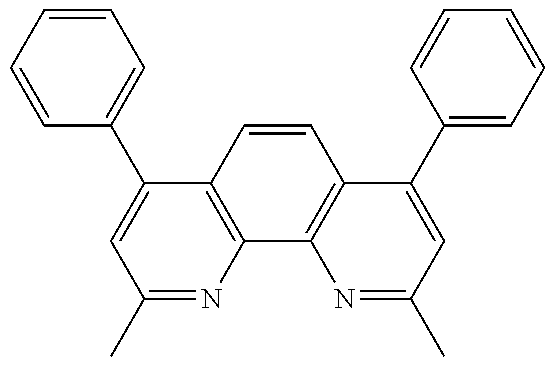
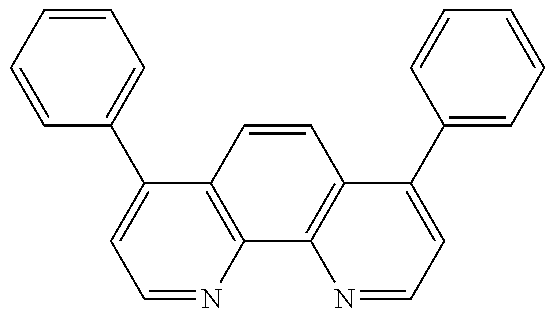
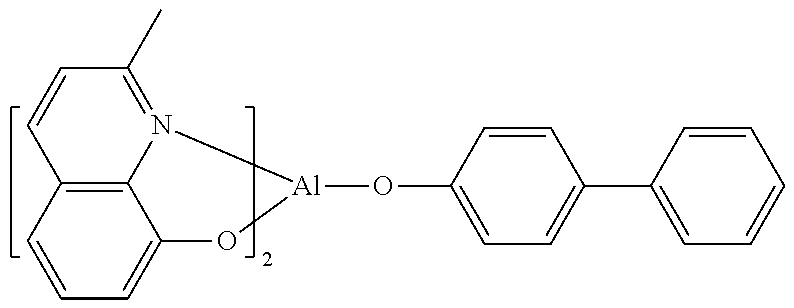
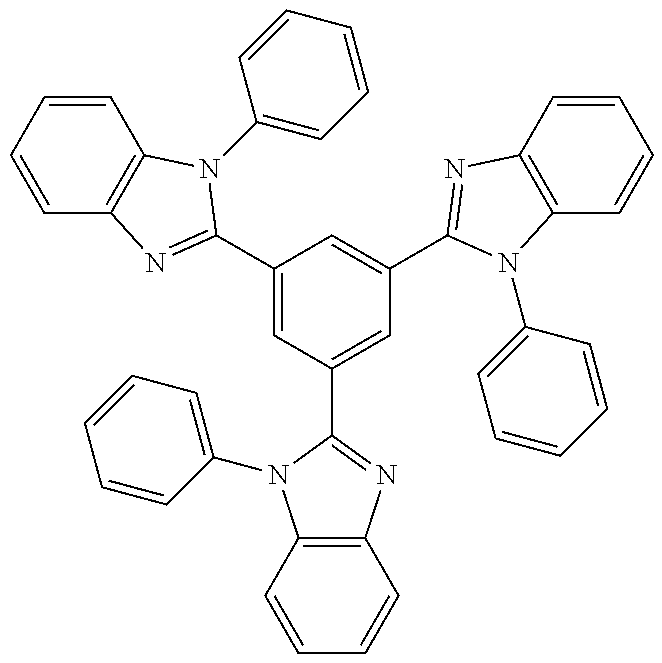
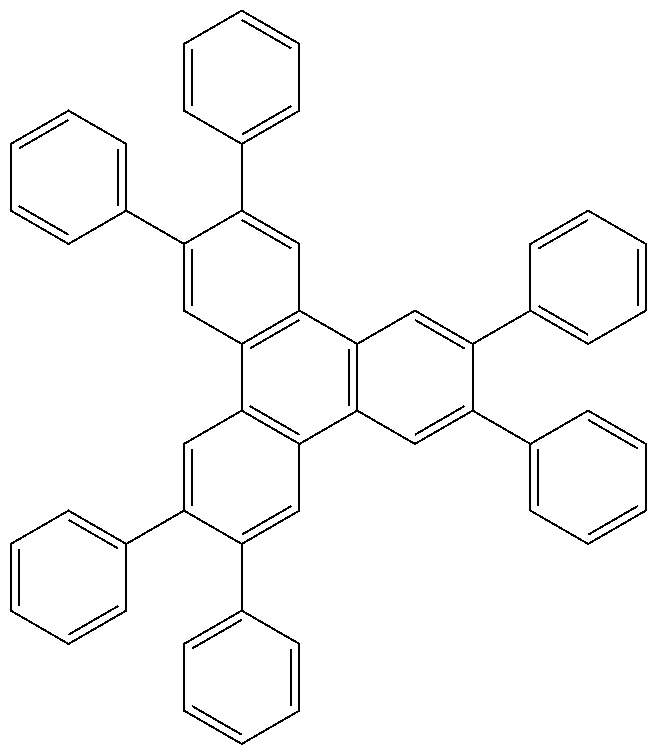
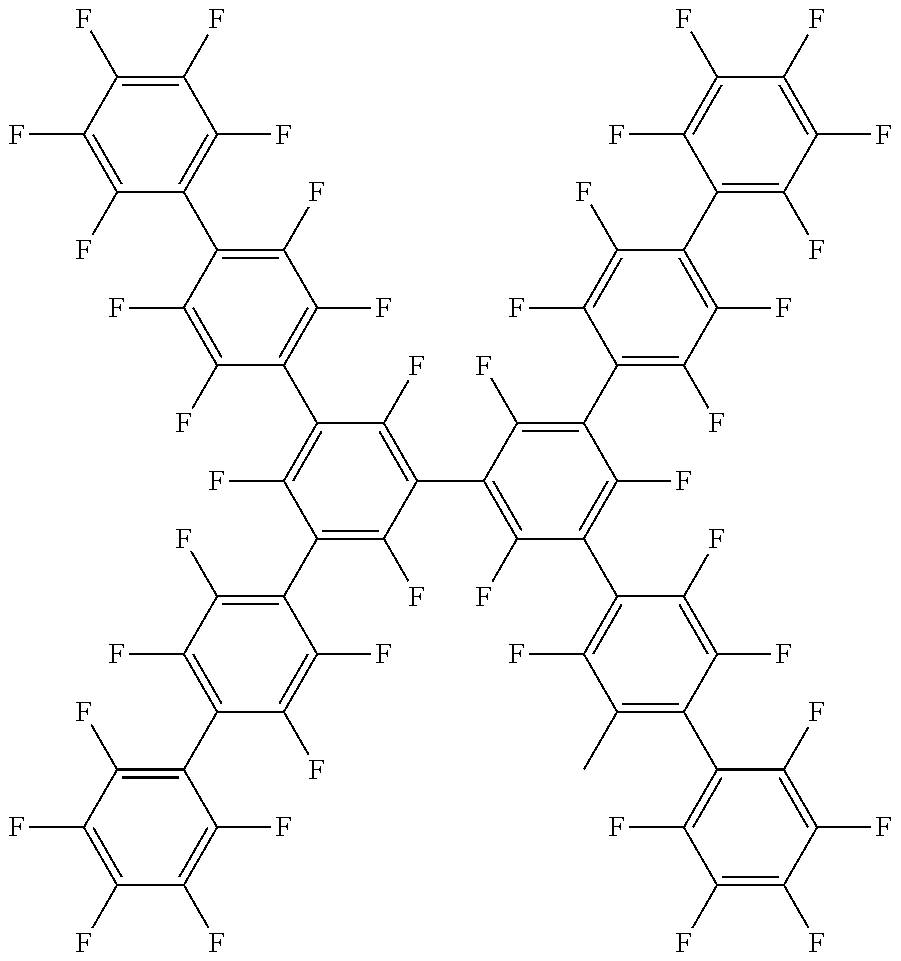

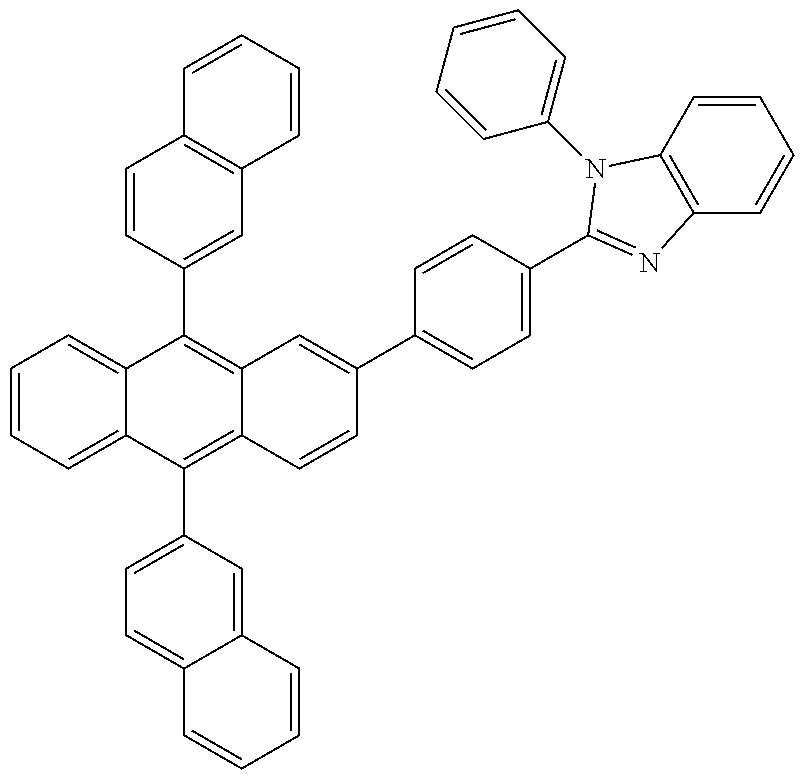
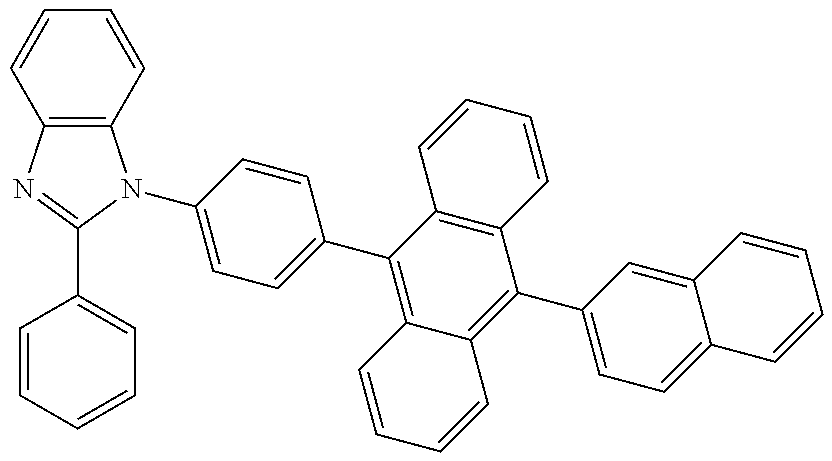
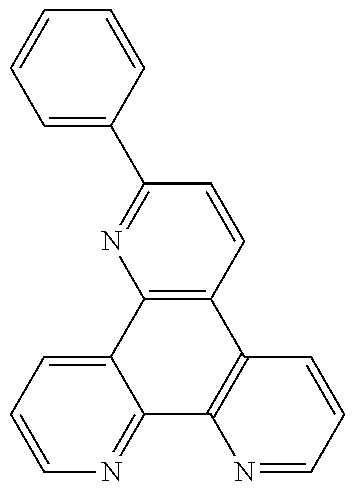

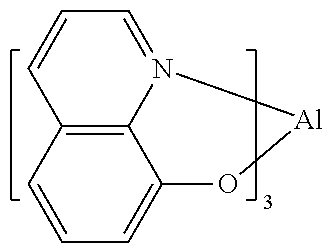
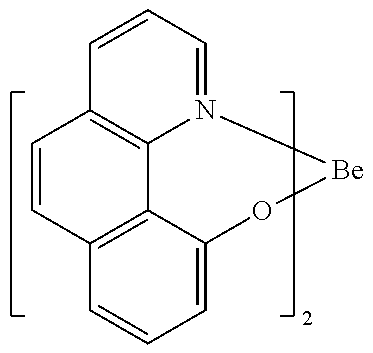
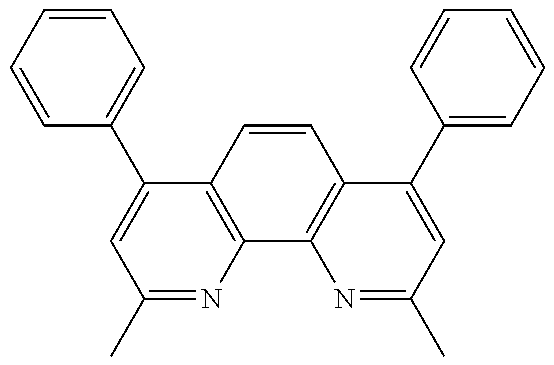
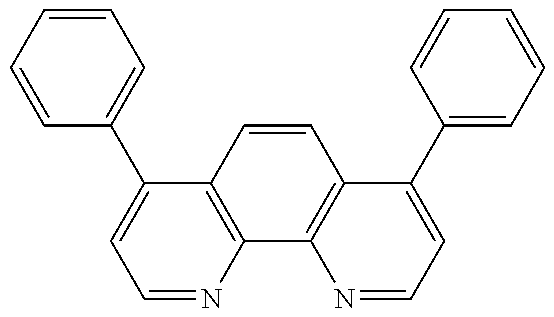
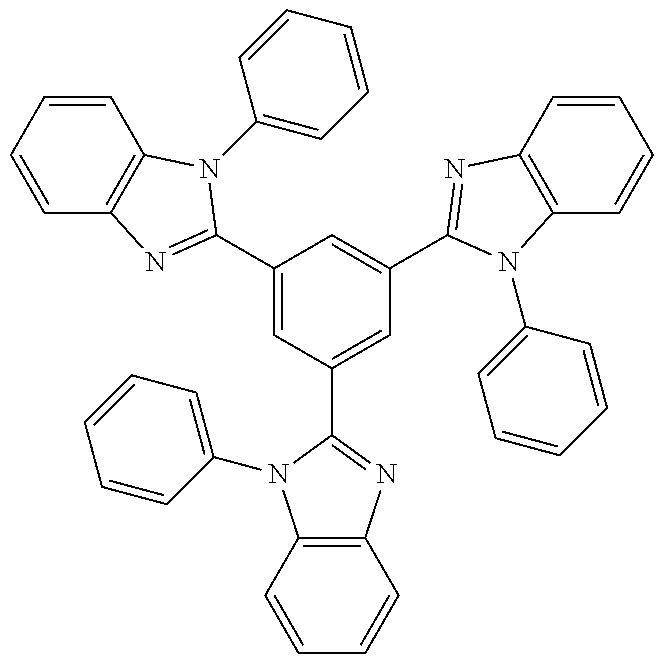

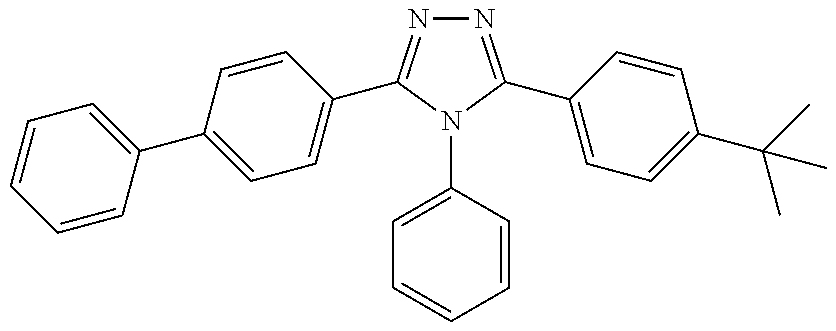
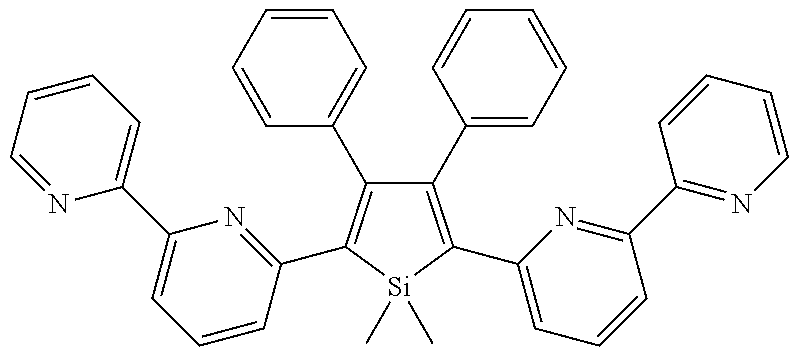
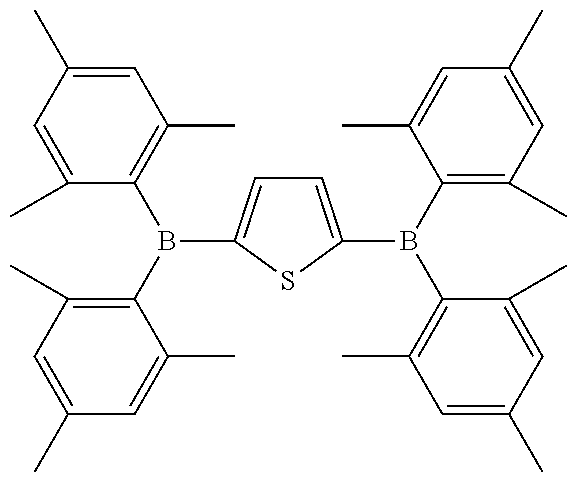

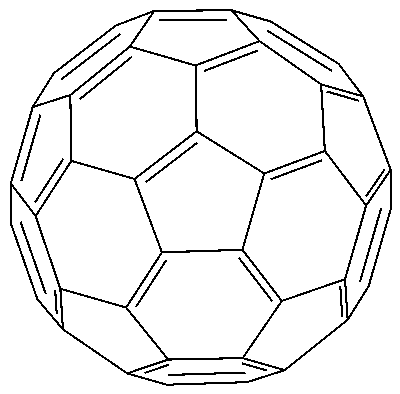
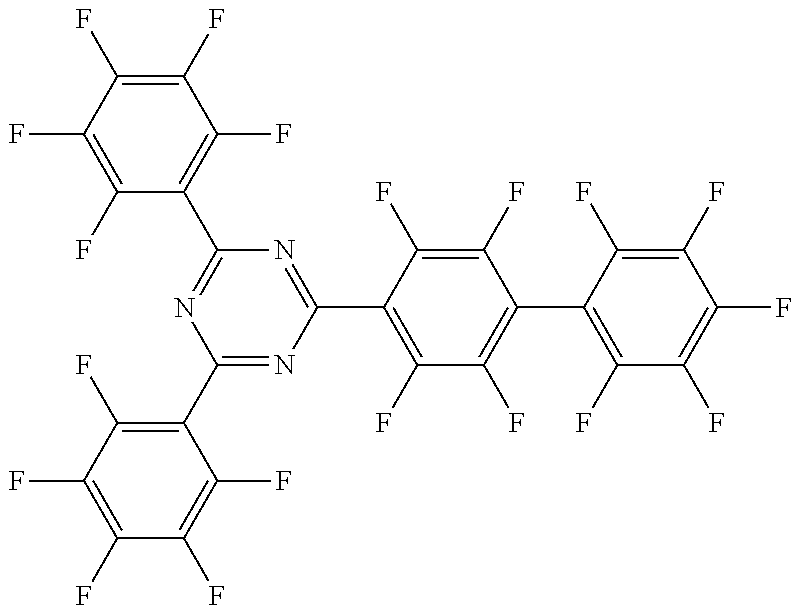
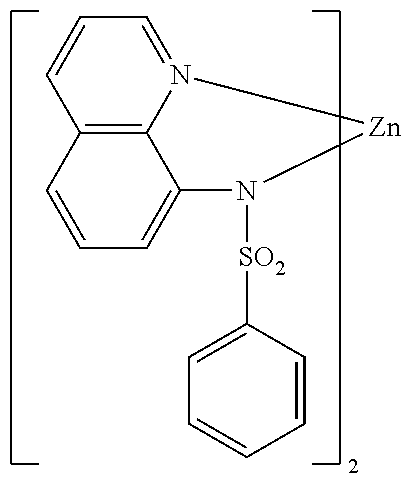

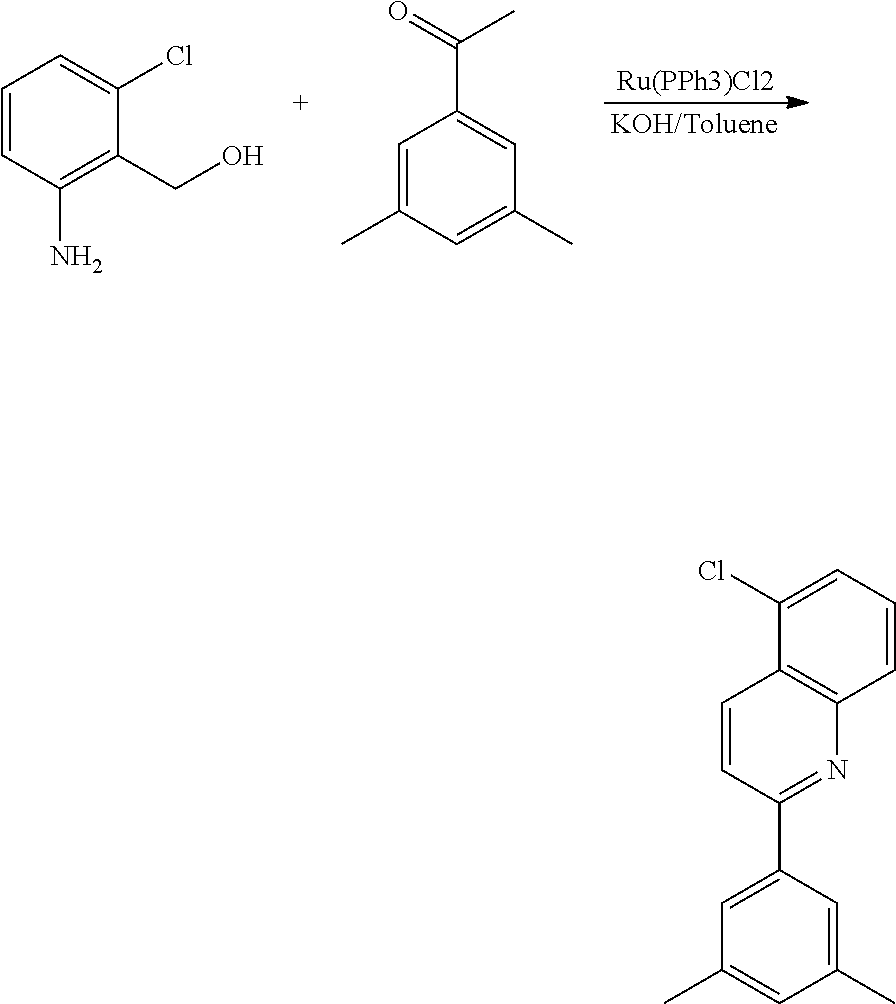
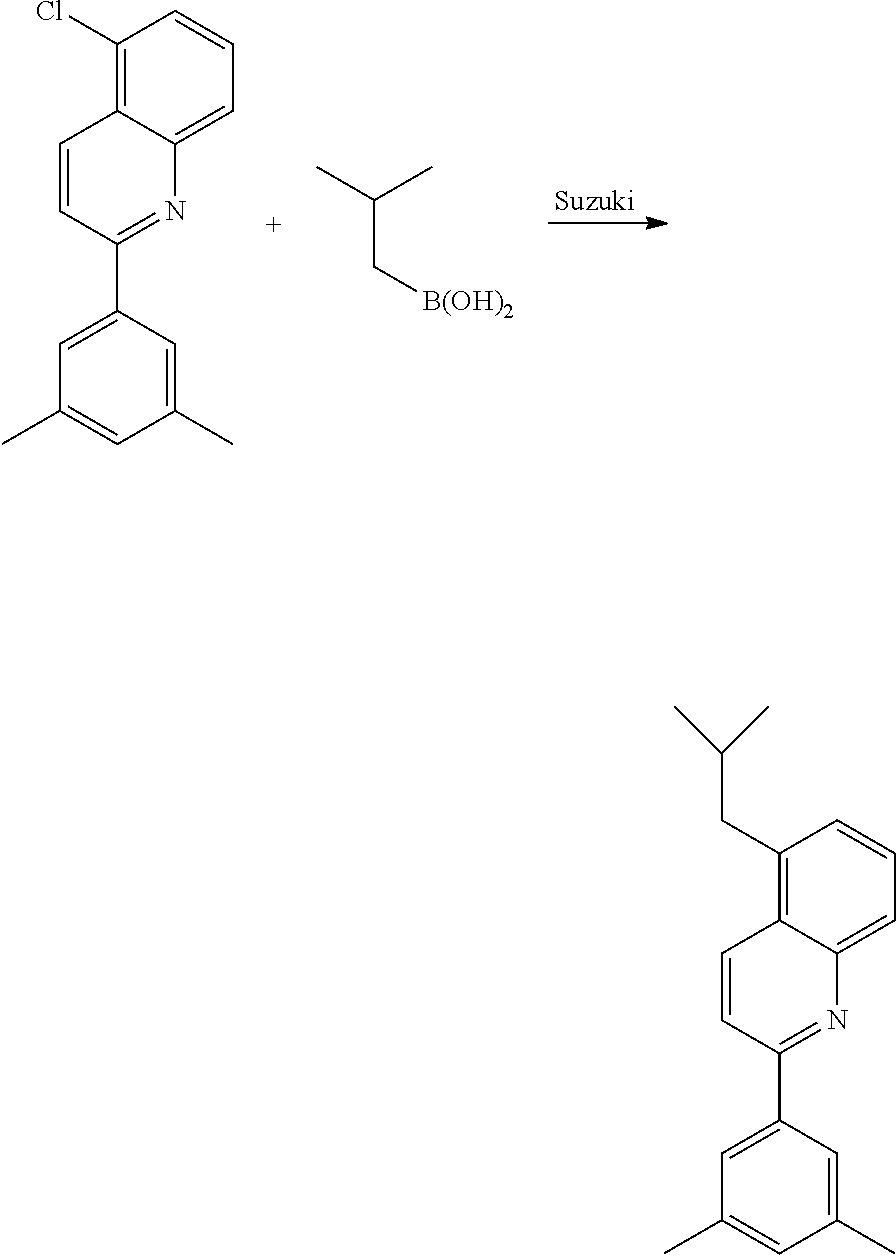
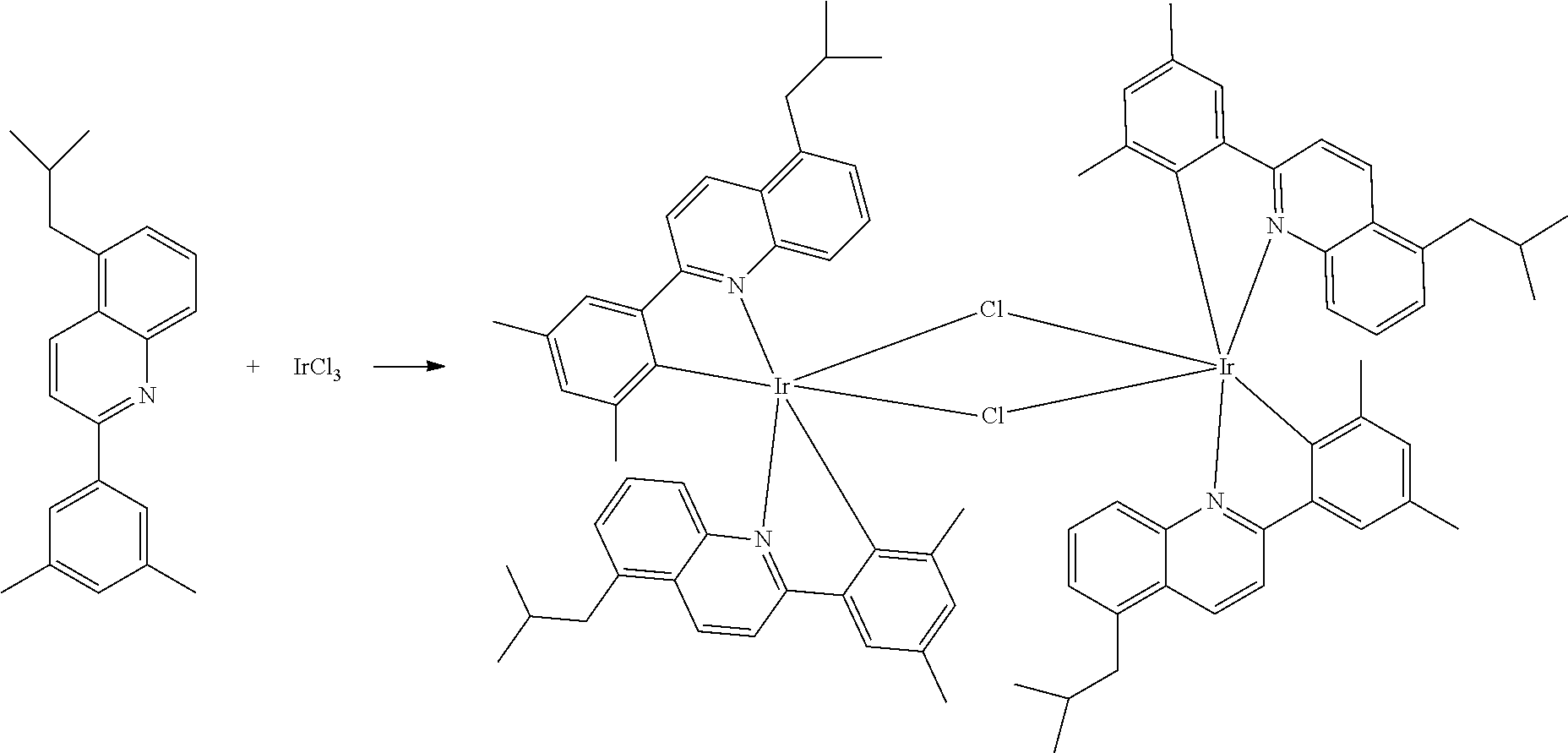
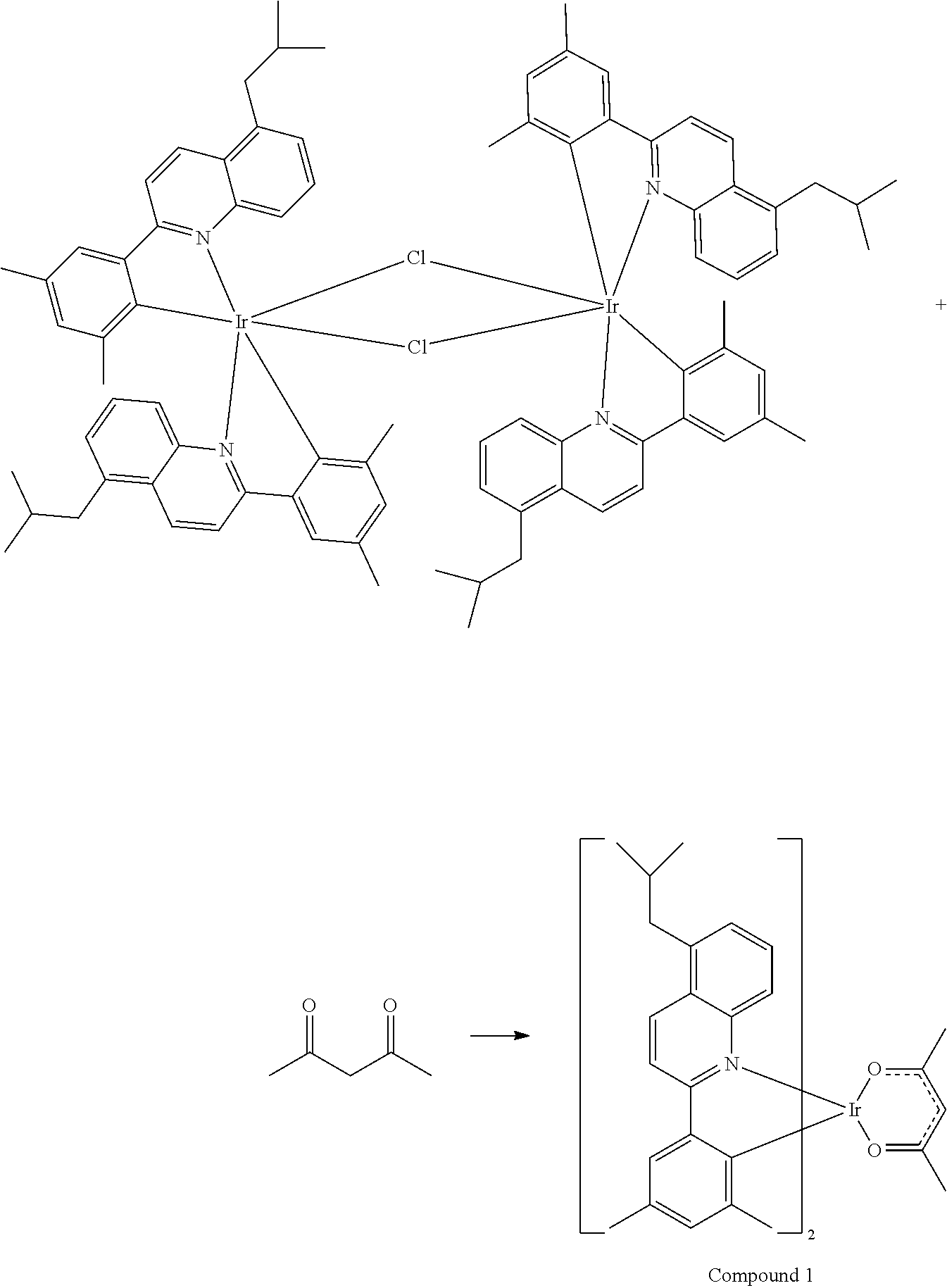
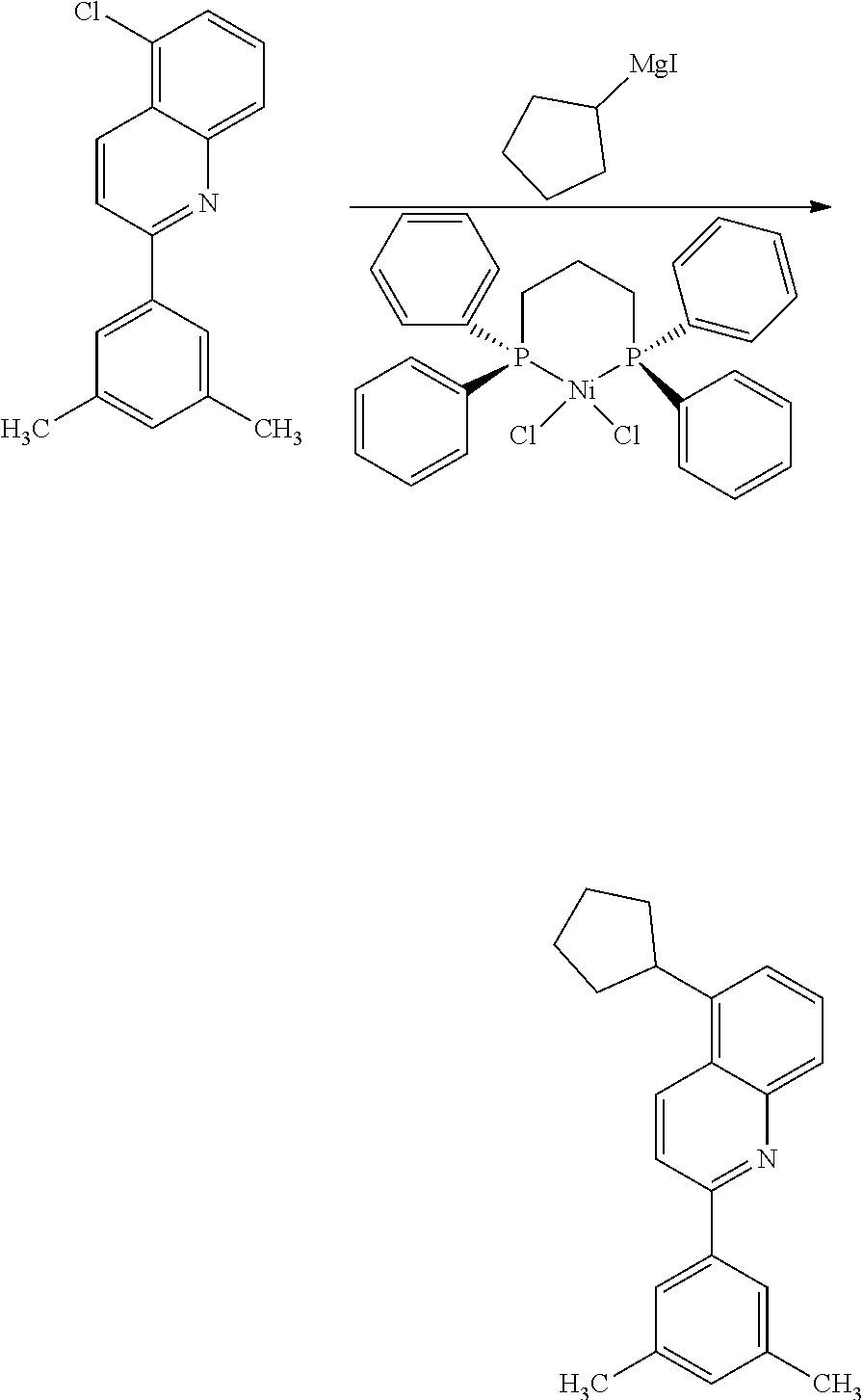

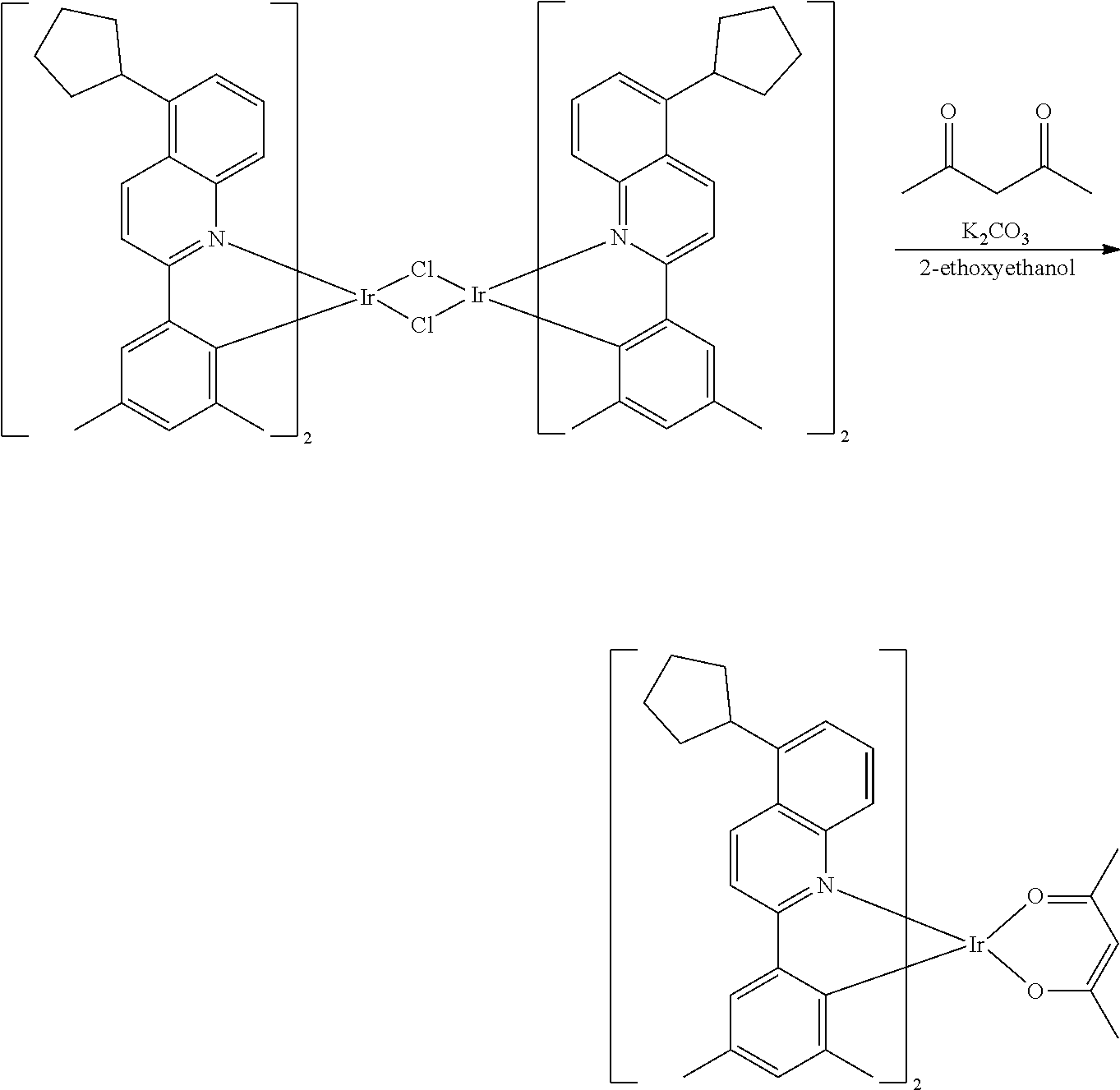
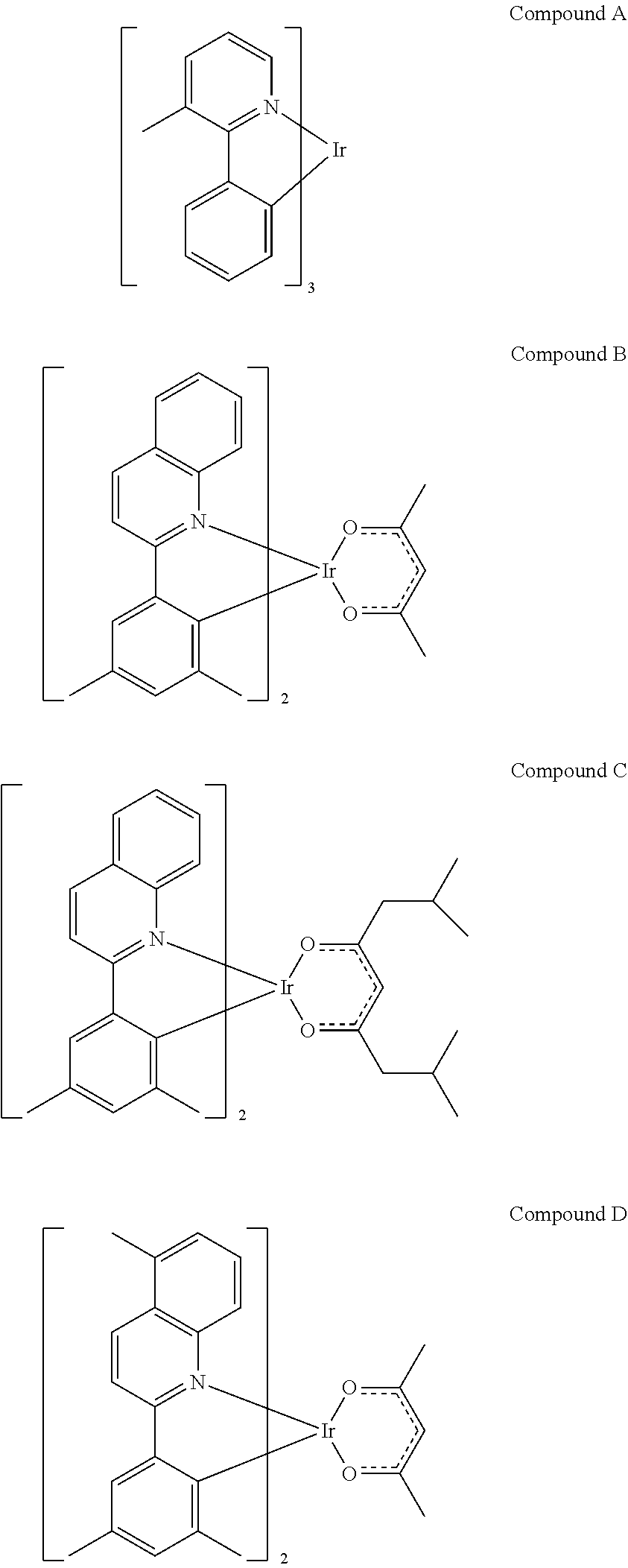
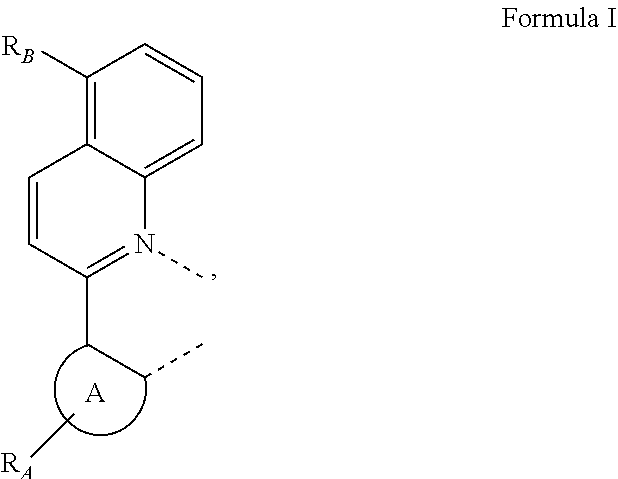
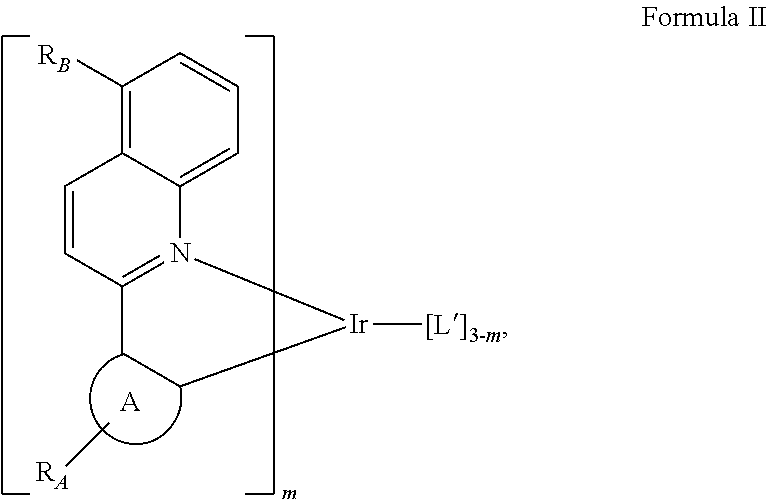
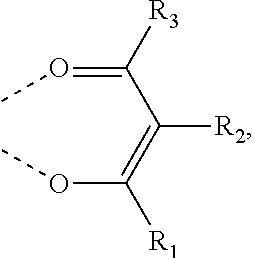
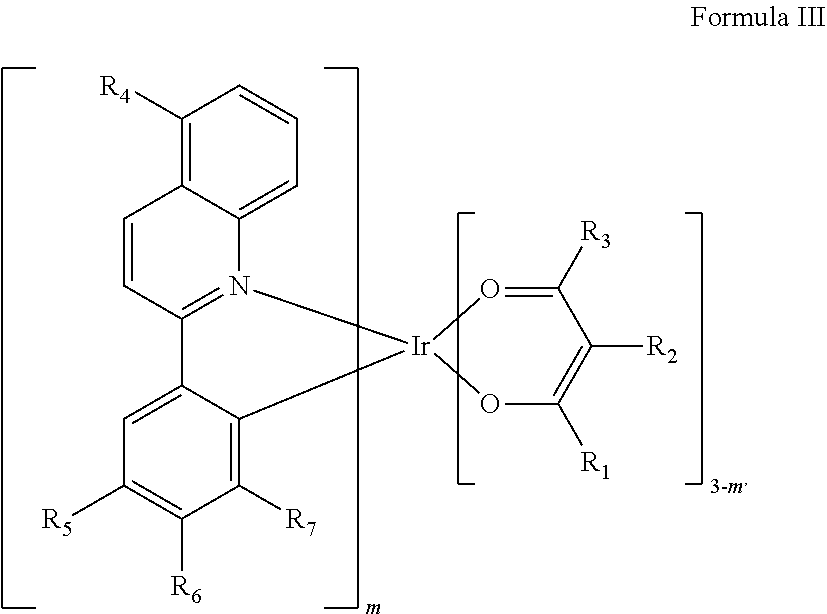












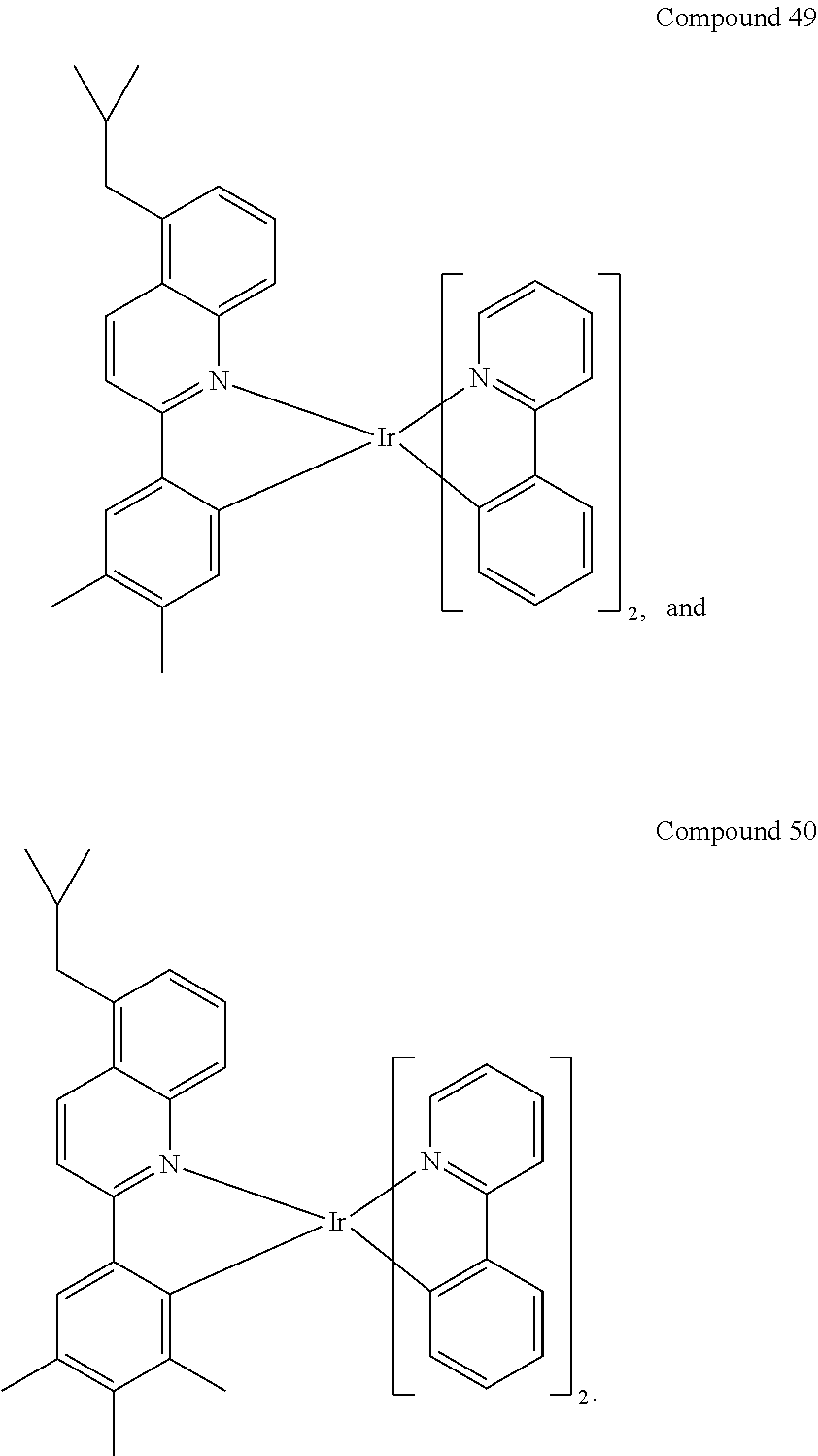
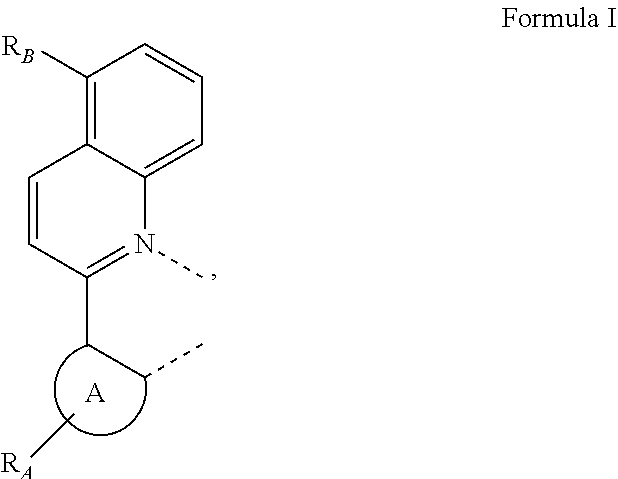












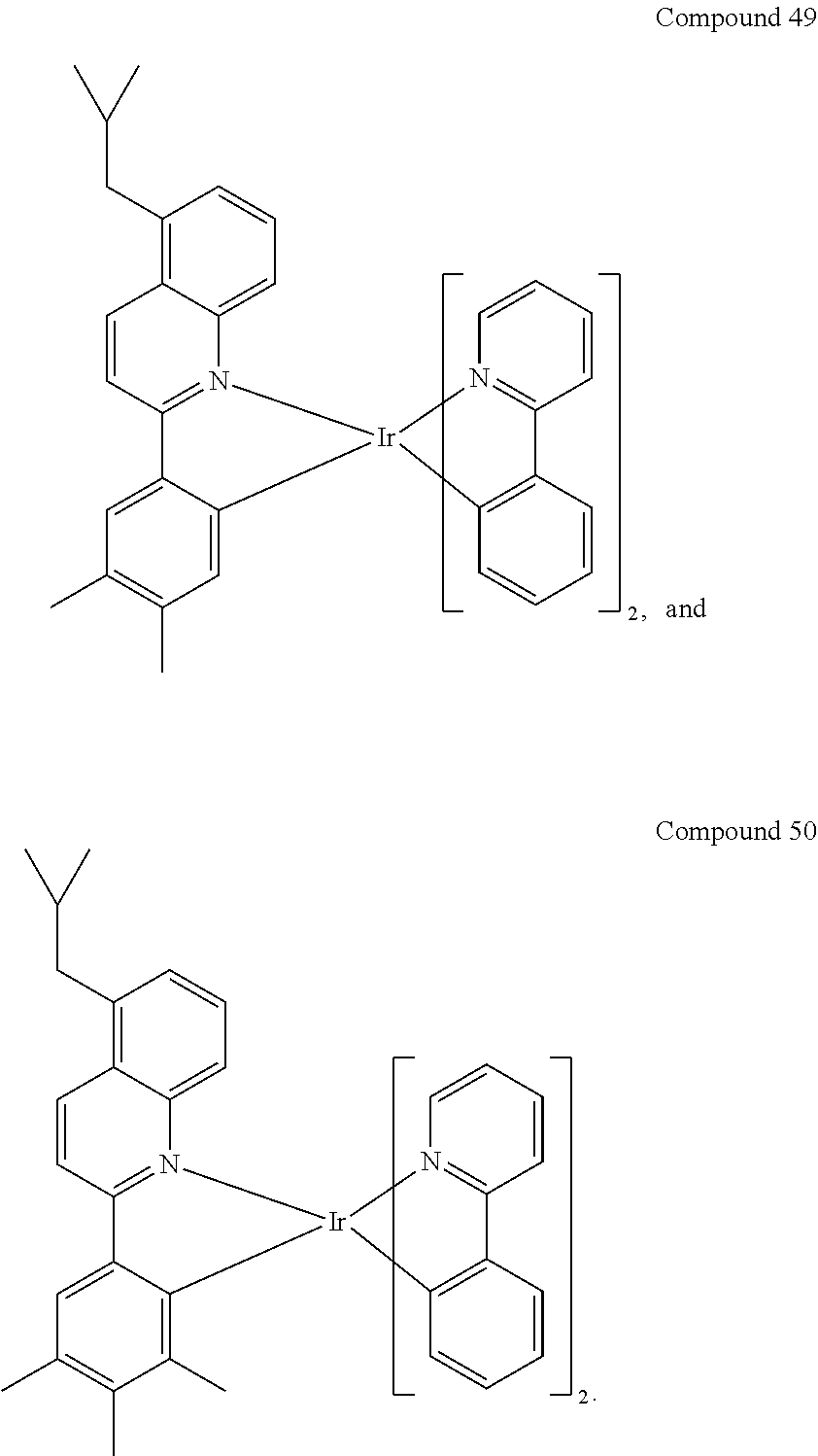
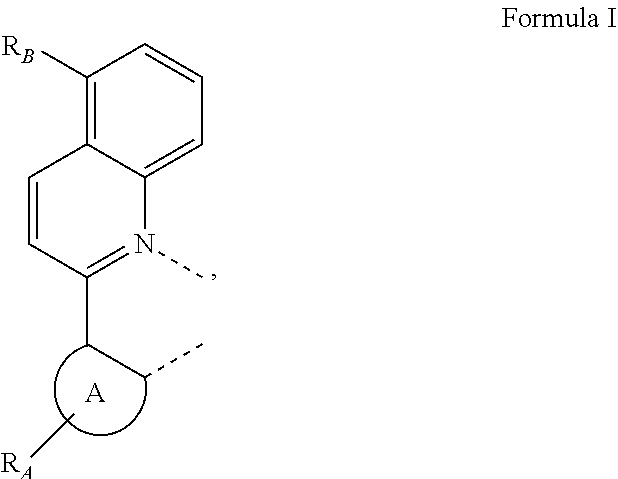
D00000
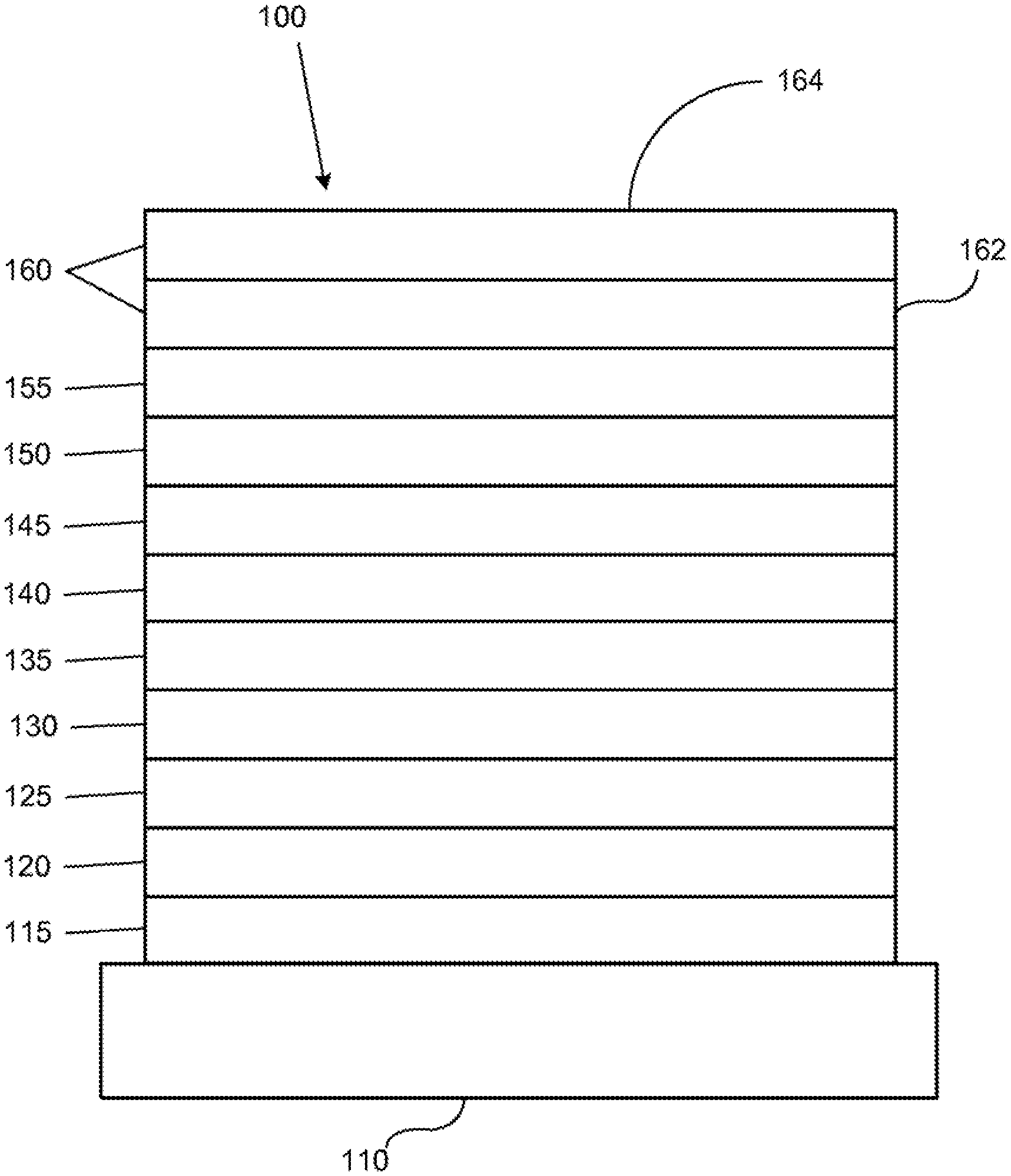
D00001
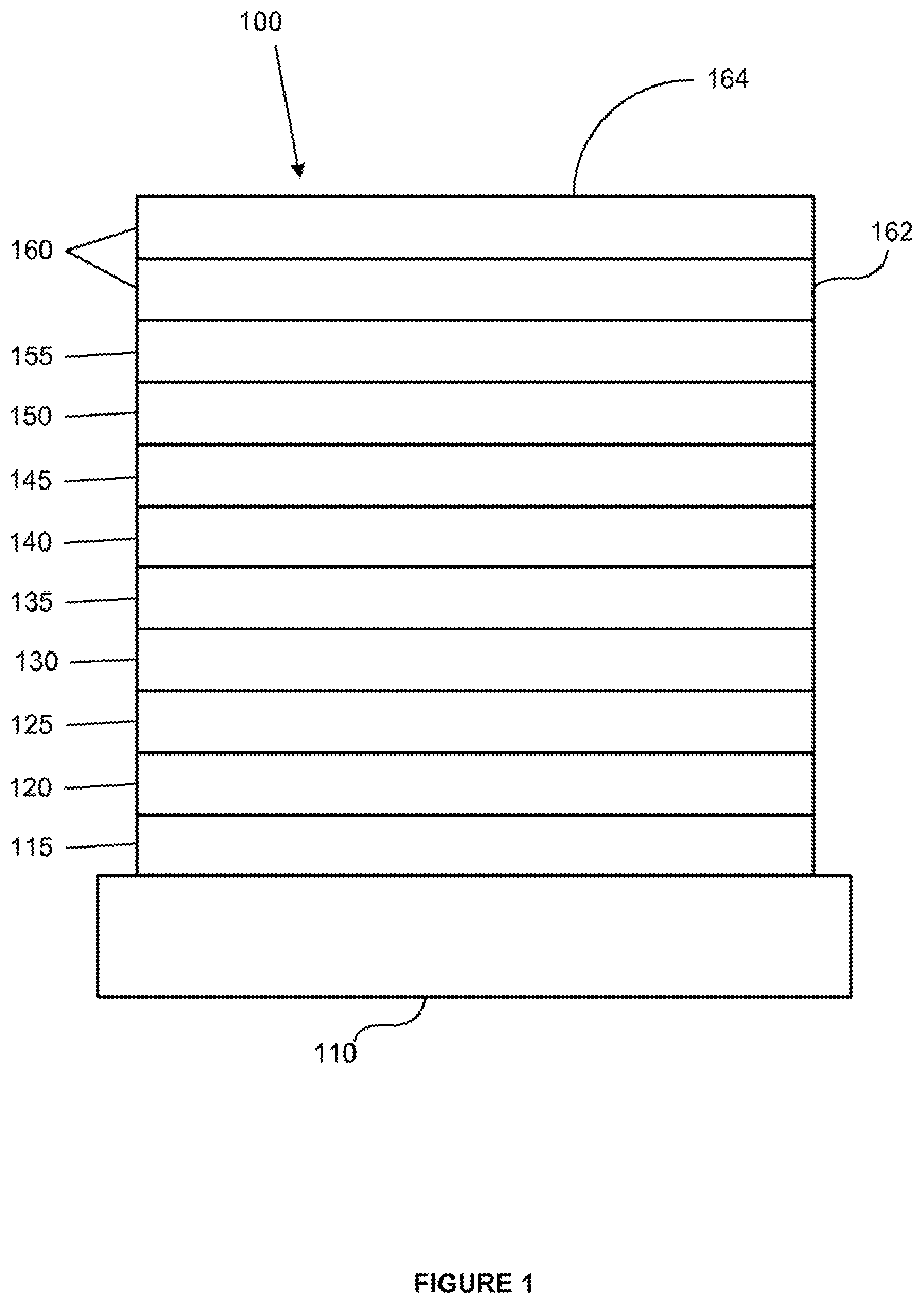
D00002
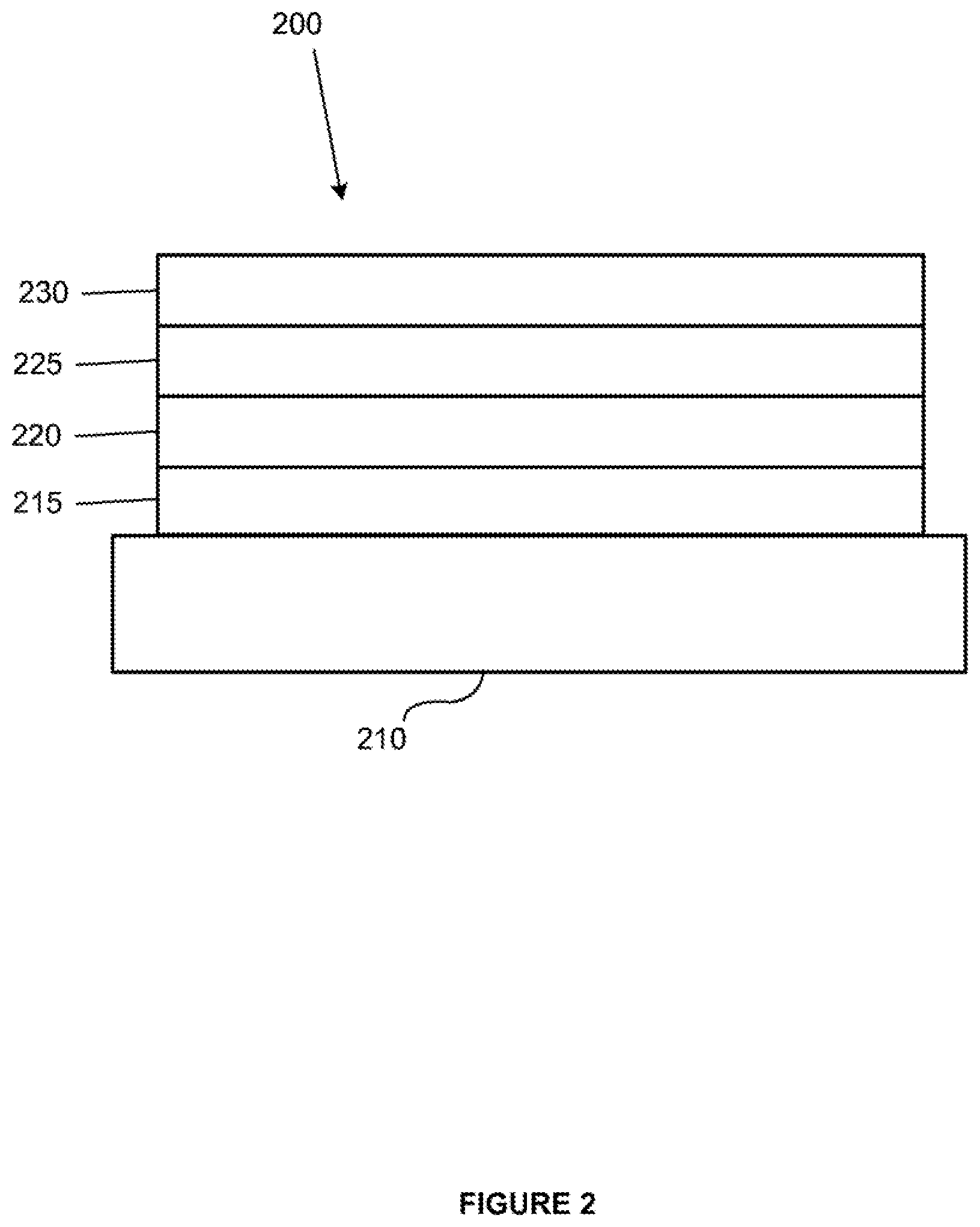
D00003
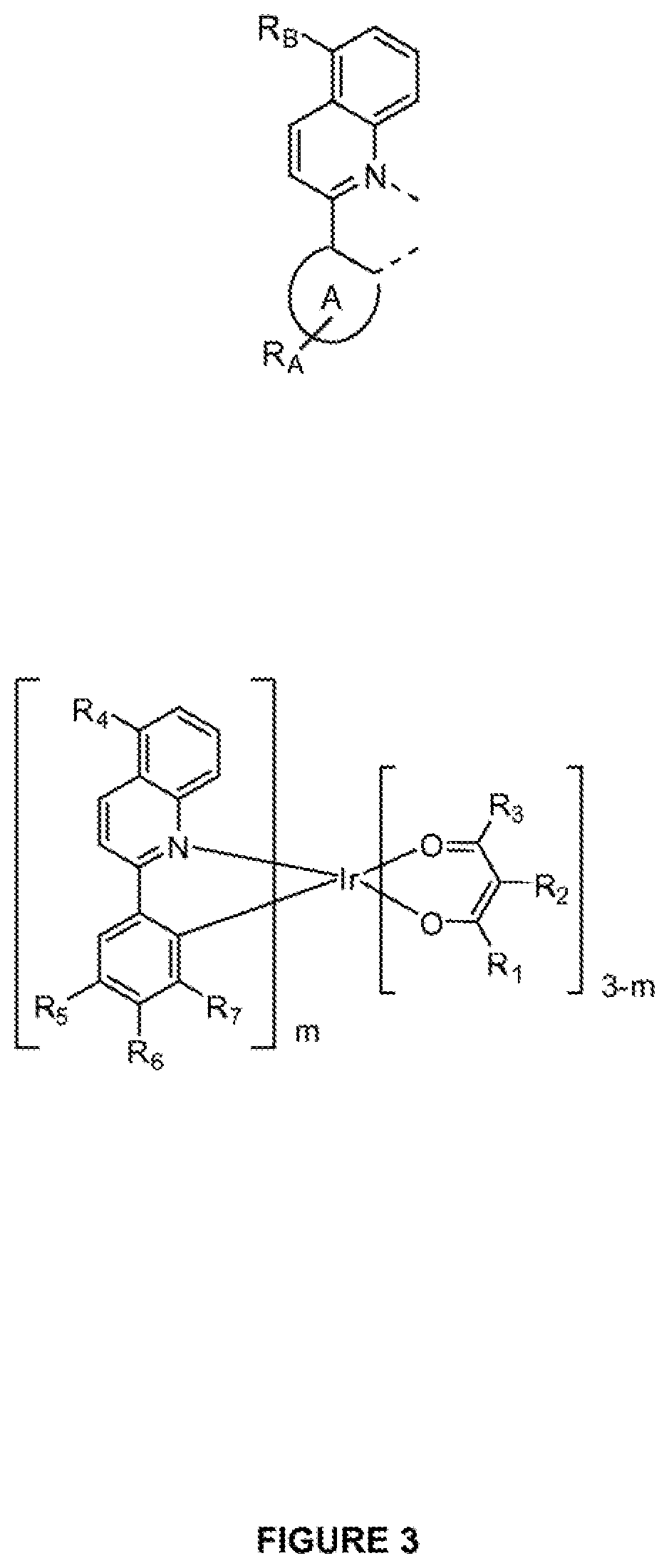
XML
uspto.report is an independent third-party trademark research tool that is not affiliated, endorsed, or sponsored by the United States Patent and Trademark Office (USPTO) or any other governmental organization. The information provided by uspto.report is based on publicly available data at the time of writing and is intended for informational purposes only.
While we strive to provide accurate and up-to-date information, we do not guarantee the accuracy, completeness, reliability, or suitability of the information displayed on this site. The use of this site is at your own risk. Any reliance you place on such information is therefore strictly at your own risk.
All official trademark data, including owner information, should be verified by visiting the official USPTO website at www.uspto.gov. This site is not intended to replace professional legal advice and should not be used as a substitute for consulting with a legal professional who is knowledgeable about trademark law.